Early Views of Hollywood (1920 +)
Historical Photos of Early Hollywood |
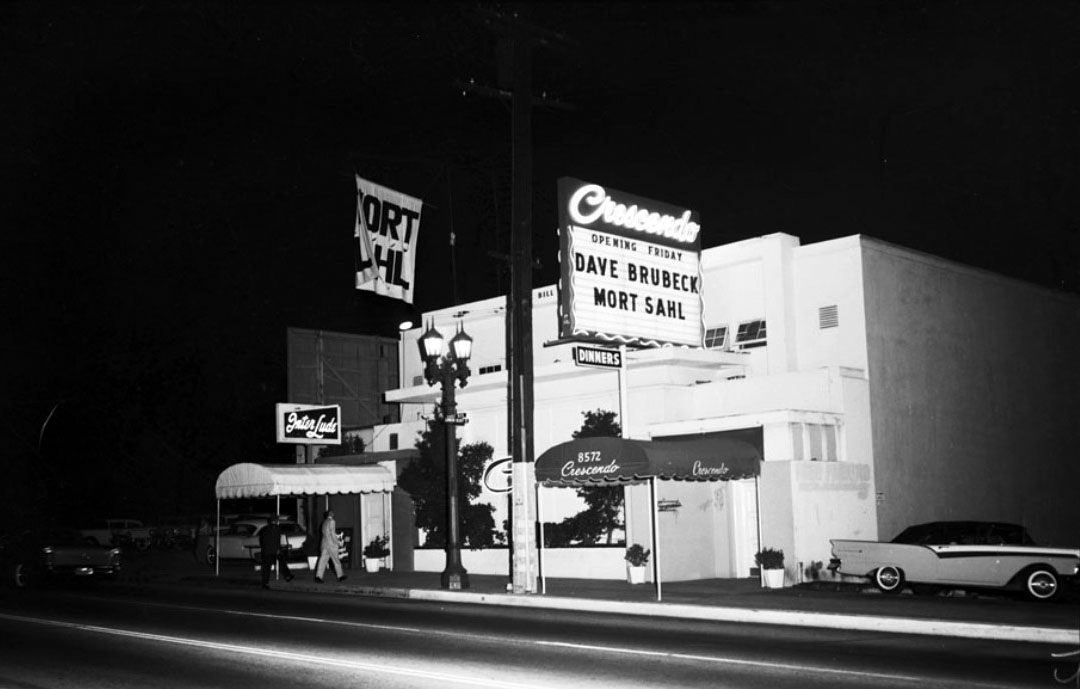 |
|
| (ca. 1958)***^^ – View showing the Crescendo Nightclub located at 8572 Sunset Boulevard on the Sunset Strip. The Marquis reads: Opening Friday – Dave Brubeck and Mort Sahl |
Historical Notes Gene Norman owned the Crescendo Nightclub (also the Interlude) on the Sunset Strip during the 1950s and 1960s featuring popular music and jazz. He also formed the GNP label which used many live recordings directly from the Crescendo Club. Norman featured virtually every record and cabaret star such as Johnny Mathis, Duke Ellington, Louis Armstrong, Count Basie, Bob Newhart an Ella Fitzgerald. The typical Crescendo show was Mort Sahl, The Dave Brubeck Quarter, June Christy and the Stan Kenton Band. During all that time he was producing jazz albums, both in clubs and in the studio.*^*^^ |
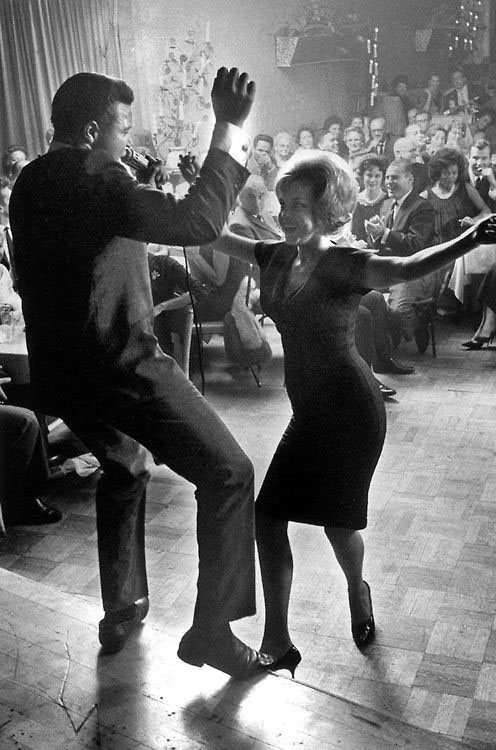 |
(1961)#^#* - Chubby Checker, originator of 'The Twist', dancing with audience member at the Crescendo Nightclub, Hollywood.
|
Historical Notes Chubby Checker (born Ernest Evans) is widely known for popularizing the twist dance style, with his 1960 hit cover of Hank Ballard's R&B hit "The Twist". In September 2008 "The Twist" topped Billboard's list of the most popular singles to have appeared in the Hot 100 since its debut in 1958, an honor it maintained for an August 2013 update of the list. He also popularized the Limbo Rock and its trademark limbo dance, as well as various dance styles such as the fly.*^ |
Dino’s Lodge (77 Sunset Strip)
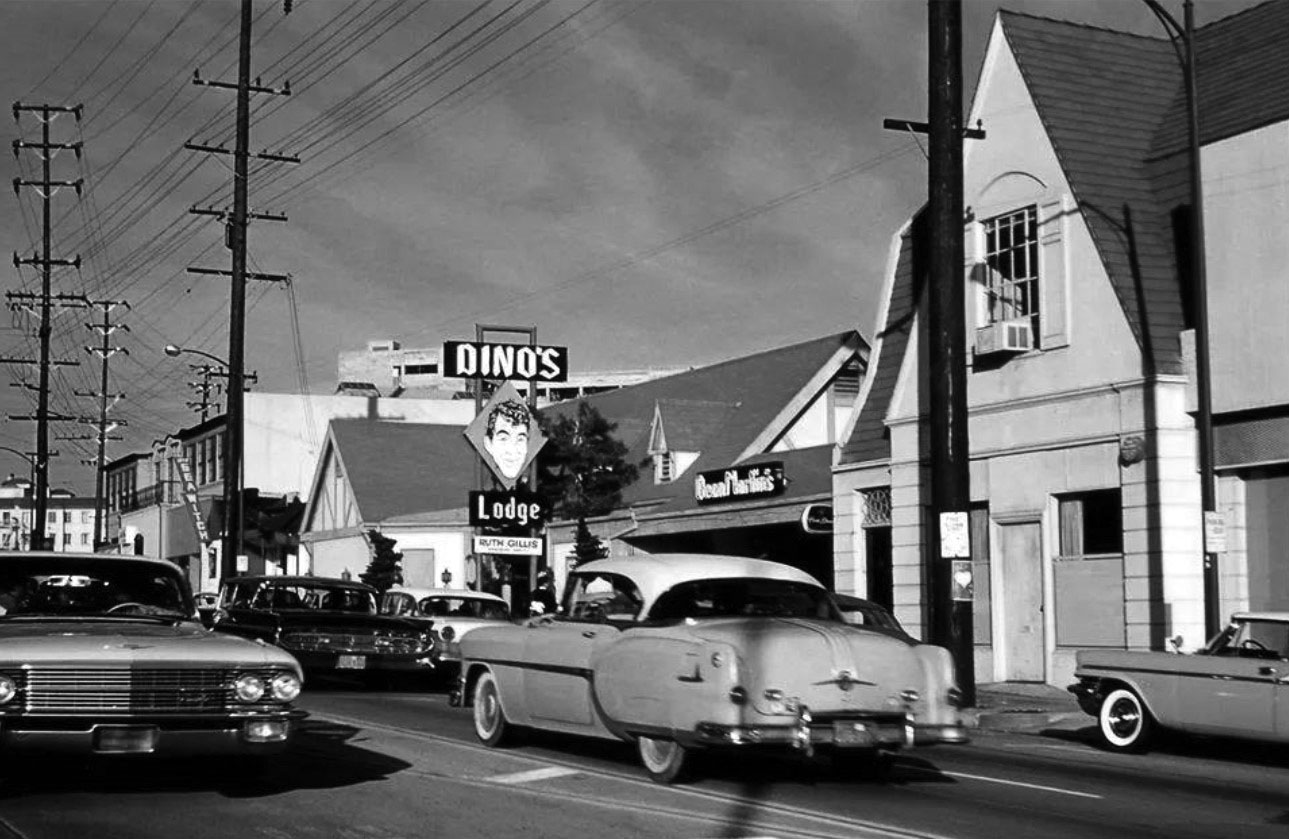 |
|
| (1962)* - View of Dino’s Lodge, located at 8532 Sunset Boulevard. |
Historical Notes The address of 8532 Sunset had been home to an auction house in the nineteen forties, one that specialized in wooden furniture. By the early fifties the space had been renamed, remodeled and opened as a dining spot called the Alpine Lodge. The family restaurant had a loosely defined wooden shoe concept and was not particularly successful. Described as "an attractive Swiss restaurant which fell on hard times," the owners soon dropped the word Alpine and replaced it with the name Dino, while leaving much of its decor intact. Dino's Lodge had its grand opening in the spring of 1958. When the strange sketch that became the memorable sign was raised to the sky, its base cemented to the ground and the switch turned on, most assumed this meant it was Dean Martin's restaurant. Of course, this is exactly what the owners of the former Alpine wanted. "Contrary to report," explained an April 1958 edition of the Los Angeles Times, "Dean Martin does not own the restaurant on the Strip ... They just use his name and give him a percentage." It was a large percentage. Fifty percent. * |
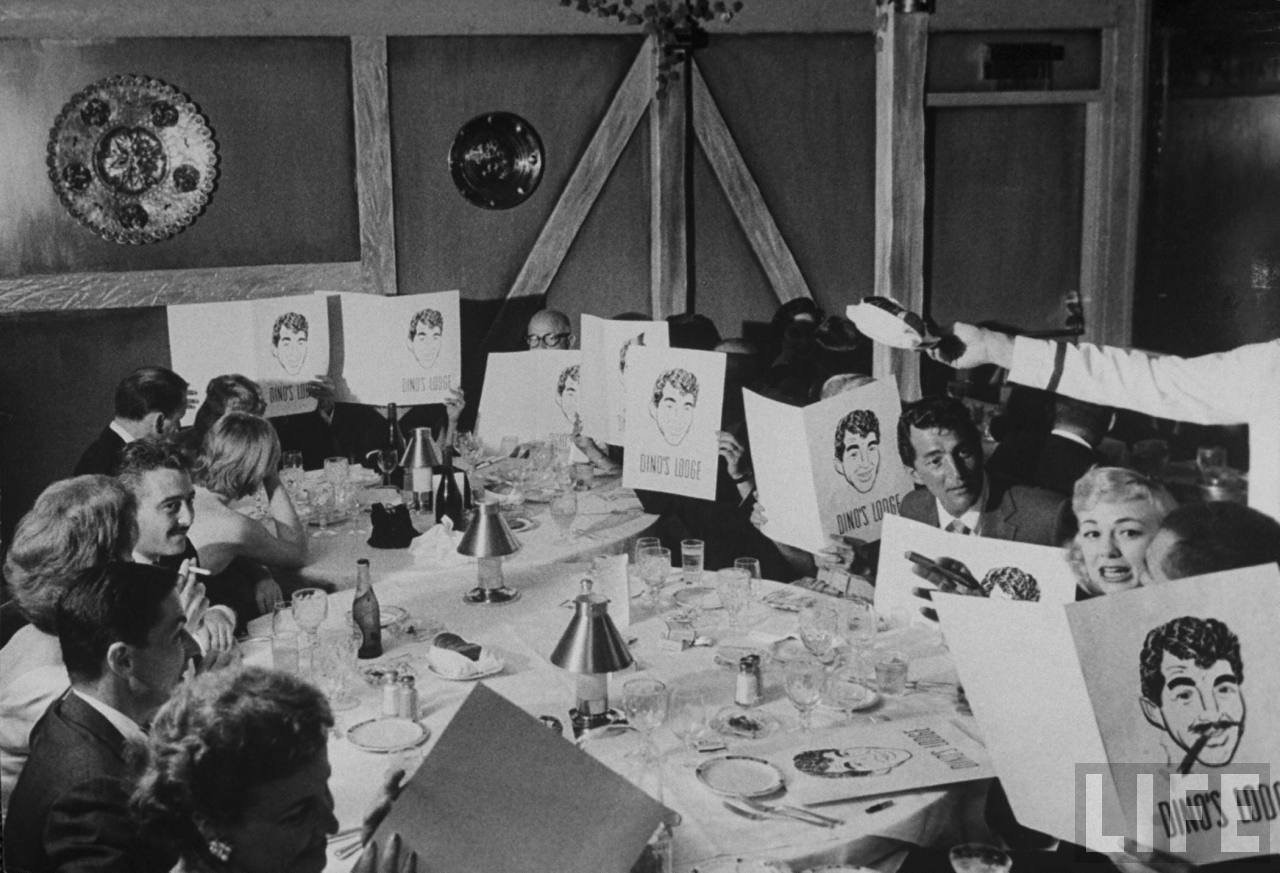 |
|
| (1960s)* – Dean Matin and friends enjoy a meal at Dino’s Lodge. Ernie Kovacs put a mustache and cigar on his menu. Life Magazine |
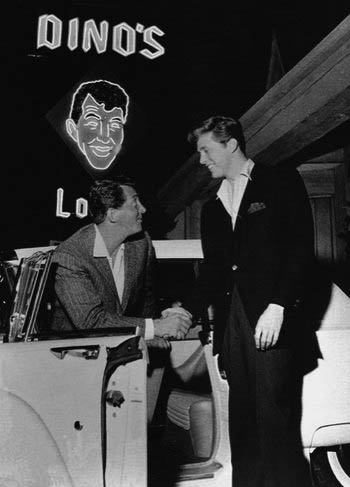 |
(1960s)* - View showing Dean Martin and 'Kookie' (Ed Byrnes), one of the stars of the TV show 77 Sunset Strip, in front of Dino's Lodge.
|
Historical Notes Dino's Lodge restaurant lasted twenty years. It is primarily remembered by fans of the television series 77 Sunset Strip. By the early seventies, this restaurant that had once hosted parties for Frank Sinatra, was part of a cornball travel agency package that advertised a two-hundred and forty-dollar "guided tour of a motion picture studio, a full day at Disneyland and dinner at Dino's Lodge."* |
Sea Witch Club
 |
|
| (ca. 1965)* – View showing the Sea Witch Club located at 8516 W. Sunset Boulevard, just a couple of doors east of Dino's Lodge. The sign by the front door reads: "Straight Jackets", which was the house band from 1964 to 1965. |
Historical Notes The Sea Witch was designed all out of raw wood and was supposed to look like a ship. Size wise, it was a very small club when compared to others on the Strip and always crowded. It had a capacity of maybe 60-70 people. |
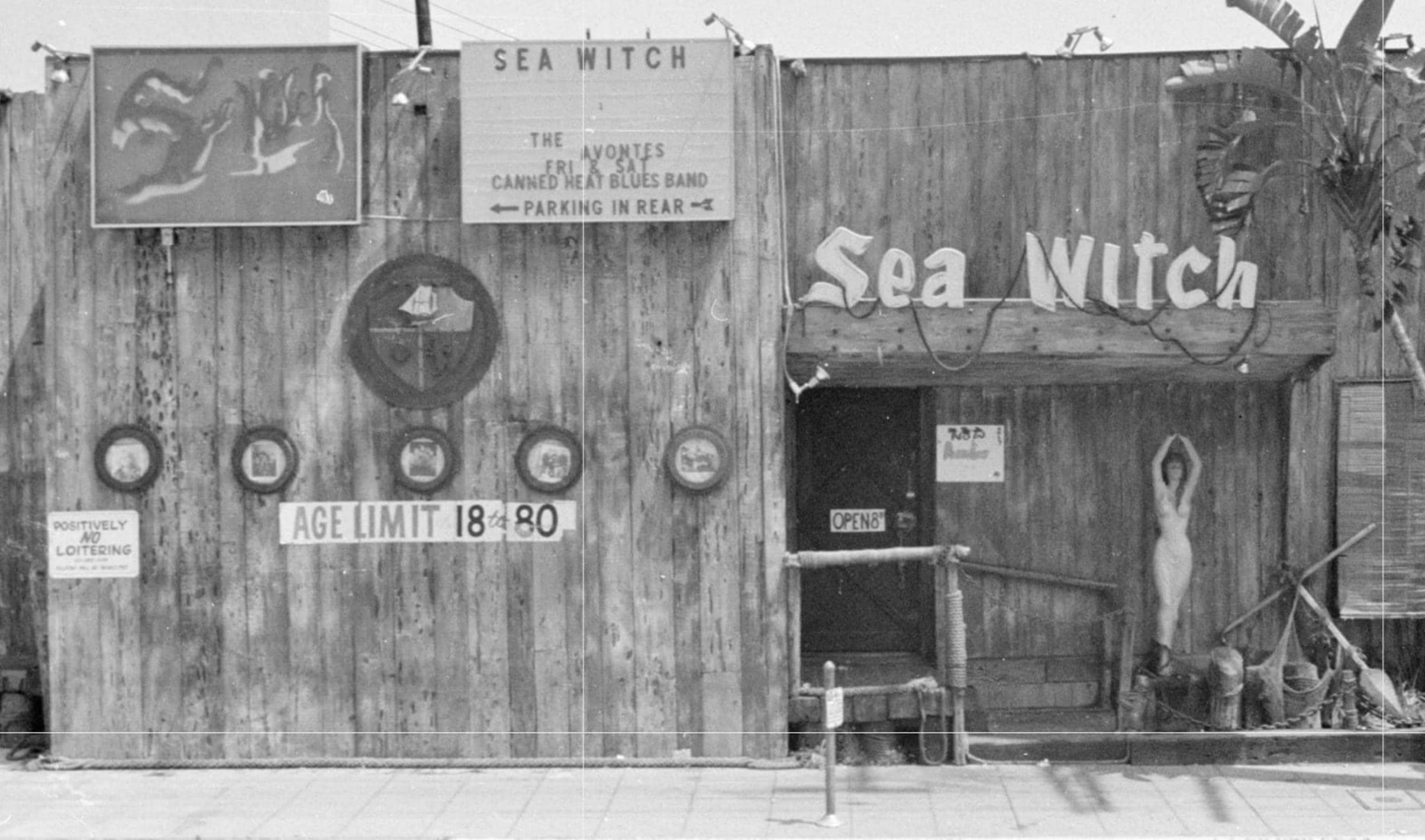 |
|
| (1960s)* – Daytime view of The Sea Witch on the Sunset Strip. Age Limit: ‘18 to 80’. ‘Canned Heat Blues Band now performing Friday and Saturday’. |
Historical Notes On December 9th and 10th, 1966, a new band called “The Doors” played to a packed audience at this now defunct venue. Unfortunately, the entire block of buildings which included the Sea Witch, Dino’s Lodge and the Tiffany Theater was torn down in 2013. Today the location that all three occupied is a multi-story parking garage.* |
* * * * * |
Chasen's Restaurant
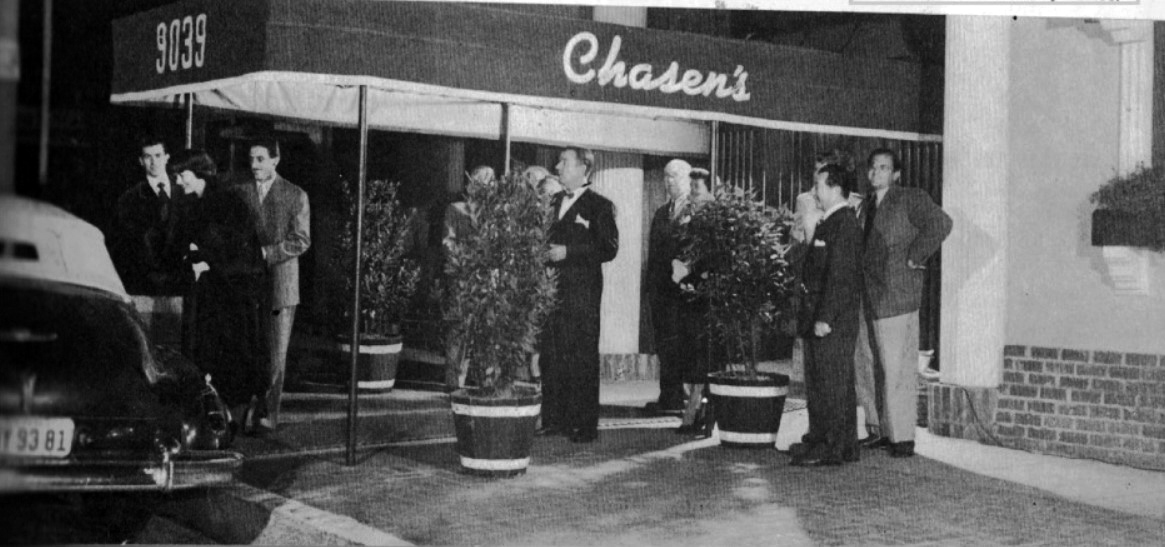 |
|
| (1940s)^.^ – View showing a group well-dressed people waiting for their cars in front of Chasen’s Restaurant located on the NE corner of Beverly Boulevard and Doheny Drive in West Hollywood. |
Historical Notes Chasen’s opened in 1936 by owner Dave Chasen at the suggestion of director Frank Capra. It was just a humble shack named "Chasen's Southern Pit " (because of a barbecue pit in the back). It chili quickly became popular with the show biz crowd, and Chasen's rapidly grew into Hollywood's premier restaurant. Chasen's stuck with the American/Continental fare that brought it success, serving it in a warm, clubby atmosphere of heavy wood paneling and red leather booths. They still served the chili that made them famous (although it wasn't listed on the menu anymore), as well as their hobo steak and deviled beef bones. When Elizabeth Taylor was making "Cleopatra " in Rome, she had their chili flown out to her. |
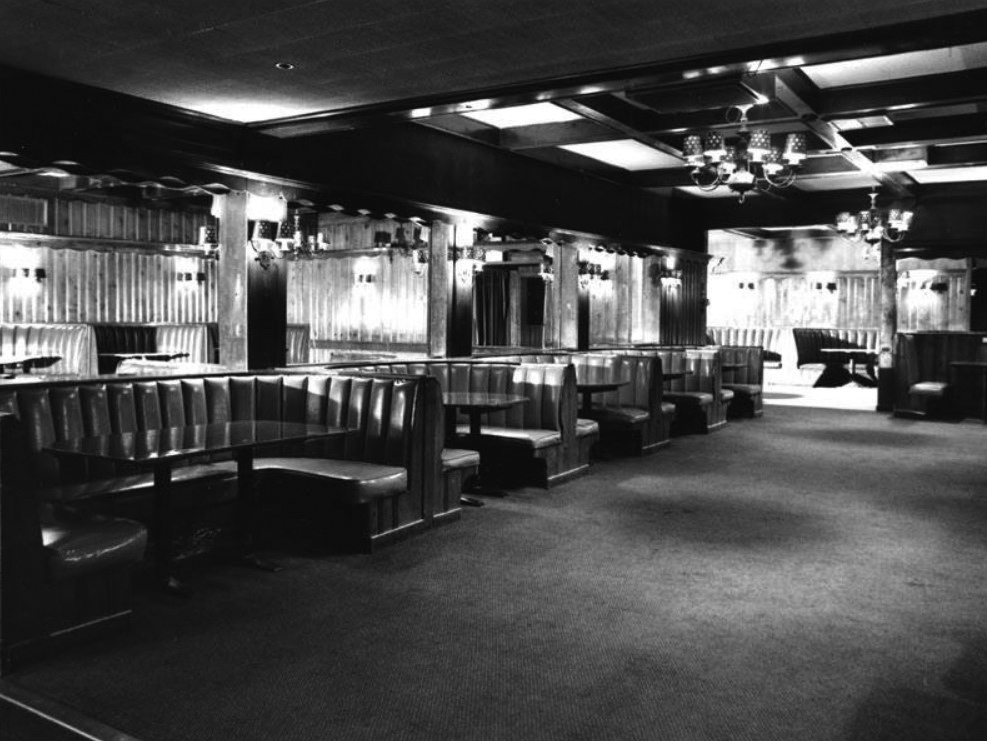 |
|
| (n.d.)^^ – Interior view of Chasen’s showing leather booths and heavy wood paneling. |
Historical Notes The restaurant, which was run by Maude Chasen and her husband Dave until his death in 1973, focused on hearty American/Continental cuisine and became as famous for its colossal seafood platters, hobo steak, a buffet that offered beluga caviar, and delicious cheese toast appetizers as its clientele.* |
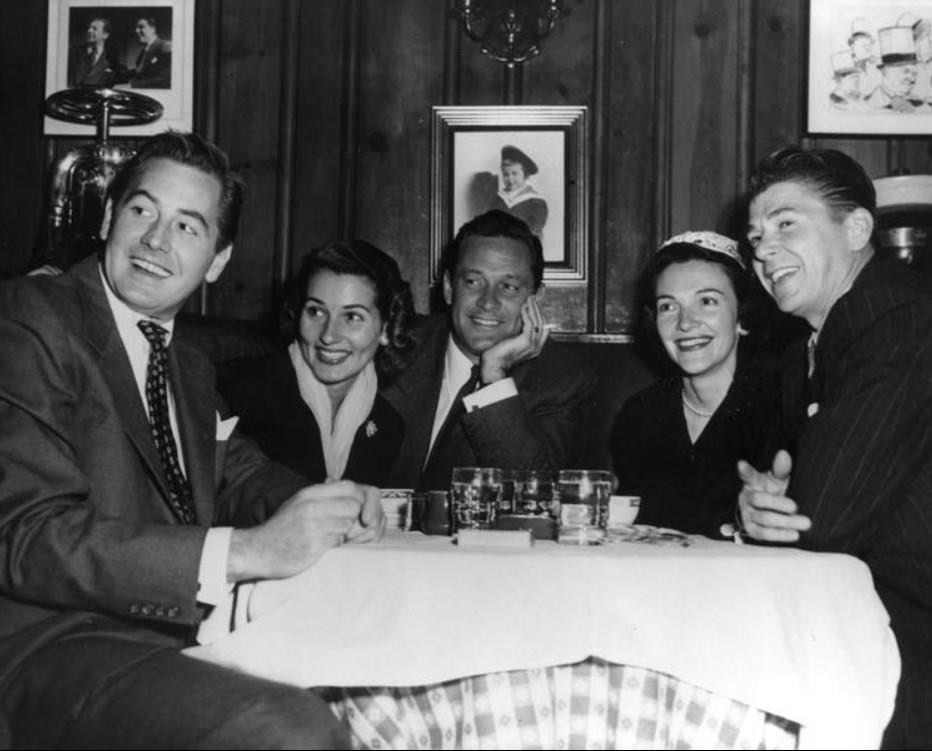 |
|
| (n.d.)^^ - Chasen’s was a hangout for celebrities. Seen at center are William Holden and wife, Brenda Marshall. To the right is Ronald Reagan and wife, Nancy. |
Historical Notes Chasen’s became the culinary hangout of Frank Sinatra, Cary Grant, Clark Gable, Lana Turner, and Groucho Marx. Jimmy Stewart held his bachelor party here, Howard Hughes was seen constantly on the house phone, Alfred Hitchcock routinely fell asleep at his table. After Johnny Carson won his third Emmy in as many years, he took all of the show’s insiders for a celebratory dinner at Chasen’s. Donna Summer wrote her hit “She Works Hard For the Money” on toilet paper in the bathroom—that was Chasen’s for you.* |
 |
|
| (2014)^ – View showing the front entrance to the legendary West Hollywood restaurant, Chasen’s located at 9029 Beverly Boulevard. |
Historical Notes After the restaurant closed in 1995 after a nearly 60 year run, Bristol Farms tore down most of the building but preserving the Beverly Blvd side. Inside, there's a chili station set up for the market, but it's unclear whether that chili is in fact the one that made this place famous. More than any other long lost restaurant in Los Angeles, this one, the site of many a drunken night of revelry for Tinseltown A-listers, has the most intrigue.^ |
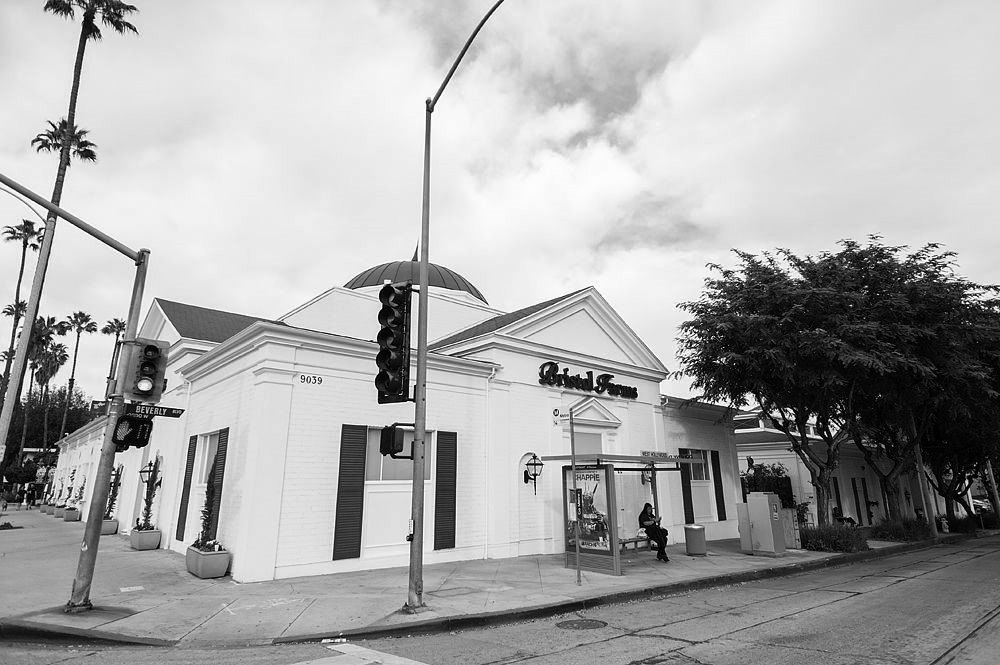 |
|
| (2015)** - View showing the Chasen’s Restaurant building, now a Bristol Farms, located on the NE corner of Beverly and Doheny. |
Historical Notes Now all that's left of the glorious edifice founded by comedian Dave Chasen is a Bristol Farms super market, though there's one last remnant located near the cafe that still contains original booths, paneling, and some vintage photographs from the iconic restaurant. There's also a plaque near the original entrance that tells of this legendary eatery, which entertained everyone from James Cagney and Clark Cable to Warren Beatty and Shirley Temple.* |
* * * * * |
Santa Monica and Doheny
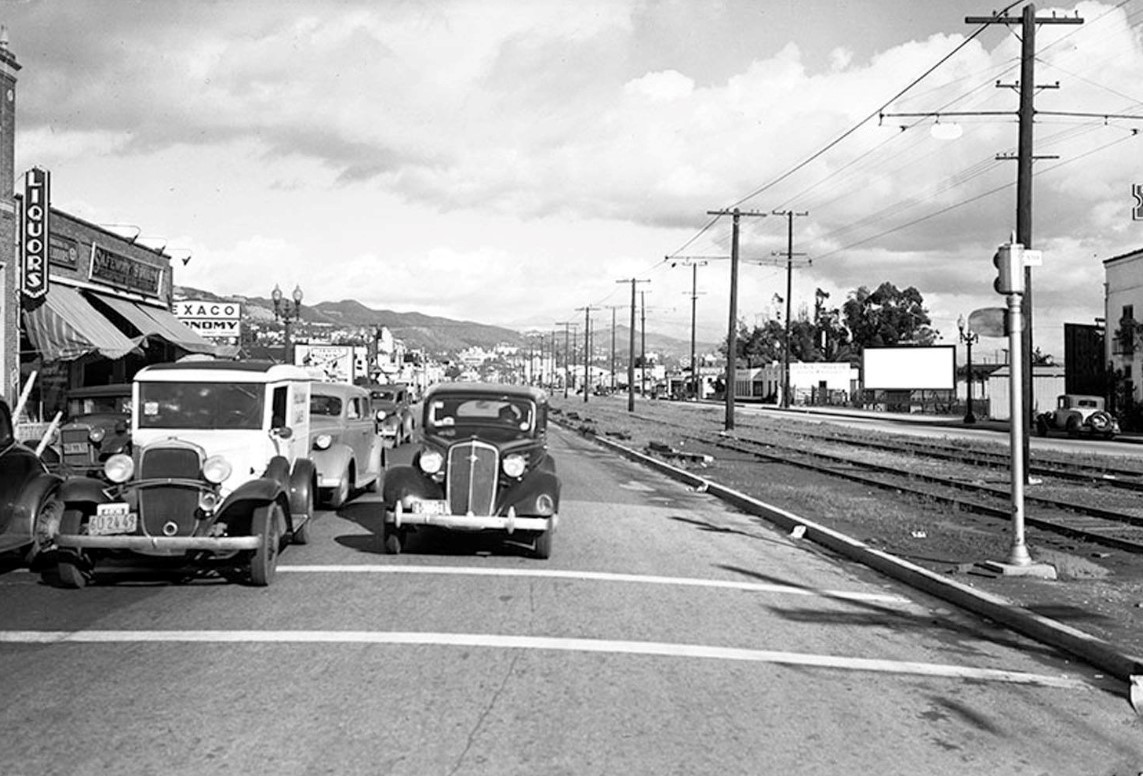 |
|
| (1937)* - View looking east on Santa Monica Boulevard (Historic Route 66) from Doheny Drive. Note the tracks running down the center of Santa Monica Boulevard. |
Historical Notes The tracks running down the center of Santa Monica Boulevard were part of the Pacific Electric Railway since 1911 and carried red cars until the 1950s. They then remained largely unused for decades, serving the occasional Southern Pacific freight train through the 1970s. It was not until 1999 that the West Hollywood segment of the tracks were dug up and replaced by a landscaped median.^ |
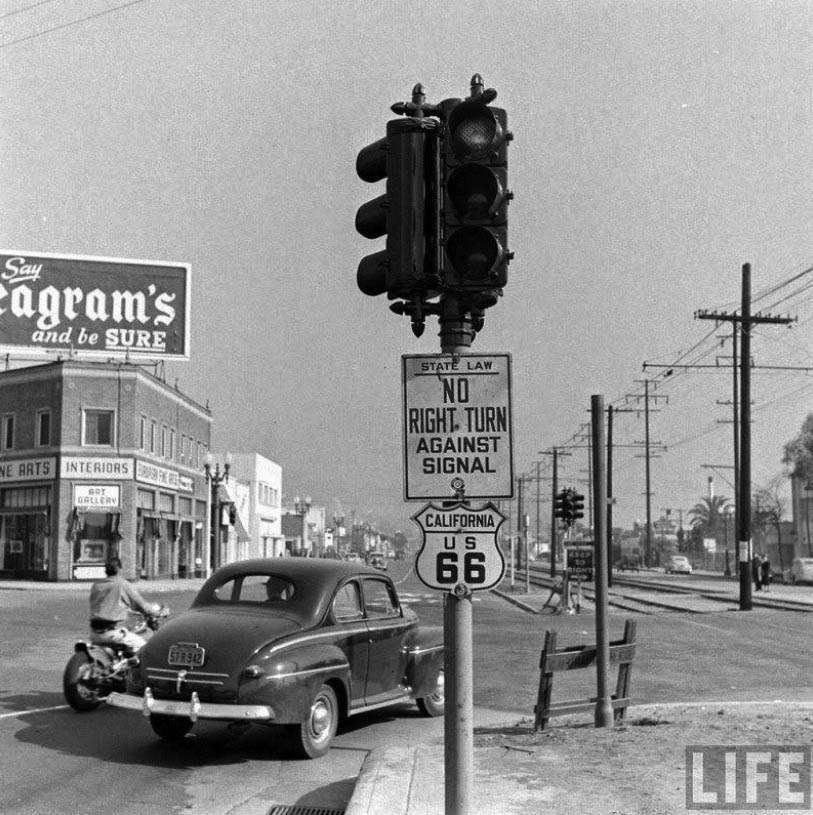 |
|
| (1948)* – View looking east on Santa Monica Boulevard (Historic Route 66) at N. Doheny Drive. |
Historical Notes That brick building on the left is still there and billboards STILL advertise on top of it. The Troubadour would eventually become that second white building. And check out the railroad tracks in the middle of the road! |
 |
|
| (1964)* - Looking west along the railroad tracks on Santa Moinica Boulevared with Doheny Drive seen in the distance. Workers begin removing the railroad ties in the center median. The Troubadour Nightlclub sign is right above and behind the pick-up truck |
Historical Notes The tracks were used by the old Red Line cars. They ran from Gardner up Santa Monica Boulevard through West Hollywood, Beverly Hills, and Los Angeles to the city of Santa Monica. After the demise of the Red Cars, Southern Pacific continued to run a short train to maintain its claim to the right of way, even after it stopped transporting wheat and other supplies to the former Wonder Bread Bakery in Beverly Hills. (On warm summer evenings, the aroma of baking bread would waft over the area.) After West Hollywood incorporated in 1984, one of the first improvement projects the new city planned was removal of the tracks, narrowing of the median, extensive landscaping, and widening of the sidewalks along the length of the boulevard within its limits. |
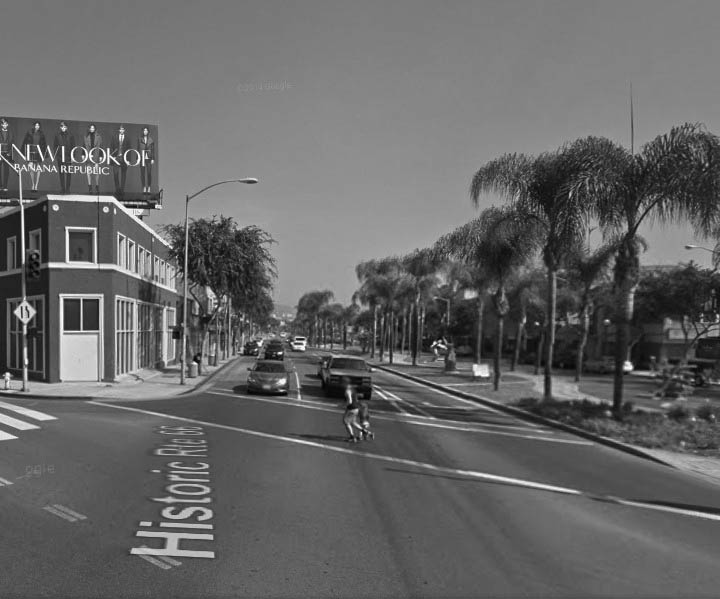 |
|
| (2014)*### – Google street view looking east on Santa Monica Boulevard at Doheny Dr. |
Historical Notes The building on the corner has stood empty for nearly 40 years. The billboard remains atop, and provides the owner tens of thousands of dollars in revenue each month. The billboard is grandfathered, and cannot be modernized. In addition, any modification to or construction in the building require the billboard to be taken down. So there it stands... |
Before and After
.jpg) |
.jpg) |
|
| (1948 vs. 2014) - Before and After - Santa Monica and Doheny |
Historical Notes The second white building on the left would become the Troubadour Nightclub in 1957. |
Santa Monica and San Vicente
 |
|
| (ca. 1946)##^* - An early model Cadillac meets up with PE car No. 5120 at the intersection of Santa Monica and San Vicente boulevards. Val's Coffee Shop can be seen on the NE corner at 8875 Santa Monica Blvd. |
Santa Monica and La Cienega
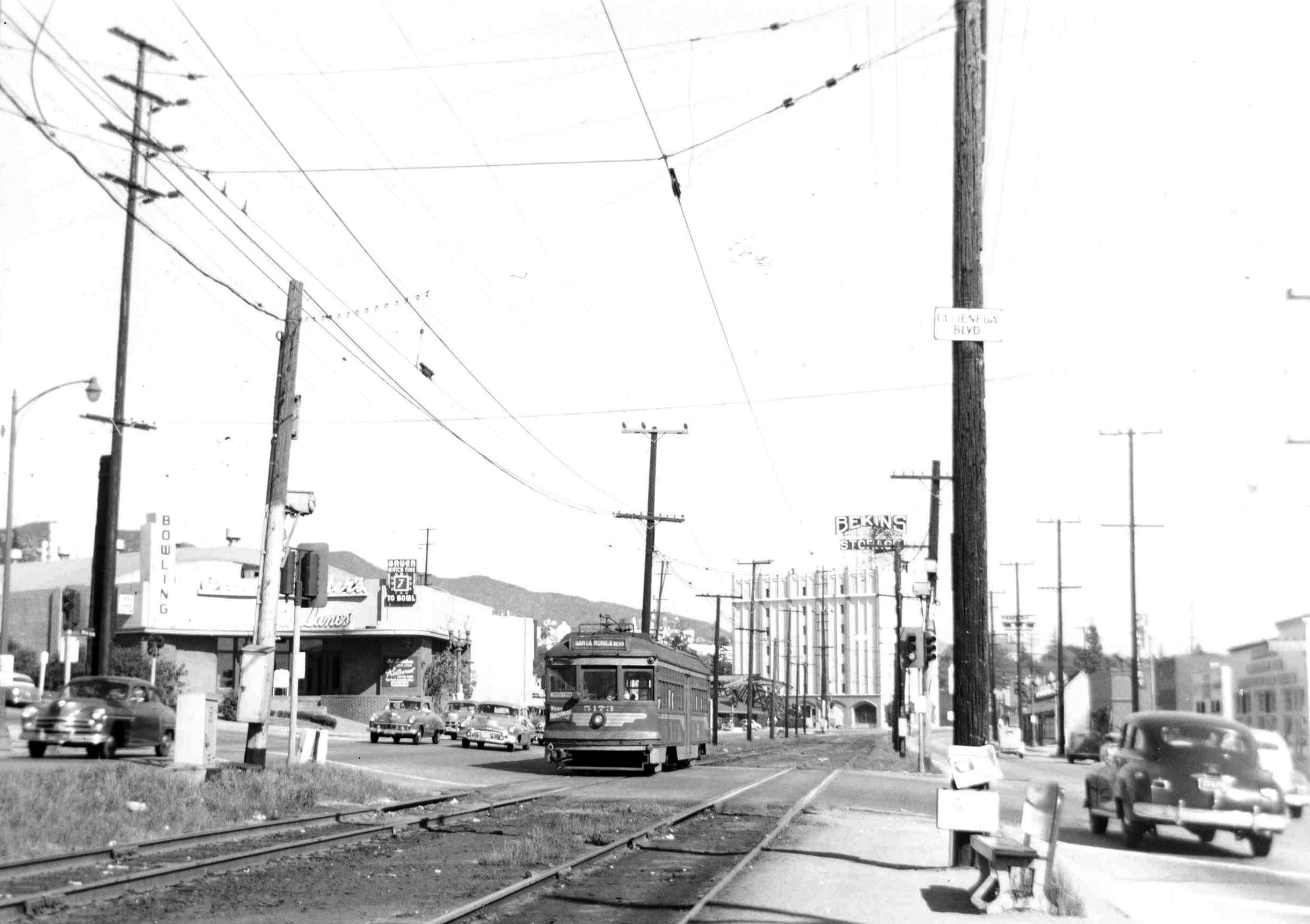 |
|
| (ca. 1947)#+#+ - View looking northeast showing streetcar and tracks running down the center of Santa Monica Boulevard at La Cienega Boulevard. The La Cienega Lanes bowling alley (built in 1940) is seen on the N/E corner. |
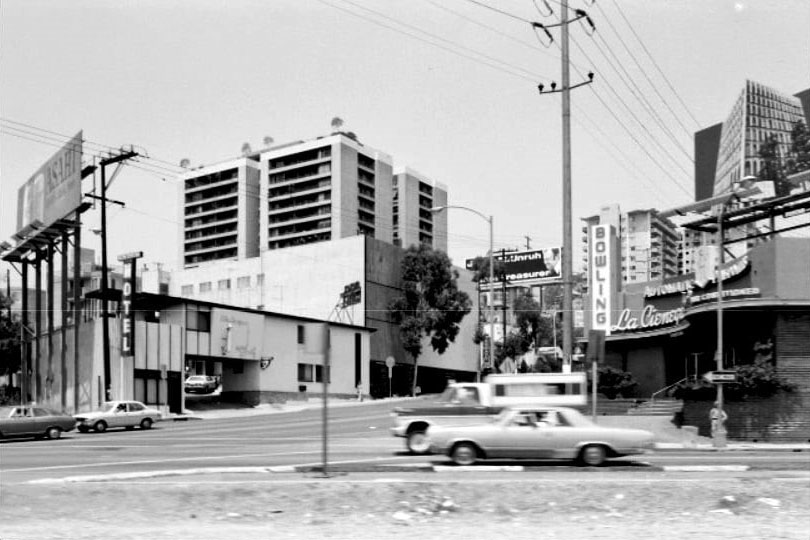 |
|
| (1974)^ – View looking north at the intersection of La Cienega and Santa Monica Boulevard with La Cienega Lanes seen on the right. |
Historical Notes In 1946, radio and television personality Art Linkletter and his associates acquired the bowling alley on the northeast corner of Santa Monica Blvd and La Cienega Blvd and called it Art Linkletter’s La Cienega Lanes. In the 1970s, it became a roller disco called “Flippers”. |
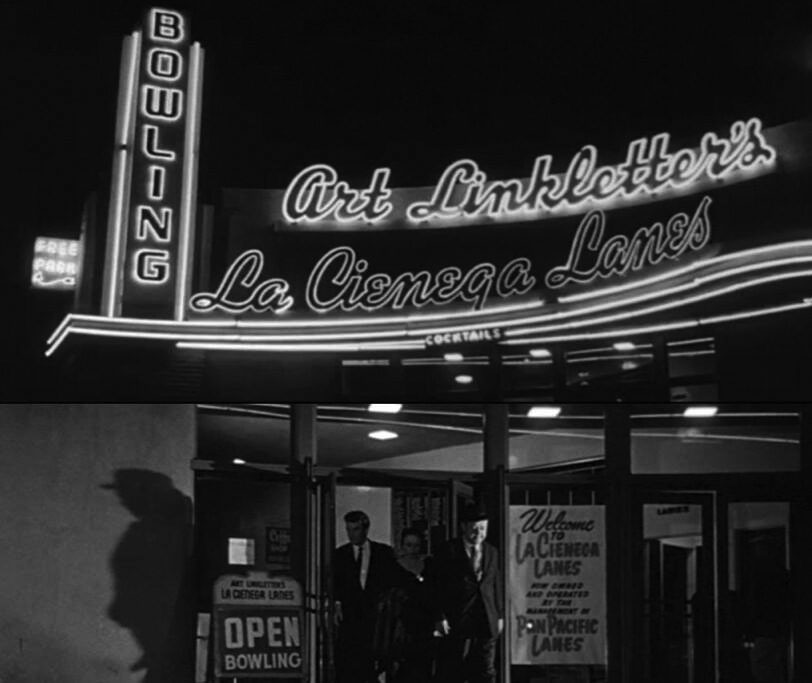 |
|
| (n.d.)* - Night view showing the front entrance to Art Linkletter's La Cienega Lanes on the N/E corner of Santa Monica and Lacienega boulevards. |
Historical Notes Art Linkletter was a radio and television personality who hosted several TV and radio shows for over 25 years (House Party, People Are Funny, and Kids Say the Darndest Thigs). He was famous for interviewing children on his shows, which led to a series of books quoting children.*^ |
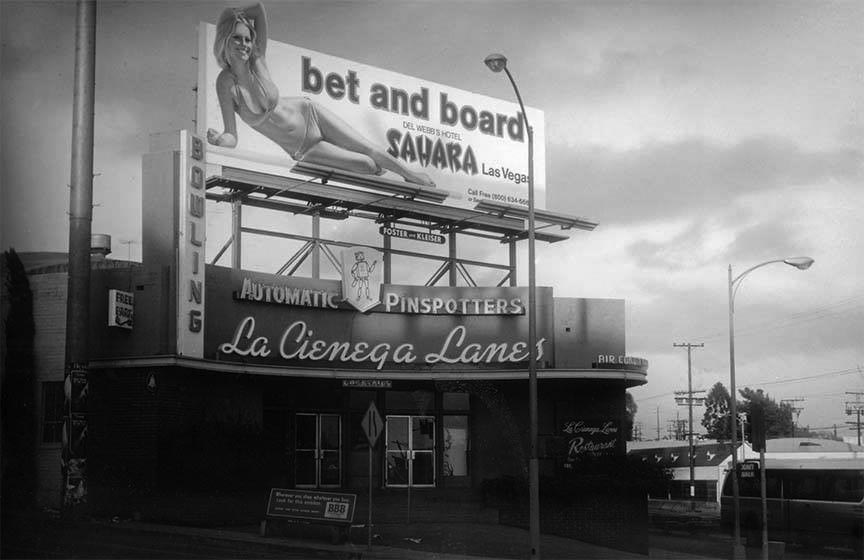 |
|
| (ca. 1965)* – View showing the La Cienega Lanes bowling alley, now with automatic pinspotters. |
Historical Notes La Cienega Lanes lived during a popular time for bowling, when the LA Times even had a regular bowling column. The lanes survived into the 1970s, but bowling began to lose its popularity. Adapting with the times, the building transformed into the next hottest thing: a late-70s roller disco. +++ |
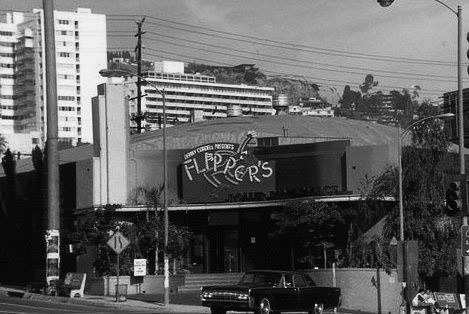 |
(ca. 1980)+++# - View showing Flipper's Roller Derby Palace on the N/E corner of La Cienega and Santa Monica boulevards. |
Historical Notes Flipper's Roller Boogie Palace opened up in July 1979. The owners were Denny Cordell, Nicholas Cowan and Flipper (a mysterious Englishman named Flipper). The property was partly owned by Berry Gordy, Motown's head man. Flipper's was a posh and exclusive nightclub for skaters. It was also a private club. However, one didn't have to be rich and famous to join. Membership was limited to 1,000. A 5-man membership committee chose the members who paid $200 annually plus a $7 entrance fee. It was open 8pm 'til late. +++# |
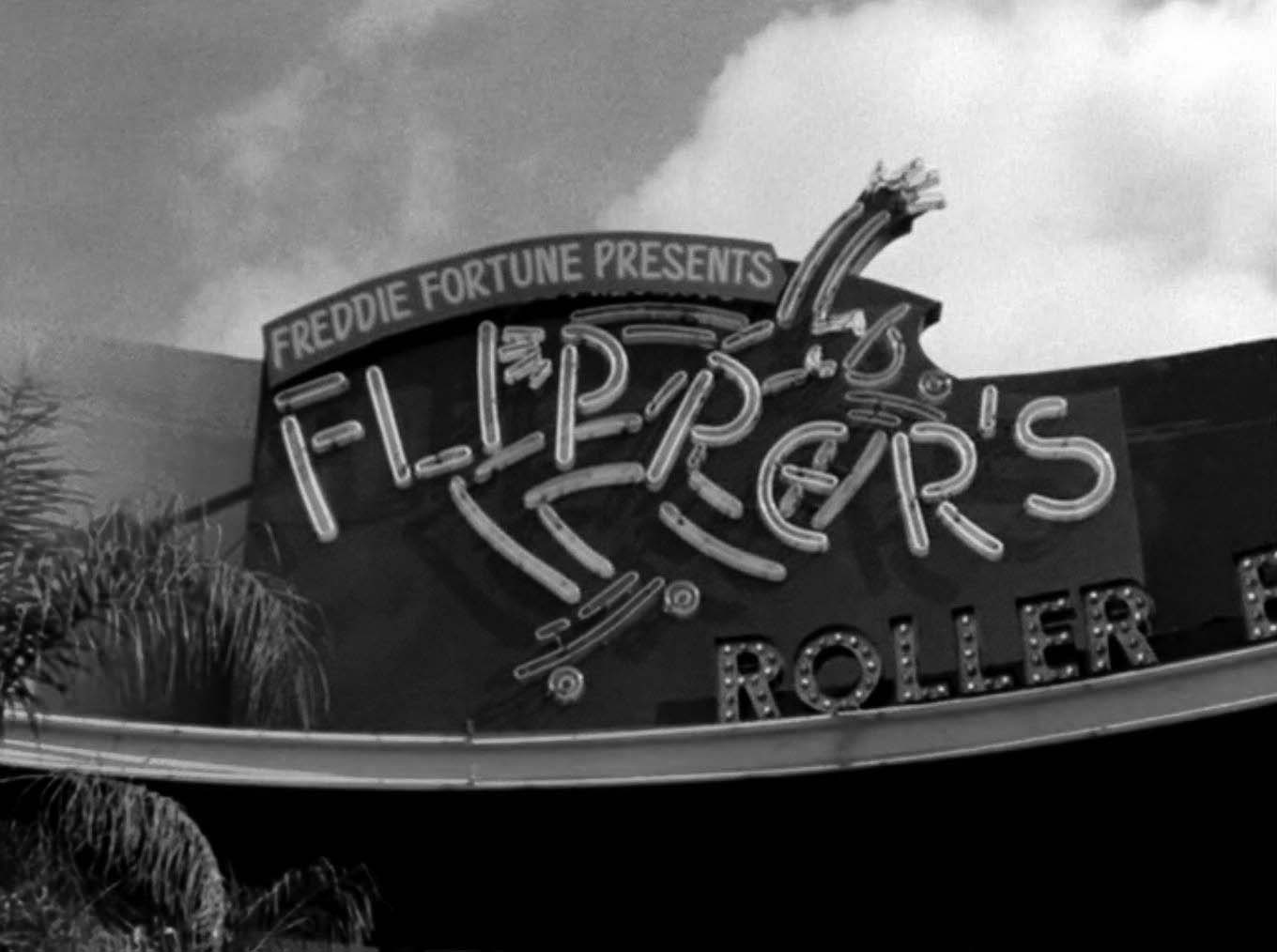 |
|
| (ca. 1980)* - Close-up view showing sign above the front entrance to Flipper's Roller Derby Palace. |
Historical Notes Flipper's had a bar, restaurant and a custom skate shop. It was decorated to look like a plush exotic tropical fantasy paradise. It had mirrors, disco balls, mural and private booths. Rather than wood, the skating floor was made of polyurethane. |
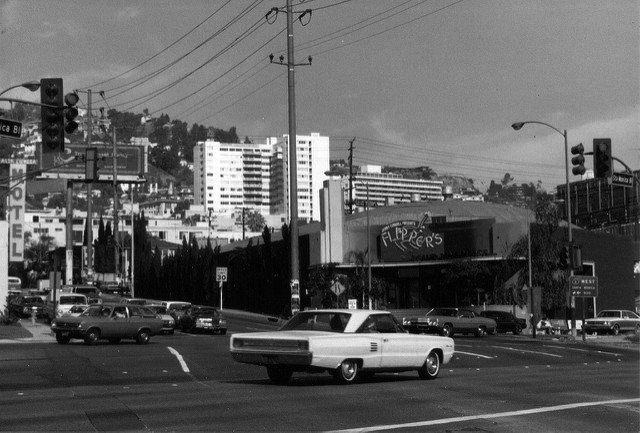 |
|
| (ca. 1981)*- View showing 1967 Dodge Coronet at the intersection of Santa Monica and La Cienega, with Flipper's Roller Derby Palace on the N/E corner. |
Historical Notes In 1983 the site became a Esprit De Corps. - a woman's apparel retail shop. Today a CVS drug store occupies the site. |
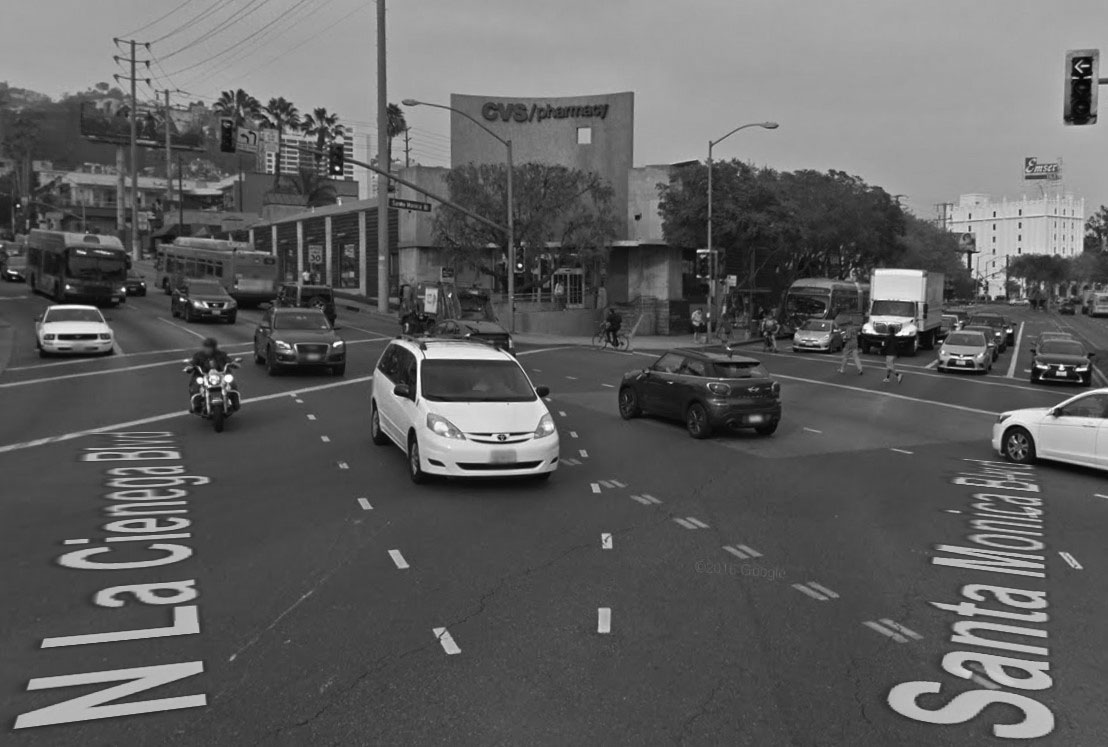 |
|
| (2016)* – Google street view showing the N/E corner of Santa Monica and La Cienega boulevards where a CVS Pharmacy now occupies the building which once housed the La Cienega Lanes. |
Then and Now
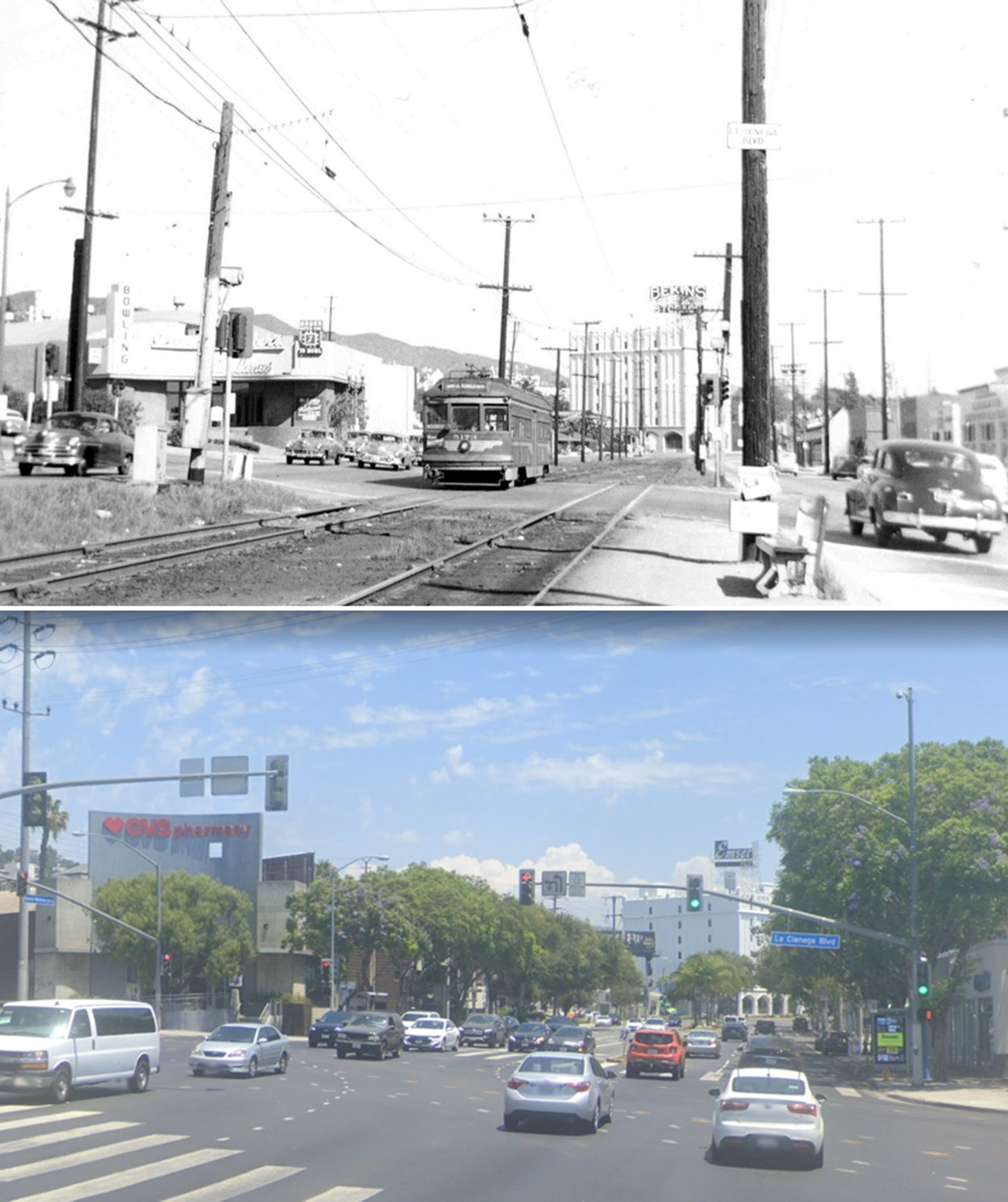 |
|
| (1947 vs 2022)* - Looking northeast showing streetcar and tracks running down the center of Santa Monica Boulevard at La Cienega Boulevard. The 1940-built La Cienega Lanes bowling alley (today a CVS Pharmacy) is seen on the N/E corner. In the distance is the old Bekins building (today, Emser Tile building). |
Santa Monica Blvd and Orlando Ave
 |
|
| (1930s)* - Looking north on Orlando Avenue toward Santa Monica Boulevard. |
Then and Now
.jpg) |
|
| (1930s vs 2021)* - Looking north on Orlando Avenue toward Santa Monica Boulevard. |
Santa Monica Blvd and Flores St
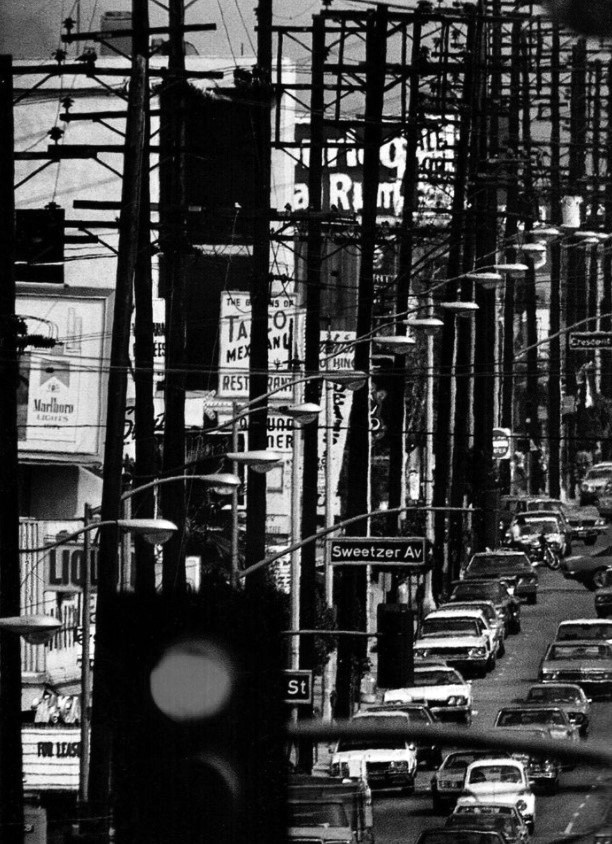 |
|
| (1979)^.^ – CAN'T SEE THE FOREST FOR THE TREES. Telephoto view looking east on Santa Monica Blvd at Flores Street showing overhead pole line congestion. The Gardens of Taxco Mexican Restaurant sign can be seen past Sweetzer Ave at Harper Ave. Taxco was actually located just north of the Yellow Submarine located on the NW corner. At lower-left can be seen The Gary Theatre (originally Players Ring Theatre, today Coast Playhouse) |
Historical Notes The Players Ring Theatre was a live stage theatre which opened by 1949. By the mid-1960s, this theatre was twinned and renamed Gary Theatre I & II. It ran gay porn movies during the 1970’s, and revival shows through the 1980’s. Since at least the mid-1980’s it has operated as a live theatre, known as the Coast Playhouse, it often presents plays with a gay theme, complementing its West Hollywood location.* |
 |
|
| (2019)^ – Google Street View looking East on Santa Monica Blvd at Flores Street. Basix Cafe can be seen at left, on the NE corner. Two doors to the East stands The Coast Playhouse (originally Players Ring Theatre). All the overhead lines and poles have been removed. |
Troubadour Nightclub
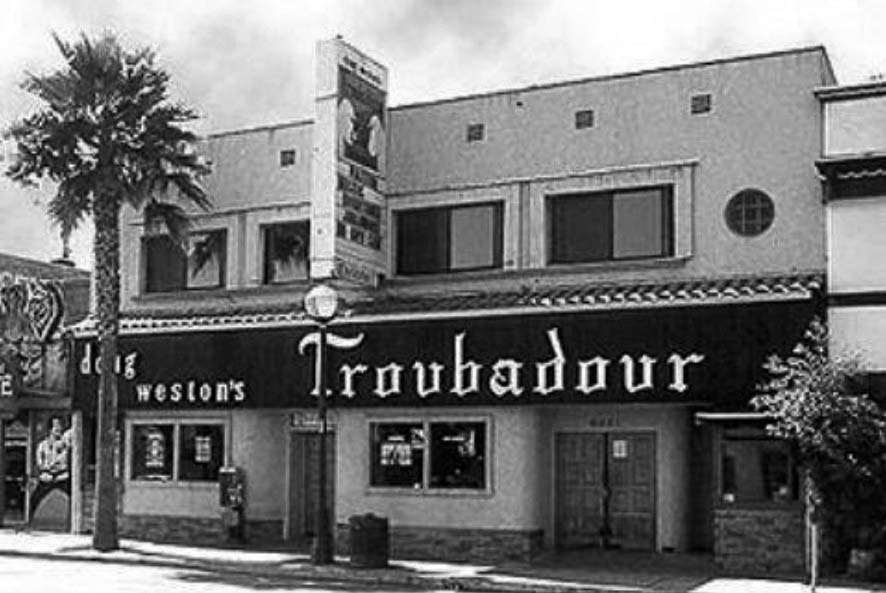 |
|
| (1957)^ - View of the Troubadour Nightclub shortly after its opening in 1957. Located at 9081 Santa Monica Boulevard, West Hollywood, it is just east of Doheny Drive and the border of Beverly Hills. |
Historical Notes Opened in 1957 by Doug Weston, the Troubadour was originally a coffee house located on La Cienega Boulevard. It then moved to its current location shortly after opening and has remained open continuously since. It was a major center for folk music in the 1960s, and subsequently for singer-songwriters and rock.*^ |
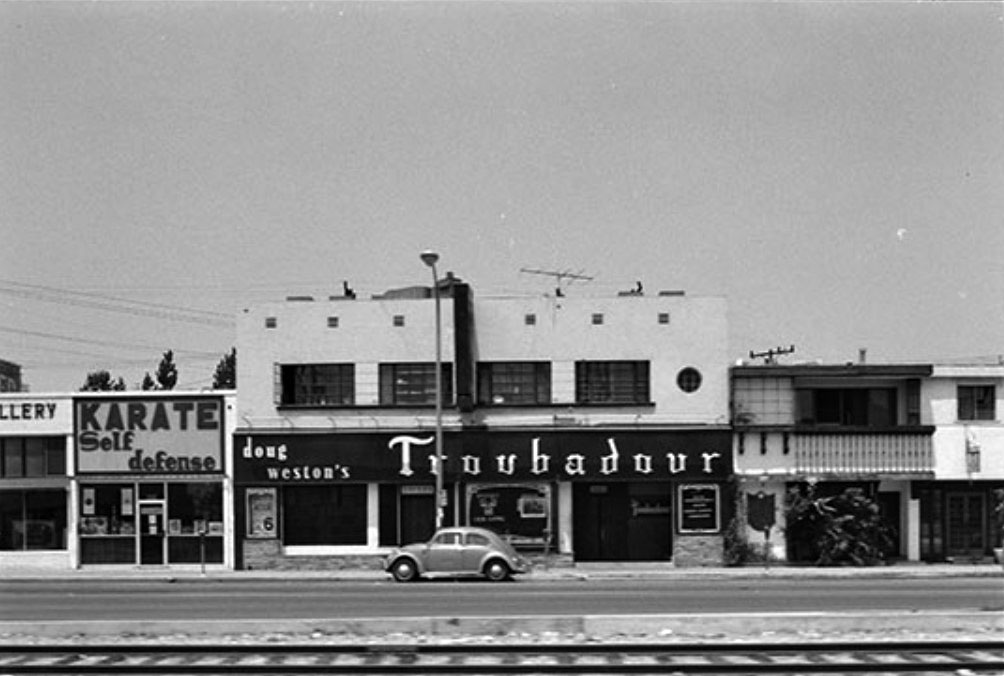 |
|
| (1974)^ – View looking across the tracks on Santa Monica Boulevard showing the Troubadour Nightclub. |
Historical Notes The Troubadour played an important role in the careers of Elton John, Linda Ronstadt, James Taylor, the Eagles, The Byrds, Love, Joni Mitchell, Hoyt Axton, Carole King, Bonnie Raitt, J.D. Souther, Jackson Browne, Van Morrison, Buffalo Springfield and other prominent and successful performers, who played performances there establishing their future fame.* |
 |
|
| (2006)* - View of Doug Weston's Troubadour nightclub in West Hollywood. Other than the paint color, the exterior hasn’t changed much since it opened in 1957. |
Historical Notes In 1962, comedian Lenny Bruce was arrested on obscenity charges for using the word "schmuck" on stage; one of the arresting officers was Sherman Block, who would later become Los Angeles County Sheriff. On August 25, 1970, Neil Diamond (who had just recorded his first live album at the Troubadour) introduced Elton John, who performed his first show in the United States at the Troubadour. In 1974, John Lennon and his friend Harry Nilsson were ejected from the club for drunkenly heckling the Smothers Brothers. Randy Newman started out at the club and comics Cheech & Chong and Steve Martin were discovered there. In 1975, Elton John returned to do a series of special anniversary concerts. In November 2007, James Taylor and Carole King played a series of concerts commemorating the nightclub's 50th anniversary and reuniting the two from their 1970 performance.* Click HERE for a contemporary street view. |
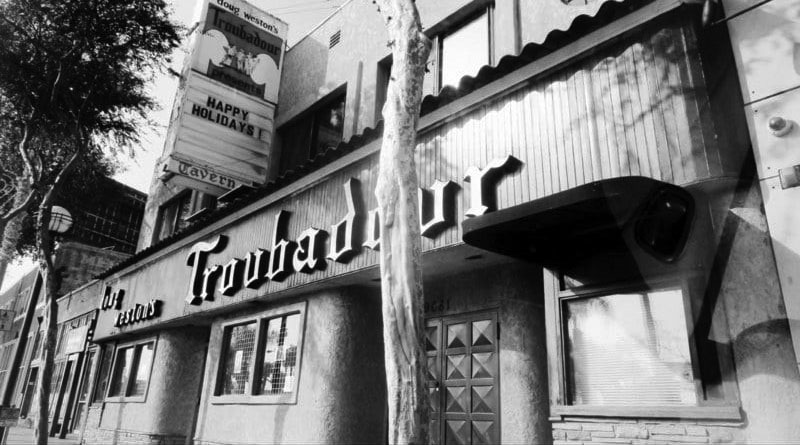 |
|
| (2020)^ - Close-up view of the front entrance to the Troubadour, 9081 Santa Monica Boulevard. Photo by Flo Selfman |
Historical Notes In 2020, like many small businesses & music venues, the Troubadour has struggled during the pandemic, and launched a GoFundMe page in May, which raised $70,000. In August, Elton John celebrated his 50th anniversary of playing the venue, and expressed his concern about the survival of the iconic nightclub. Comedian Bill Burr has also hosted 2 of his Monday Morning Podcasts from the venue to raise money during the Pandemic.^ |
Then and Now
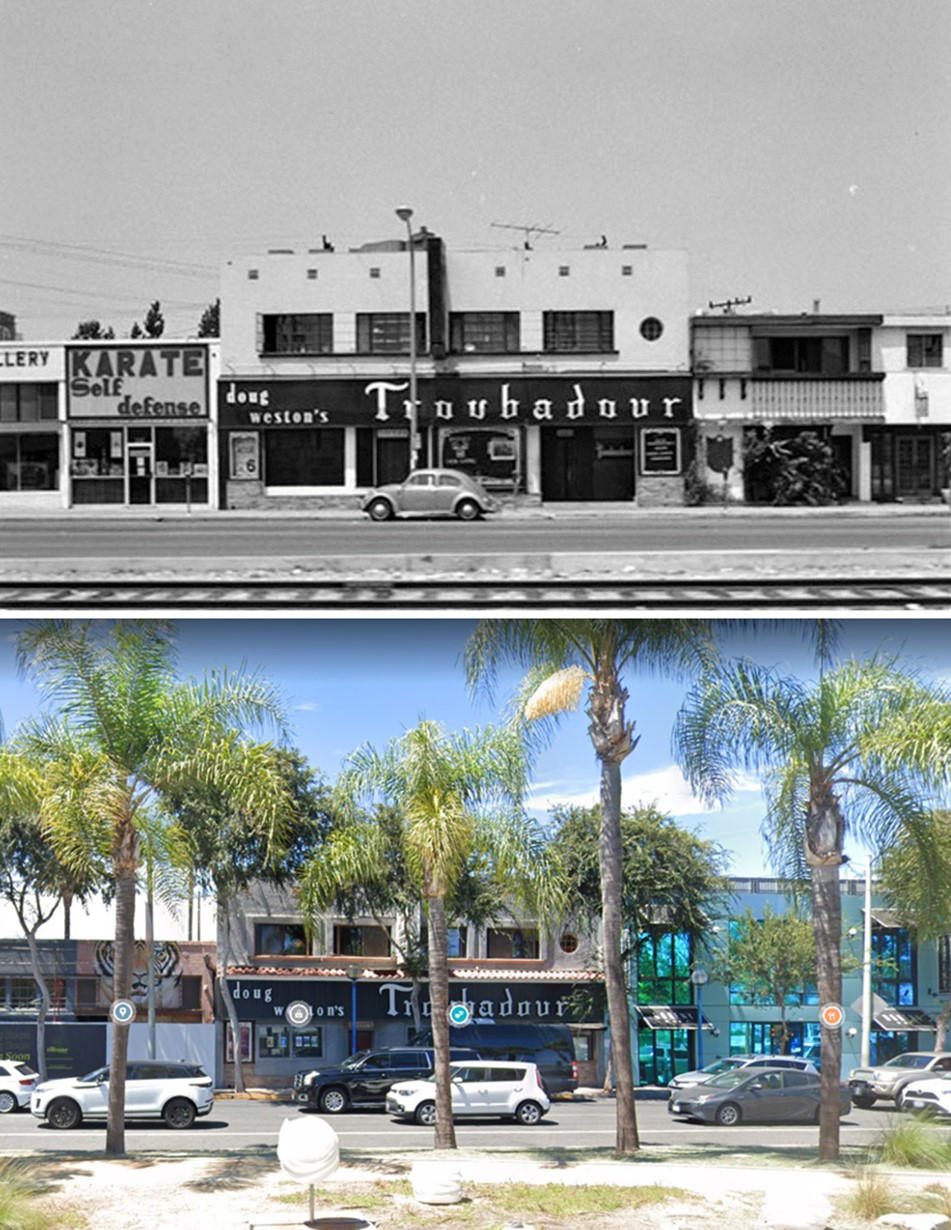 |
|
| (1974 vs 2022)* - Looking across Santa Monica Boulevard toward the Troubadour Nightclub. |
Jones Dog & Cat Hospital
 |
|
| (1938)* - Dr. Eugene C. Jones Animal Hospital located at 9080 Santa Monica Boulevard in West Hollywood. |
Historical Notes The Streamline Moderne Jones Dog & Cat Hospital building was designed by the prominent architecture firm of Wurdeman and Becket. Two other examples of the work of Wurdeman & Becket include the former Mobil Oil/General Petroleum Building, now Pegasus Apartments, and Bullock's Pasadena, now Macy's. As Welton Becket & Associates, the firm went on to design many of L.A.'s iconic landmarks, including Capitol Records Tower, the Music Center of Los Angeles County, and the Cinerama Dome. The redesigned structure, completed in 1938, is an excellent example of the Streamline Moderne architectural style that emerged in the 1930s. It features smooth wall surfaces, curved corners and volumes, and an emphasized horizontal design. The windows are arranged in continuous ribbons across the façade, with extensive use of glass block. Accentuating the building’s sleek lines, polished stainless steel is used for the entrance canopy and vertical fins rising above the main door. Taking its name from the curved form of a teardrop, which was the most efficient shape in lowering the wind resistance of an object placed in the stream lines of a wind tunnel, the Streamline Moderne evoked a sense of modern efficiency with curved surfaces, sleek finishes, and a spare use of detailing which often included pronounced horizontal banding and, in some cases, contrasting vertical accents.* |
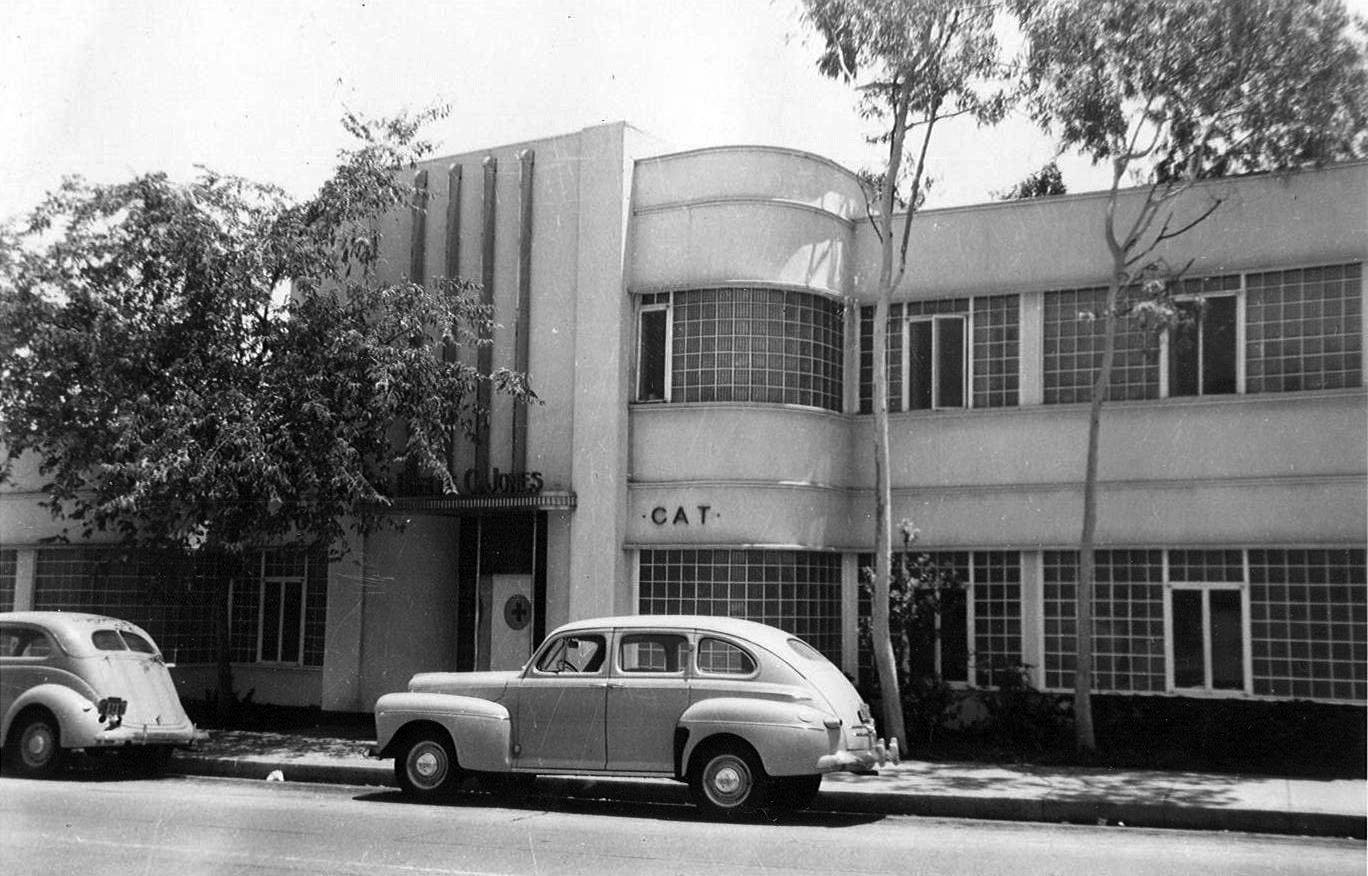 |
|
| (1947)^ – Two cars are parked in front of Jones Dog and Cat Hospital. |
Historical Notes Dr. Eugene C. Jones, a progressive veterinarian whose clients included the likes of Charlie Chaplin, Gloria Swanson and Rudolph Valentino, commissioned Wurdeman and Becket to expand and remodel his original 1928 animal hospital, transforming it into a sleek and modern facility. Dr. Jones’ animal hospital, which specialized in dogs and cats, was considered one of the first in Southern California. Its location at the western edge of West Hollywood near the border with Beverly Hills put it within short distance of the homes of wealthy clientele and their pets.* |
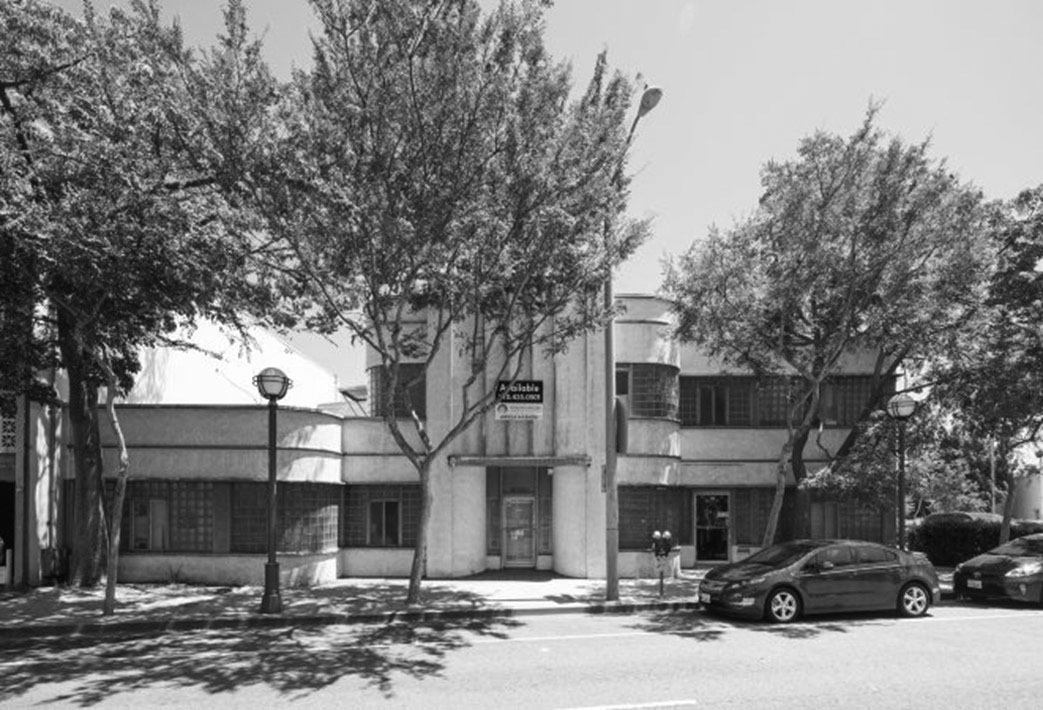 |
|
| (2014)^ – Jones Building available for lease. Located at 9080 Santa Monica Boulevard, across the street from the Troubadour Night Club. Photo by Hunter Kerhart |
Historical Notes The building operated as an animal hospital for several decades. Between 1951 and 1981, the building was owned and operated by R. Nichol Smith, D.V.M. as a dog hospital. This historic West Hollywood building was demolished in 2021 to make way for a mixed-use development.* |
Melrose, Santa Monica, and Doheny Intersection
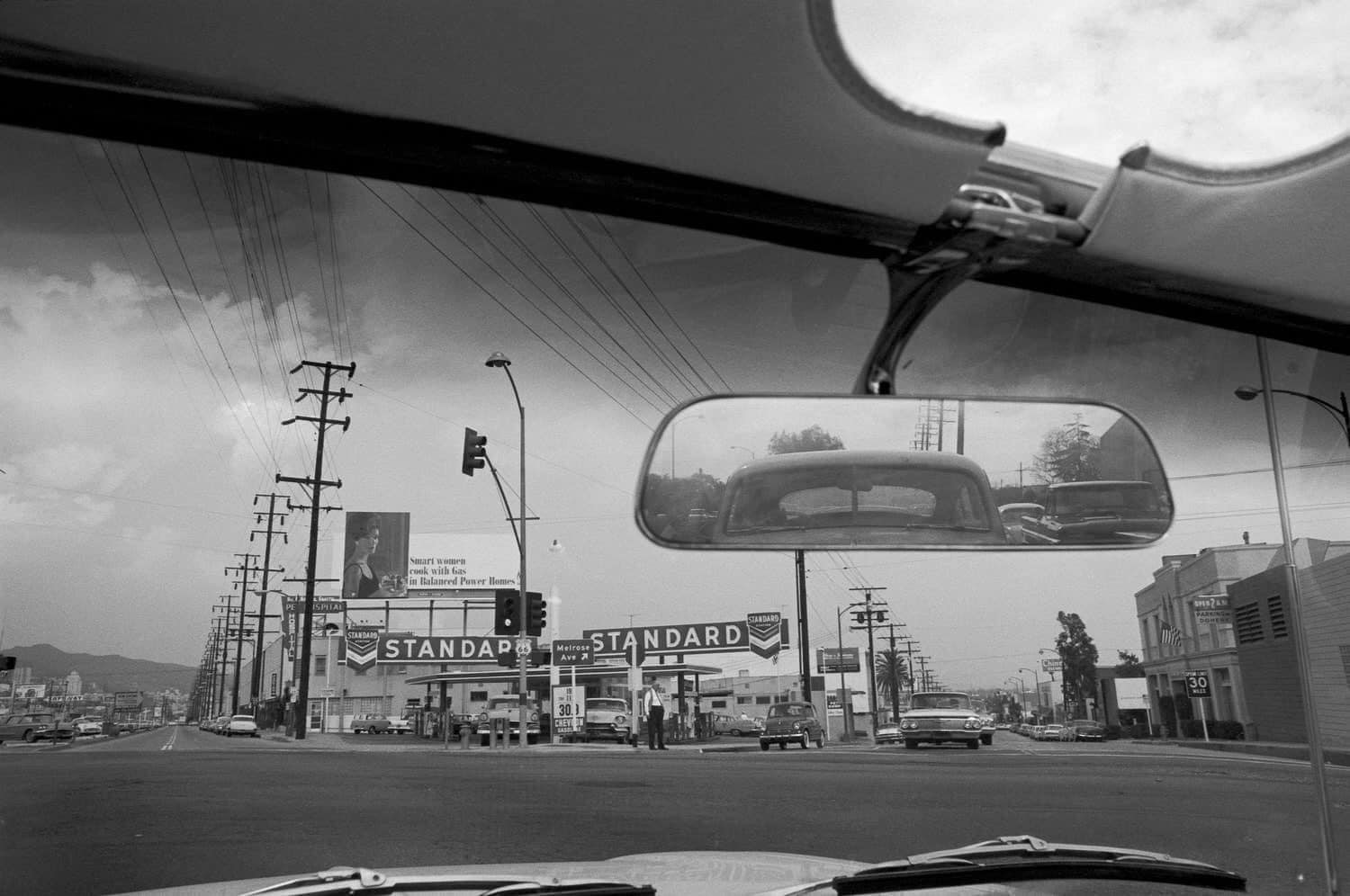 |
|
| (1950s)* – Looking East at the Melrose, Santa Monica and Doheny intersection. Santa Monica Blvd is on the left. The Troubador is out of sight off to the left on the other side of Santa Monica. The future Figaro’s can be seen as the two story white building on the right side of Melrose. |
Then and Now
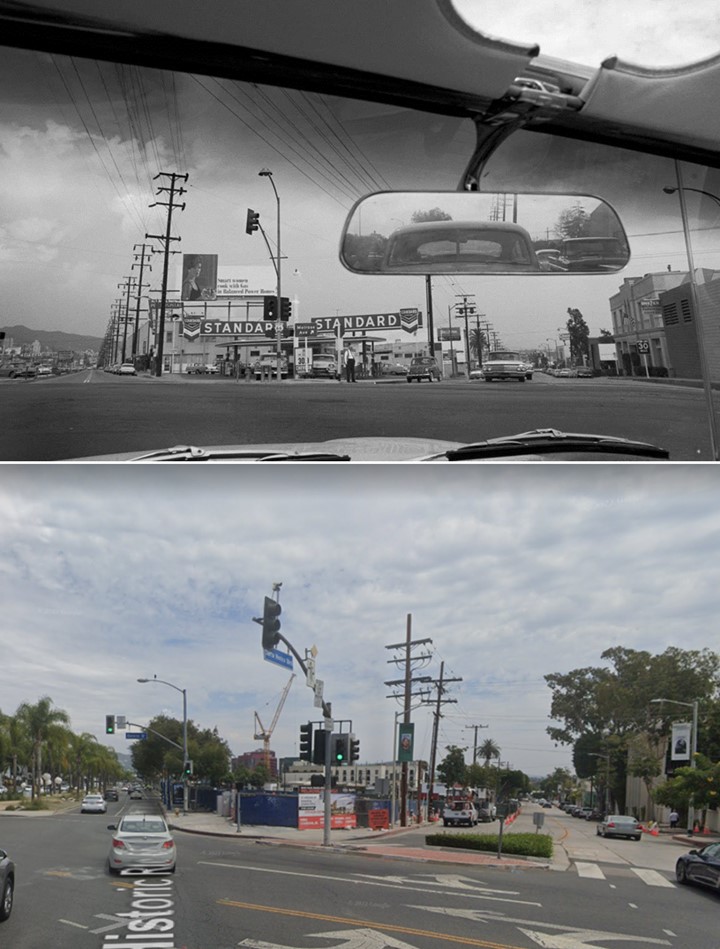 |
|
| (1950s vs. 2022)* – Melrose, Santa Monica and Doheny intersection. |
Doheny Drive
.jpg) |
|
| (1962)^ – View looking north on Doheny Drive between Sunset Blvd. and Santa Monica Blvd. |
Historical Notes Doheny Drive forms the western end of the Strip, which ends at Crescent Heights Boulevard to the east. It is named for Edward L. Doheny, a Los Angeles oil tycoon. |
Whisky A-Go-Go
.jpg) |
|
| (1965)* – Band, dance floor, and Go Go’s dancers in a suspended cage. |
Historical Notes The Sunset Strip Whisky was founded by Elmer Valentine, Phil Tanzini, Shelly Davis, and attorney Theodore Flier and opened on January 16, 1964. Though the club was billed as a discothèque, suggesting that it offered only recorded music, the Whisky a Go-Go opened with a live band led by Johnny Rivers and a short-skirted female DJ Rhonda Lane, spinning records between sets from a suspended cage at the right of the stage.^ The Doors were the nightclub's house band in the years after the Whisky made discotheque and go-go dancers a national craze. |
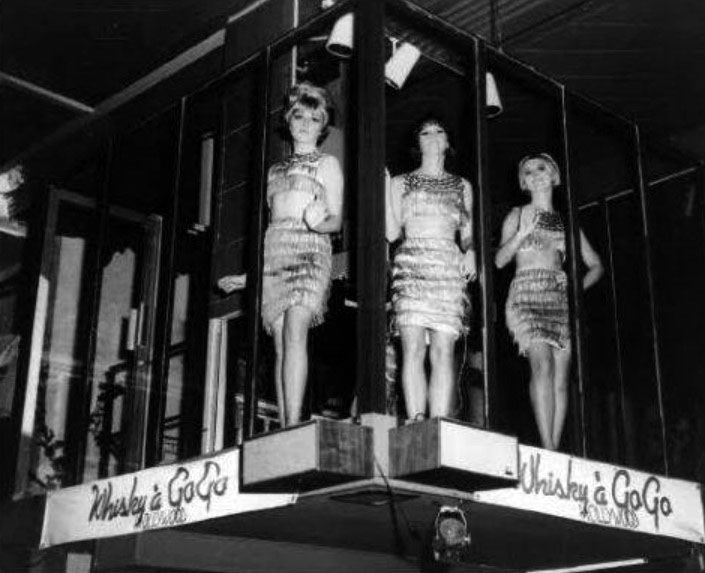 |
|
| (1964)* - Whisky a Go Go’s dancers in a suspended cage above the dance floor. |
Historical Notes The Turtles performed there when their newest (and biggest-selling) single "Happy Together" was becoming a hit, only to lose their new bassist, Chip Douglas (who had arranged the song), to the Monkees; guitarist Michael Nesmith invited him to become their producer. (He returned to the Turtles a year later, to produce them.) Neil Diamond also played at the Whisky on occasion.^ |
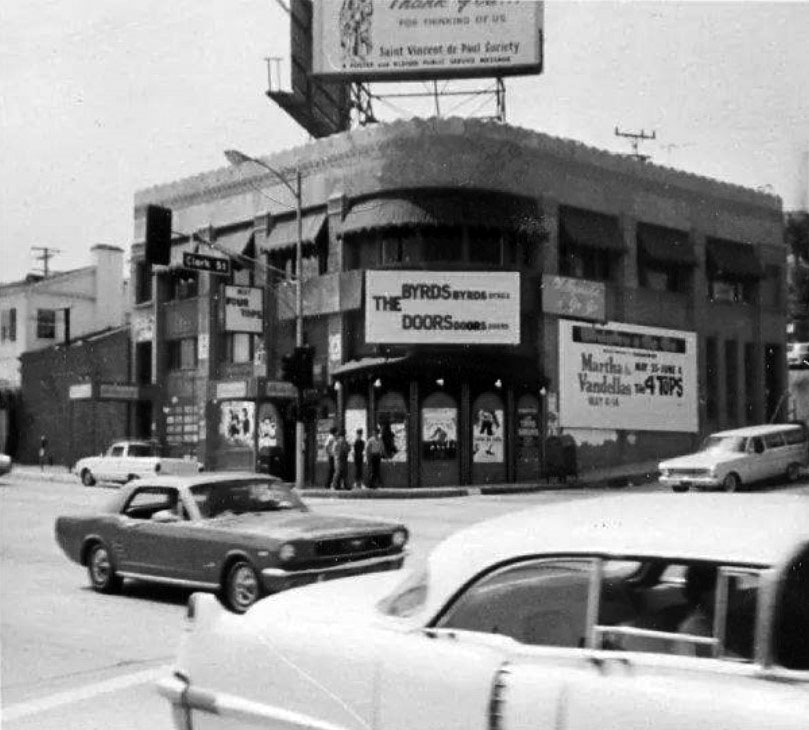 |
|
| (1967)* - View of the WHISKY A-GO-GO, located at 8901 Sunset Boulevard, on the Strip. Now playing: "The DOORS" & "The BYRDS" |
Historical Notes The Whisky played an important role in many musical careers, especially for bands based in Southern California. The Byrds, Alice Cooper, Buffalo Springfield, Smokestack Lightning and Love were regulars, and The Doors were the house band for a while—until the debut of the "Oedipal section" of "The End" got them fired. Van Morrison's band Them had a two-week residency in June 1966, with The Doors as the opening act. On the last night they all jammed together on "Gloria". Frank Zappa's Mothers of Invention got their record contract based on a performance at the Whisky.^ |
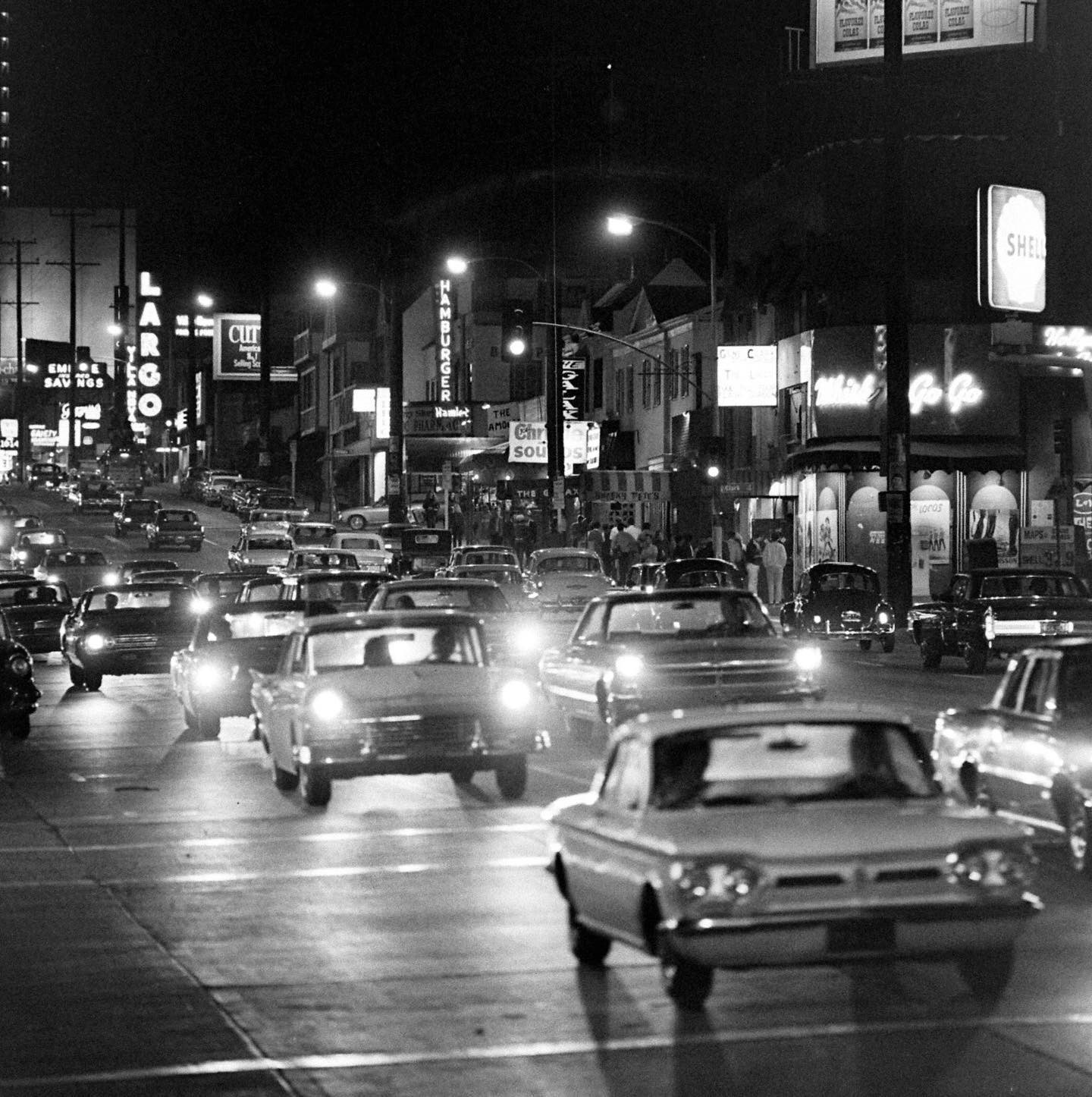 |
|
| (1966)* - Busy night on the Sunset Strip with the Whisky seen on the corner. Note the black-out “Y” on the sign. Also seen are Sneaky Pete's, The Galaxy Club, and Hamburger Hamlet. Signs for The Largo and Villa Nova are visible in the distance. Photo: Ralph Crane / LIFE Magazine |
Historical Notes The blacked-out "Y" on the sign at The Whisky was when the county revoked the club's dance permit around the time of the Sunset Strip Curfew Riots, stating that its name was a "bad influence" that promoted underage drinking. The Whisky responded by removing the "Y" from their sign and legally renaming themselves the "Whisk-A-Go-Go" and then obtaining a new permit.* |
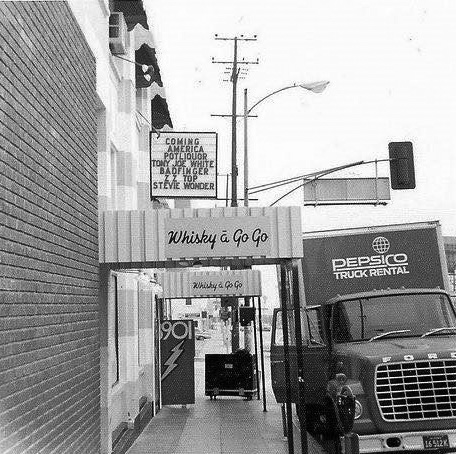 |
|
| (1972)^.^ - WHISKY A-GO-GO billboard shows “Coming Attractions” - America, Potliquor, Tony Joe White, ZZ Top, and Stevie Wonder. |
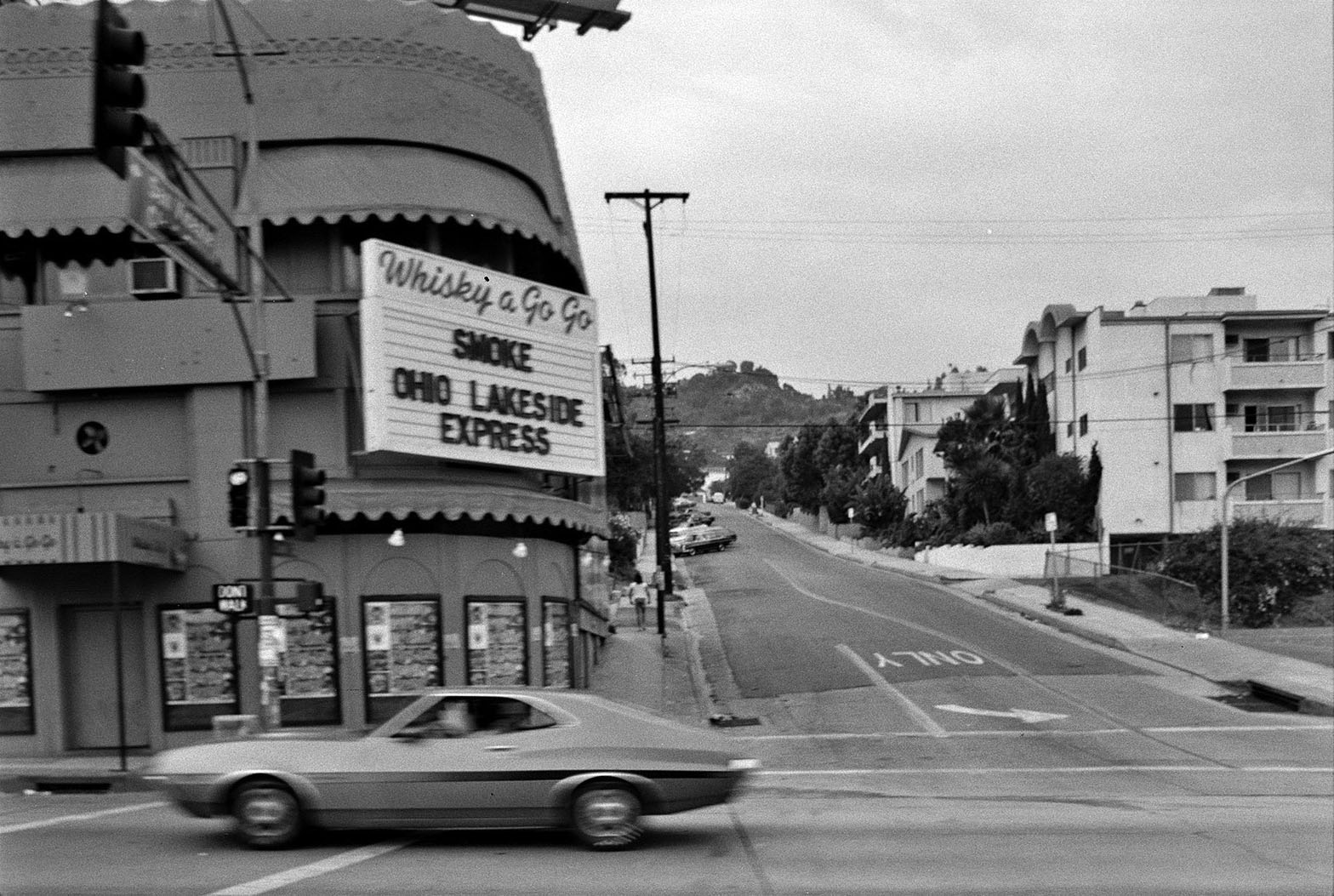 |
|
| (1974)* - Whisky A-Go-Go located on the NW corner of Sunset and Clark Street. Bands playing: Smoke and the Ohio Lakeside Express. Photo by Ed Ruscha / Getty Research Institute |
Historical Notes In the mid-1970s, the Whisky hosted stage presentations, including the long-running show The Cycle Sluts. During the early 1990s, the Whisky hosted a number of Seattle-based musicians who would be a part of the grunge movement, including Soundgarden, Mudhoney, Melvins, Fitz of Depression and 7 Year Bitch. In 1994 Oasis played a controversial set at the Whisky, with frontman Liam Gallagher visibly intoxicated. Immediately following the gig, lead songwriter Noel Gallagher temporarily left the group out of frustration, fleeing to San Francisco, where he penned the song Talk Tonight. In 1997, DownSet Headlining followed by Lambs Bread and System of a Down played at the Whisky. The band were unsigned at the time, and played songs from their early demo tapes, in particular containing the band's only live performance of the song "Blue".^ |
 |
|
| (2006)^ - Whisky A-Go-Go, 8901 W. Sunset Blvd., W. Hollywood. |
Historical Notes On September 12, 2016, the Whisky a Go Go launched an official TV channel on the Roku Connected TV platform. The Whisky a Go Go channel opens the Whisky's doors to a global audience with live music videos, full concerts and related content spanning its 52-year history.^ |
* * * * * |
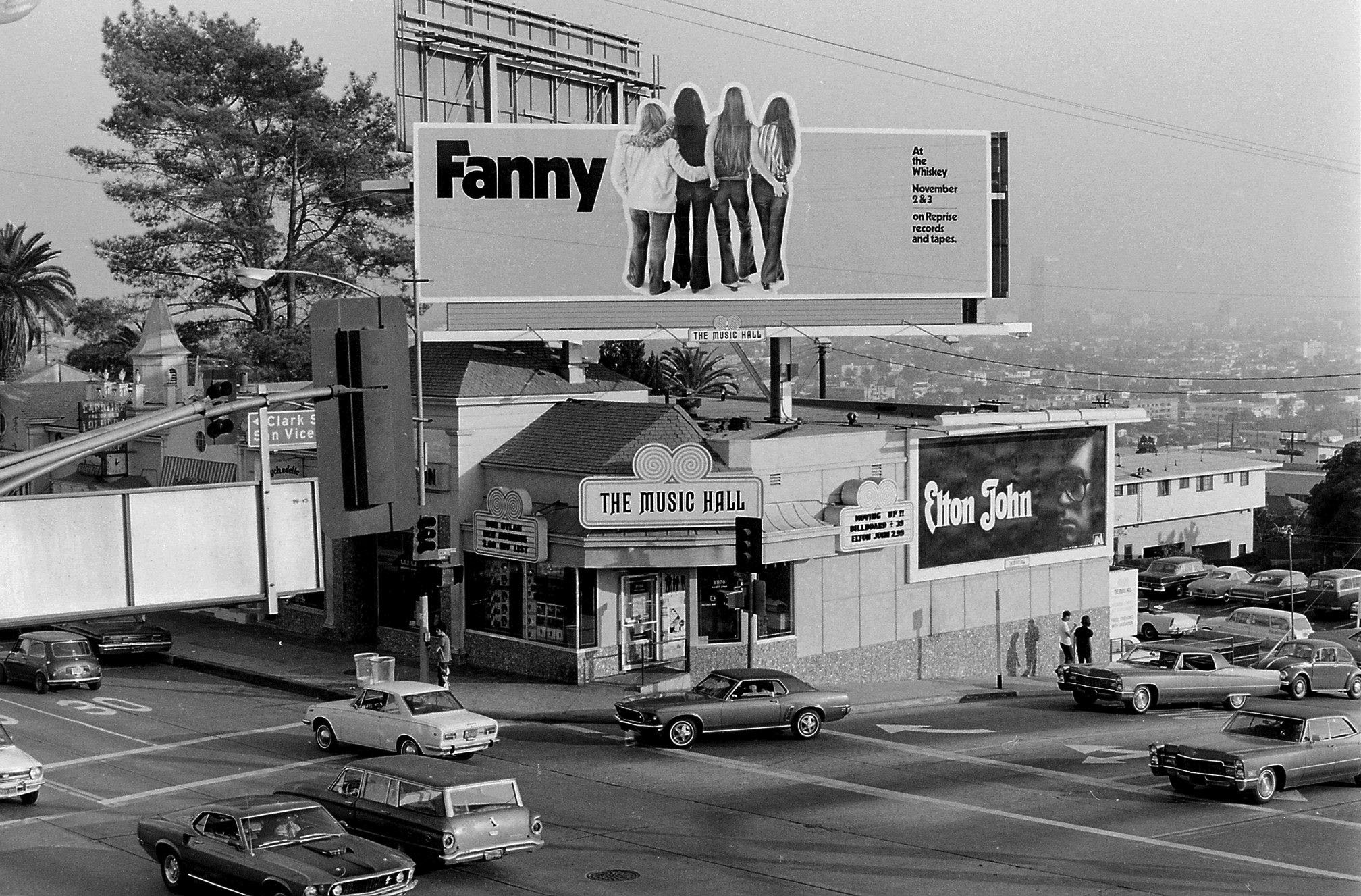 |
|
| (ca. 1970)##^* – View looking at the southeast corner of Sunset and San Vicente boulevards as seen from the 2nd floor of the Whisky A-Go-Go building. Shown here is The Music Hall (Record Store) with signboards on top and on the side of building. Click HERE to see contemporary view. |
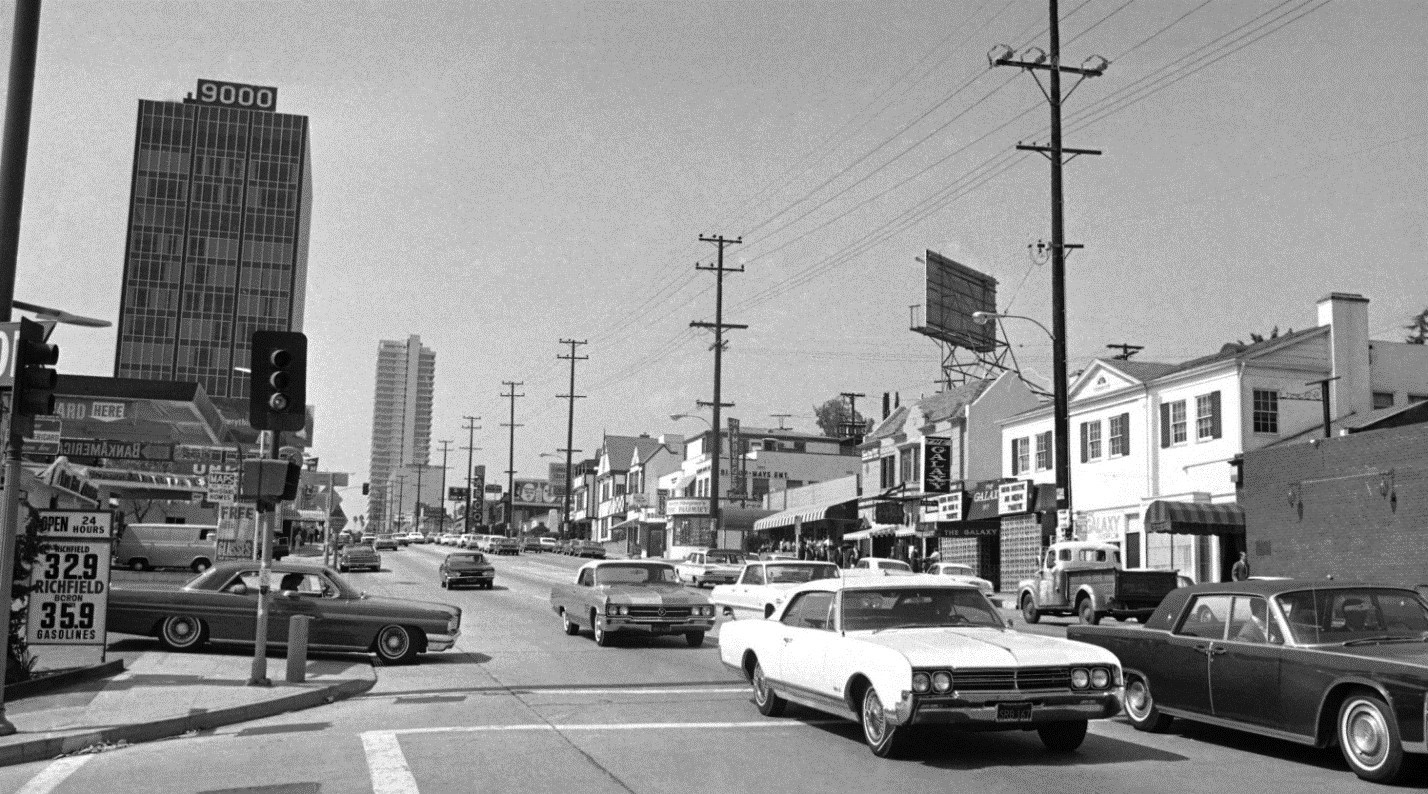 |
|
| (1960s)*# – View looking west on Sunset Boulevard at the intersection with N. San Vicente Boulevard. North of Sunset, San Vicente turns into Clark Street. On the southwest corner on the left is a Richfield Gas Station selling gas for 32.9 and 35.9 cents per gallon! |
Historical Notes After a bit of a slump in the 1950's, the Sunset Strip was revived in the 1960s with the opening of teen clubs Pandora's Box in 1962, Whisky A-Go-Go in 1964, modeled after the Chicago club of the same name, and Rose Deitch's Galaxy the same year. The Roxy Theatre and The London Fog opened in 1966. ###* This one block (seen above) was the throbbing heart of it all in the 1960s. Here, in between Clark and Hilldale, people were openly selling grass and acid. Love, on the Forever Changes album, have a song called, "Between Clark and Hilldale." |
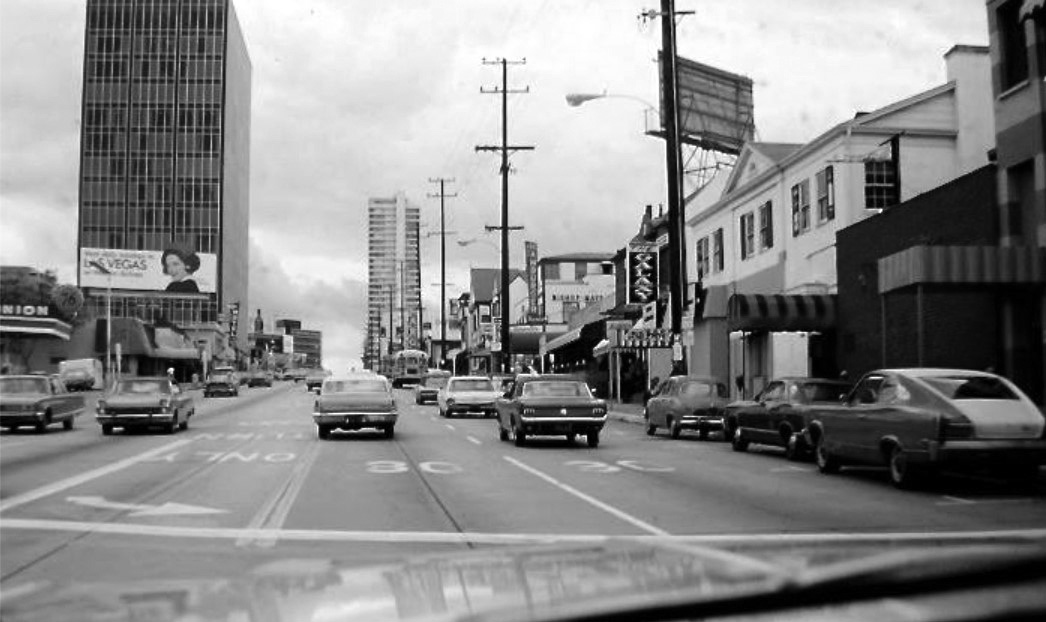 |
|
| (1968)^#^^ - View looking west on the Sunset Strip between Clark Street and Hildale Avenue. A '68 two-tone Rambler Marlin is parked directly in front of the Whisky A-Go-Go on the far right. |
Historical Notes On the far right, the building with the striped square awning is the Whisky A-Go-Go on the northwest corner of Sunset and Clark. The building with the arched awning to its left was Sneeky Pete's Night Club. The London Fog was the next building over (the Doors played there too). The next building over was the Galaxy with large sign and then on the next building, corner of Sunset and HIldale, stood the original Hamburger Hamlet. Further up the block you can see a sign for the Largo which is now The Roxy Theatre! Behind that was the Villa Nova - today The Rainbow.^#^^ By 1966, there were over a dozen music clubs on the Sunset Strip. The density of clubs on this short stretch of Sunset Boulevard resulted in late night crowds of young people that disturbed the neighbors and backed up traffic resulting in LA County Sheriffs enforcing a long-ignored 10 pm curfew for teens under 18, which had been on the books since 1939. ###* |
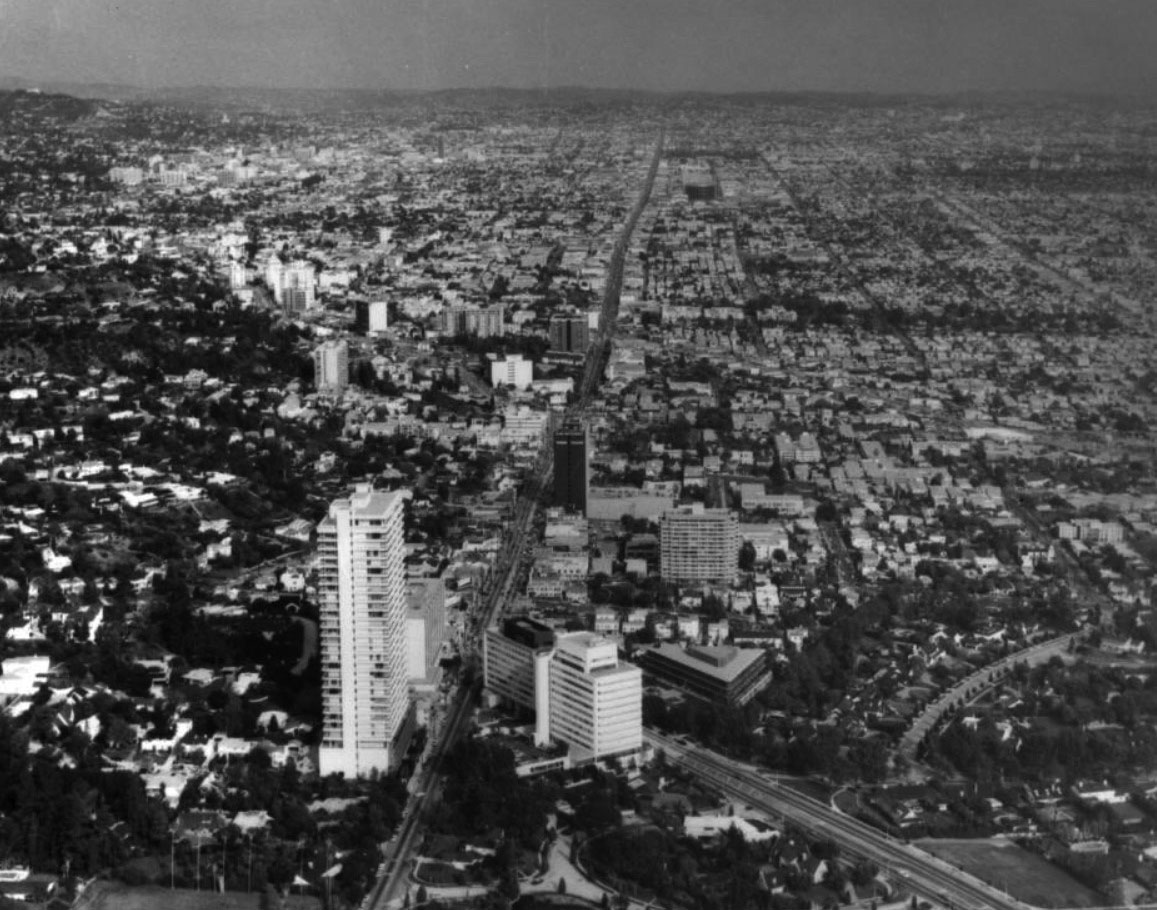 |
|
| (1968)^^ - Looking east down Sunset Boulevard (Hollyway Drive and Santa Monica Boulevard) at Doheny Road. Sunset veers to the left at center of photo. View is from above the northeast portion of West Hollywood just east of Beverly Hills. |
Gene Autry Hotel
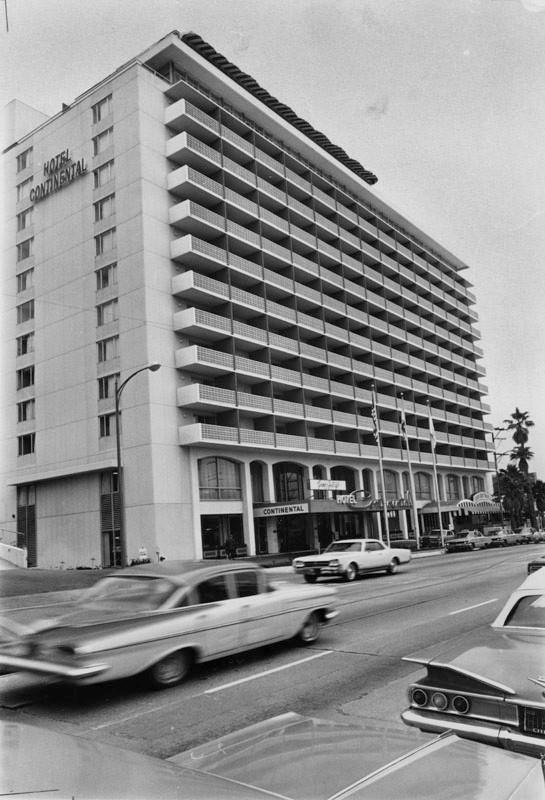 |
||
| (1966)* - View showing the 14-story Gene Autry Hotel on the Sunset Strip, located at 8401 Sunset Boulevard. |
Historical Notes The hotel opened in 1963 as the Gene Autry Hotel. Sold in 1967, it was renamed the Continental Hyatt House. In 1976 it became the Hyatt on Sunset until February 1997 when the hotel was renamed the Hyatt West Hollywood. In January 2009 the hotel was renovated and renamed the Andaz West Hollywood.*^ Click HERE to see contemporary view. |
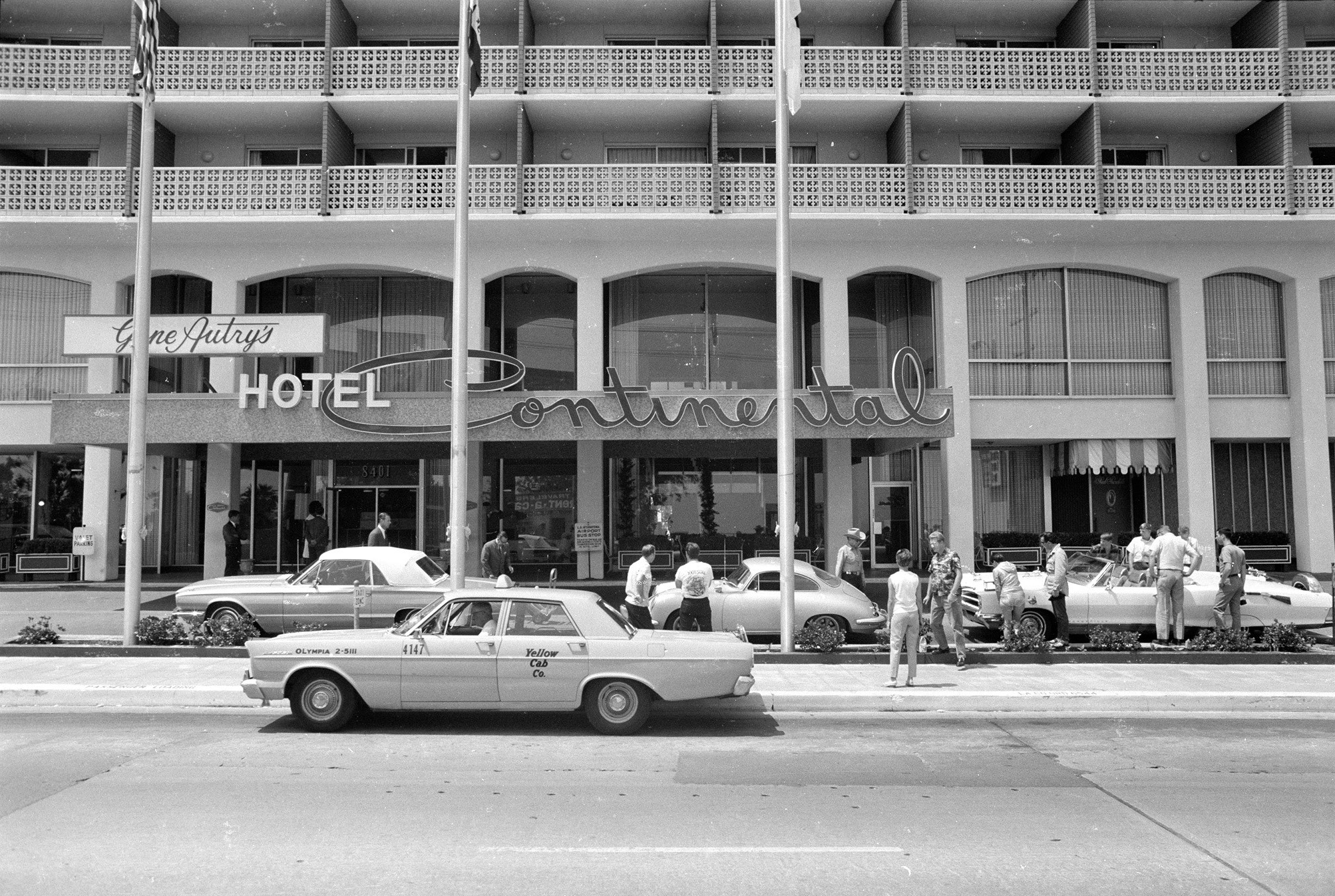 |
||
| (1966)^.^ - Gene Autry Hotel Continental as seen from across Sunset Boulevard with a 1965 Ford Galaxy taxi parked in front. |
Historical Notes Originally developed in 1963 as The Gene Autry Hotel Continental, it later become known as The Continental Hyatt House, and the Riot Hyatt as a reflection of its guests' propensity for partying. The hallowed halls have seen everything from Richard Cole (Led Zeppelin’s tour manager) riding his motorcycle through the hotel, to Keith Richards of the Rolling Stones (allegedly) tossing a television off of the balcony of room 1015. “We’ve since learned a few lessons and now the TVs are bolted to the walls and the balconies have been converted into sleek sunrooms,” noted Henning Nopper, the general manager at the Andaz West Hollywood. “Our history is one of Andaz West Hollywood's differentiating factors and is something we’re extremely proud of, so we definitely try and pay homage to that when we can.”* |
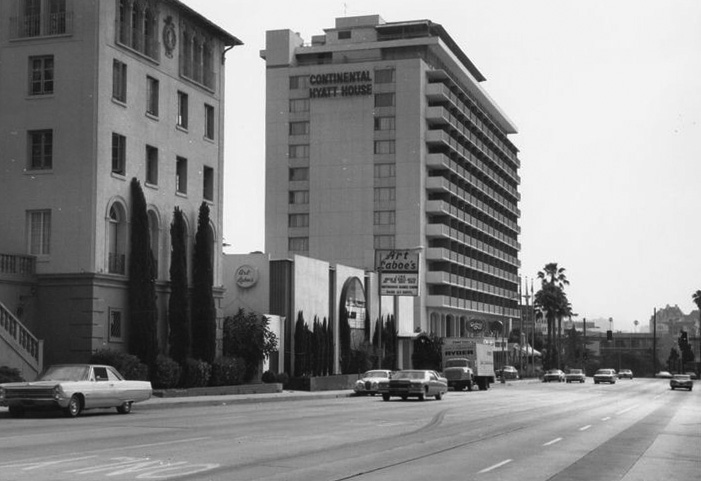 |
||
| (ca. 1967)^.^– View showing the Continental Hyatt Hotel on the Sunset Strip -- and note that Ciro's/the Comedy Store was called Art Laboe's. |
Historical Notes In the late 1960s and 1970s the hotel's proximity to popular clubs such as the Whisky a Go Go made it the preferred Los Angeles accommodation for touring rock groups, notably English bands Led Zeppelin, The Who and the Rolling Stones. It was often referred to at the time as the Riot House, a play on the name Hyatt House. In 1976 the hotel became the Hyatt on Sunset. In February 1997, the hotel was renamed the Hyatt West Hollywood. The hotel was renovated in 2008 and reopened on January 8, 2009 as the Andaz West Hollywood, the second Andaz hotel in the new brand by Hyatt Hotels and Resorts. The 14-story Andaz West Hollywood has 239 rooms, including 20 suites and a restaurant called RH (“Riot House”). The renovation was completed by New York-based architecture and interior design firm Janson Goldstein LLP and includes a hand-painted metal disk 11-foot sculpture by renowned New York-based artist Jacob Hashimoto. The balconies made famous by stories of rock stars throwing televisions from them are now glass-enclosed sunrooms that overlook Sunset Boulevard. |
* * * * * |
PJ`s Nightclub
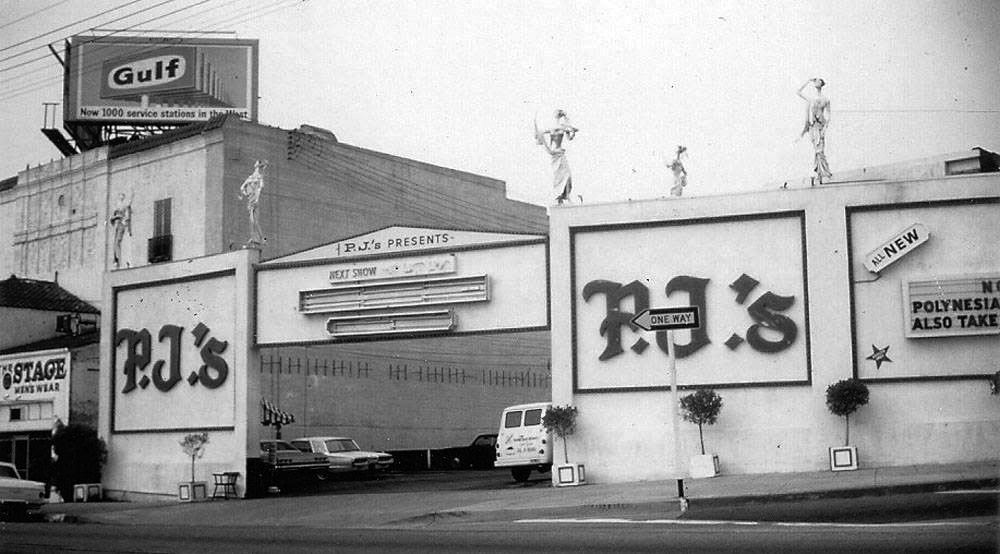 |
|
| (1960s)^ – View showing PJ’s Nightclub located on the northwest corner of Santa Monica and Crescent Heights Blvd in West Hollywood. Note the sculptures along the roofline. |
Historical Notes PJ's opened in 1961 as a late night hot spot that nightclub performers and other Hollywood celebrity types went to after the other clubs closed down. It hosted such acts as The Bobby Fuller Four, The Standells, Rufus Thomas, and Trini Lopez who recorded live albums there. The manager was Elmer Valentine before he left to found the Whisky A-Go-Go. |
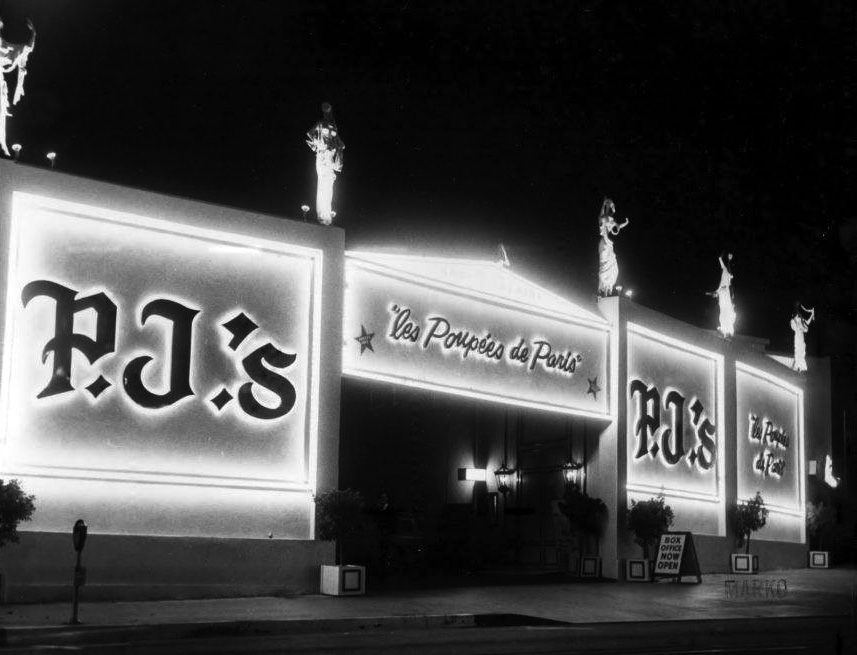 |
|
| (1960s)* – Night view showing the entrance to P.J.’s Nightclub featuring “les Pupees de Paris”. |
Historical Notes Les Poupées de Paris (The Dolls of Paris) was a musical puppet show created, produced and directed by Sid and Marty Krofft, that toured the United States throughout the 1960s. By 1966 PJ's had been bought by an organized crime figure, Eddie Nash and reputed organized crime figure Dominic Lucci, and was managed by Gary Fontenot (not an organized crime figure) for many years. In 1973, after Nash bought out Lucci's ownership interest in the club, it became The Starwood. It closed in 1981, torn down by the City, after too many citations for underage drinking and noise abatement issues. Before it was demolished it caught fire, though not burning totally. This occurred while unexplained fires befell other Nash-owned properties at the time.* Subsequently the structure was torn down, and a mini-mall (Crescent Heights Plaza) was built on the site. Click HERE for contemporary view. |
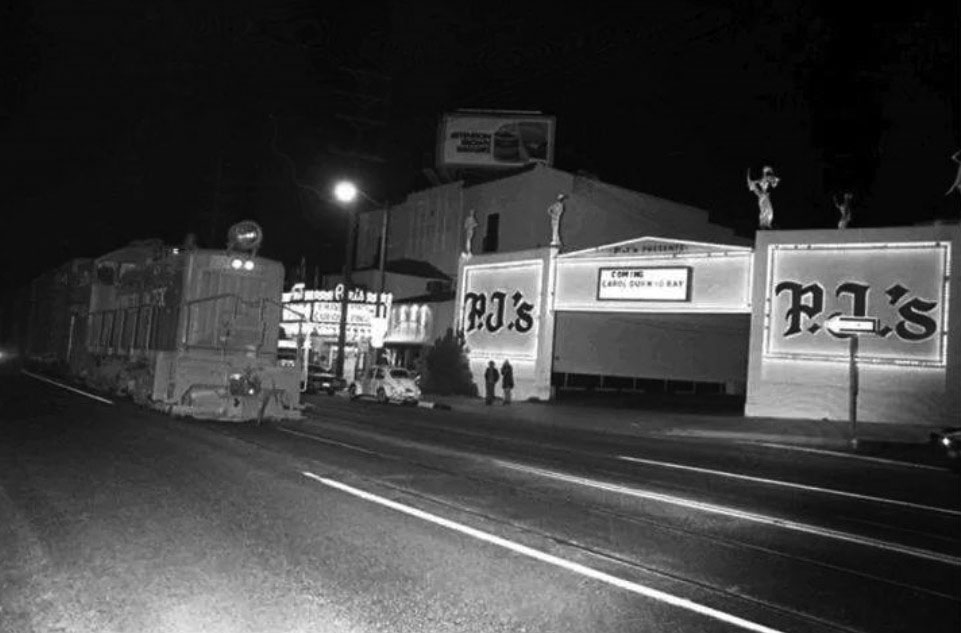 |
|
| (1968)* – View of a train passing by PJ`s Nightclub located at 8151 Santa Monica Boulevard. Southern Pacific freight trains ran down the middle of Santa Monica Blvd until the mid 70`s. |
Historical Notes The tracks running down the center of Santa Monica Boulevard were part of the Pacific Electric Railway since 1911 and carried red cars until the 1950s. They then remained largely unused for decades, serving the occasional Southern Pacific freight train through the 1970s. It was not until 1999 that the West Hollywood segment of the tracks were dug up and replaced by a landscaped median. |
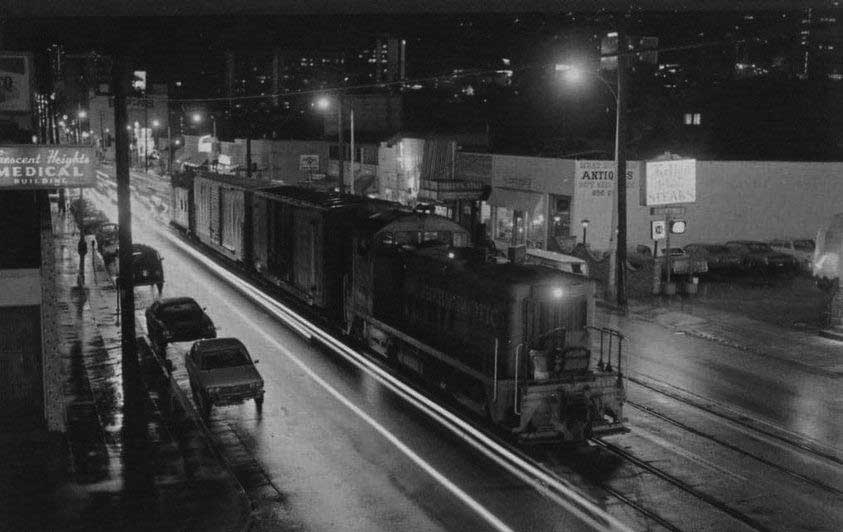 |
|
| (1972)^ - A freight train heads east through West Hollywood on the old Route 66 (Santa Monica Blvd) during the winter. Crescent Heights Medical Building is seen on the left. |
Historical Notes This was the last regular midnight run of a freight train down Route 66 (Santa Monica Blvd., West Hollywood), in May, 1972. |
Pandora's Box
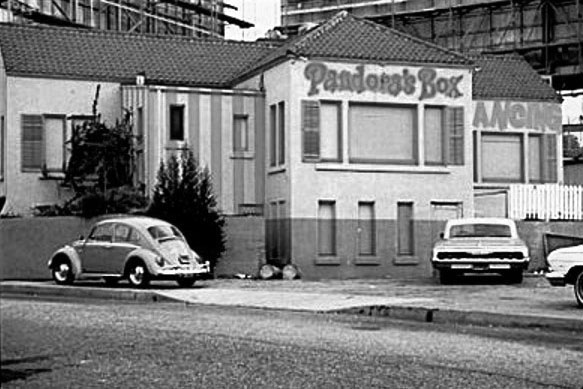 |
|
| (1960s)* – View showing Pandora’s Box Nightclub, located at the corner of Sunset Boulevard and Crescent Heights Boulevard. It was at the center of the Sunset Strip curfew riots in the mid-1960s. |
Historical Notes In the late 1950s Pandora's Box was a popular coffeehouse located at 8118 Sunset Boulevard, on the corner of Sunset Boulevard and Crescent Heights Boulevard. Home to some of the more adventurous artists in town, Pandora's Box hosted up-and-coming jazz musicians such as Les McCann and Carla Bley, while artist Burt Shonberg adorned the interior of the club with a mural similar to his works in the famous Cafe Frankenstein and The Purple Onion.^ |
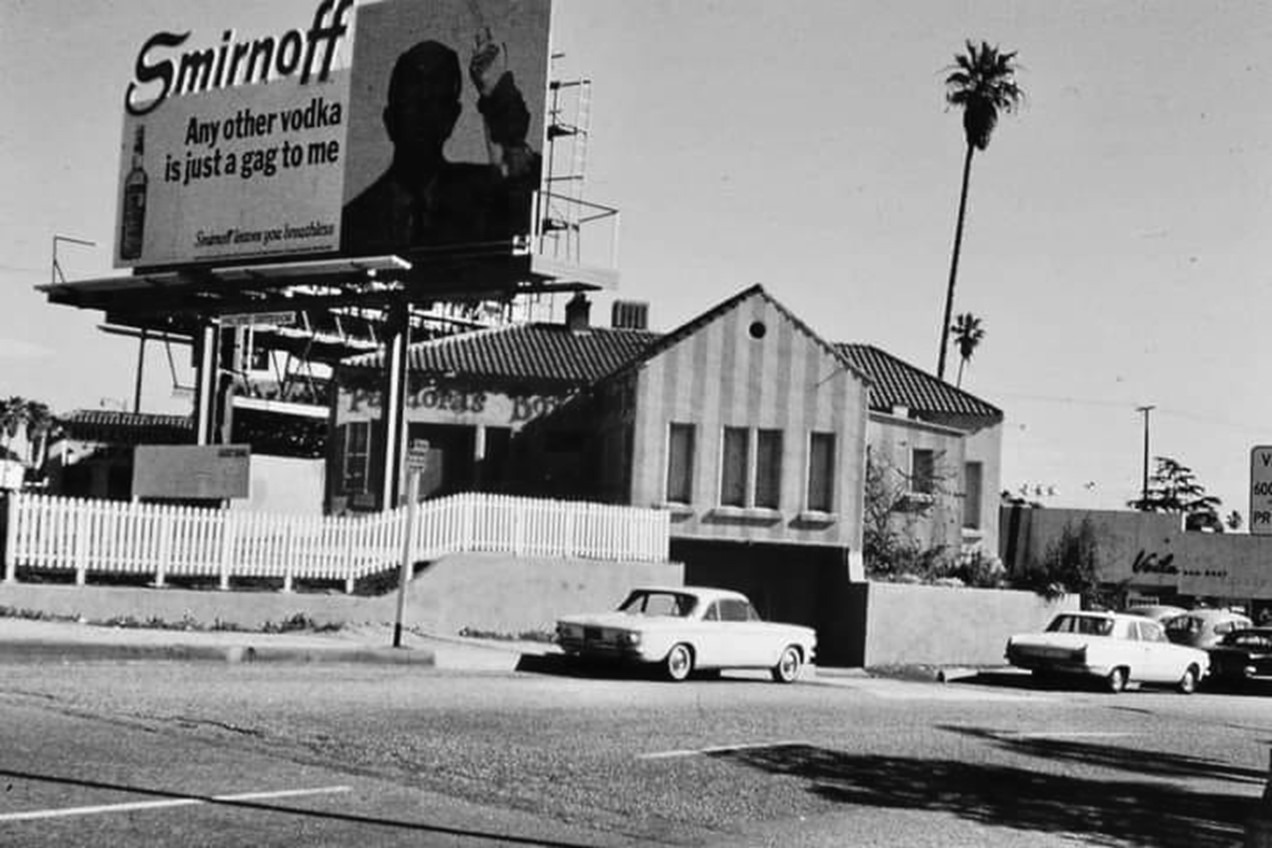 |
|
| (1967)* - Pandora’s Box, 8118 Sunset Blvd, West Hollywood. |
Historical Notes In 1966, annoyed residents and business owners in the district had encouraged the passage of a strict 10:00 pm curfew and loitering law to reduce the traffic congestion resulting from crowds of young club patrons. This was perceived by young, local rock music fans as an infringement on their civil rights, and on Saturday, November 12, 1966, fliers were distributed along the Strip inviting people to demonstrate later that day. Hours before the protest, one of L.A's rock 'n' roll radio stations announced there would be a rally at Pandora's Box. The Los Angeles Times reported that as many as 1,000 youthful demonstrators, including such celebrities as Frank Zappa, Sonny and Cher, Jack Nicholson and Peter Fonda (who was afterward handcuffed by police), erupted in protest against the perceived repressive enforcement of these recently invoked curfew laws.^ |
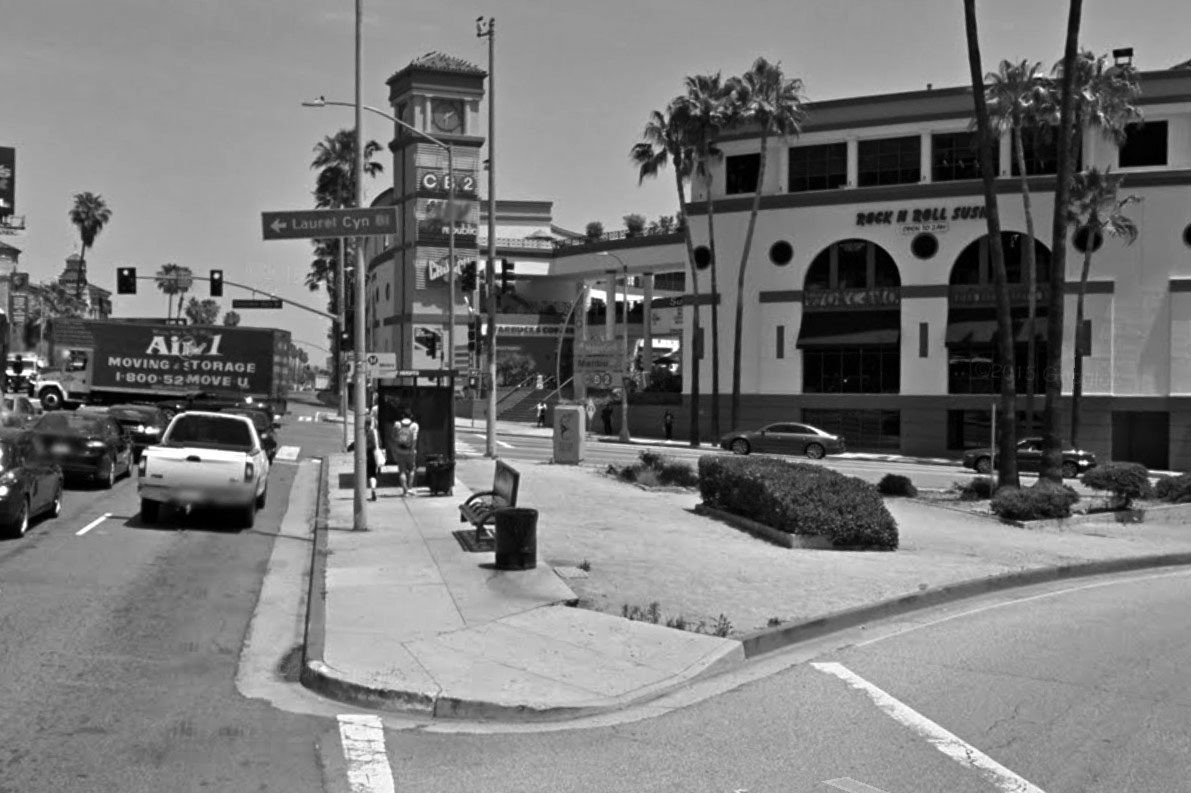 |
|
| (2016)* – Google street view showing the spot where Pandora’s Box once stood. Today, it is a traffic island. |
Historical Notes In November 1966, the Los Angeles City Council voted to acquire and demolish the club. The club was demolished in early August 1967 and today, the site exists as a traffic island. The 1967 film Riot on Sunset Strip is a fictionalized depiction of the events. Buffalo Springfield's 1967 hit single, "For What It's Worth (Stop, Hey, What's That Sound)," was written by group member Stephen Stills in response to the riot.^ |
Canyon Country Store
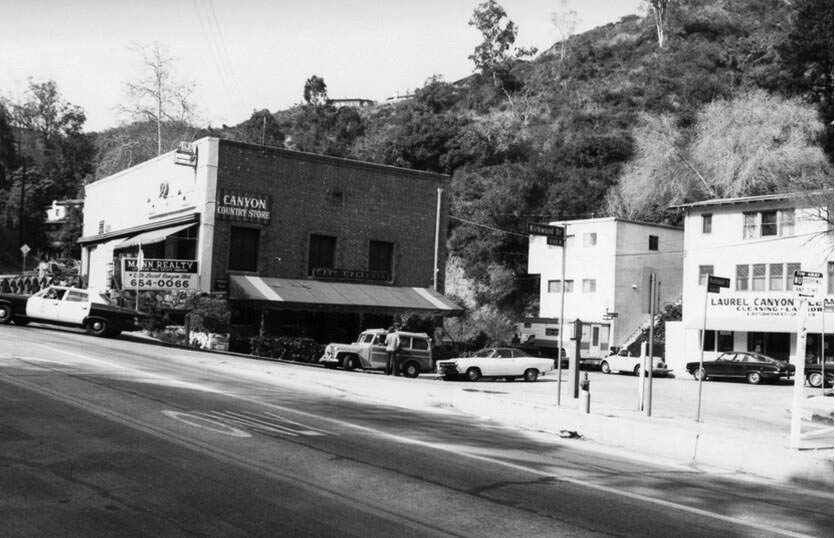 |
|
| (1968)* - View looking north on Laurel Canyon Blvd at Kirkwood Drive showing the Canyon Country Store on the northeast corner. |
Historical Notes The Canyon Country Store has been the makeshift cultural center of Laurel Canyon for a full century. Immortalized in the Doors song "Love Street," this deli-market is not a venue, but it's got historical music importance to spare, and continues to be -- as Jim Morrison put it -- the "store where the creatures meet." Known for its winding narrow streets and terrifying mudslides, Laurel Canyon became a part of the city of Los Angeles in 1923. Its close proximity to Hollywood and ample unused hillside attracted the film industry's elite "photoplayers" including Clara Bow, Errol Flynn and Harry Houdini.^ |
.jpg) |
|
| (2015)* - View looking north on Laurel Canyon Blvd at Kirkwood Drive showing the Canyon Country Store on the northeast corner. Same view as above but 47 years later. |
Historical Notes Throughout the '60s and '70s, the Laurel Canyon Country Store acted as a meeting place for musicians to write songs together and jam on the market's front patio. Joni Mitchell wrote Ladies of the Canyon and Nash wrote CSNY's "Our House" about the neighborhood.^ |
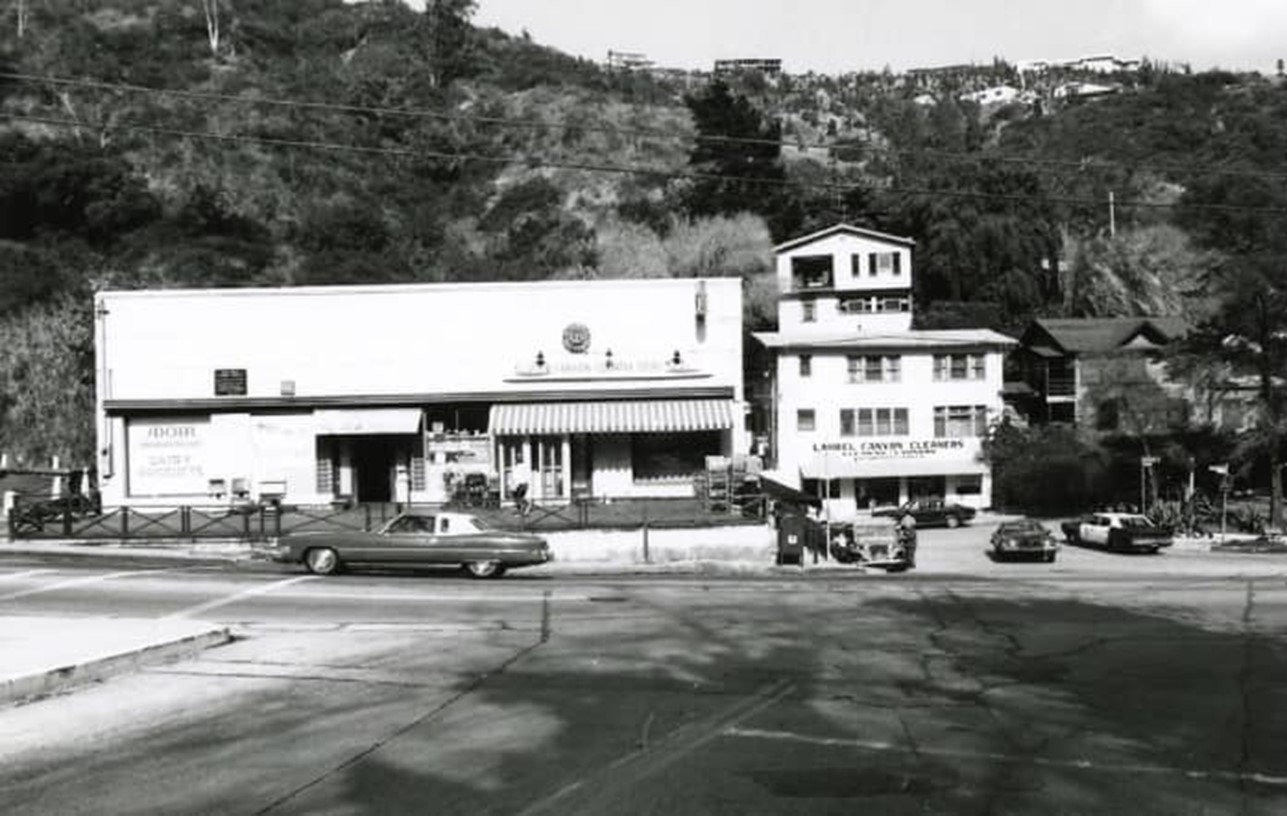 |
|
| (1974)* – Looking east on Kirwood Drive toward Laurel Canyon showing the Canyon Country Store. |
Historical Notes On what was the main connecting road between the San Fernando Valley and Hollywood, the artists hung out in the open. Mama Cass Elliot of the Mamas and the Papas lived in the shop's basement (now a fancy wine cellar) for a spell, where she penned "Twelve Thirty," better known by its chorus "Young girls are coming to the Canyon."^^ |
Then and Now
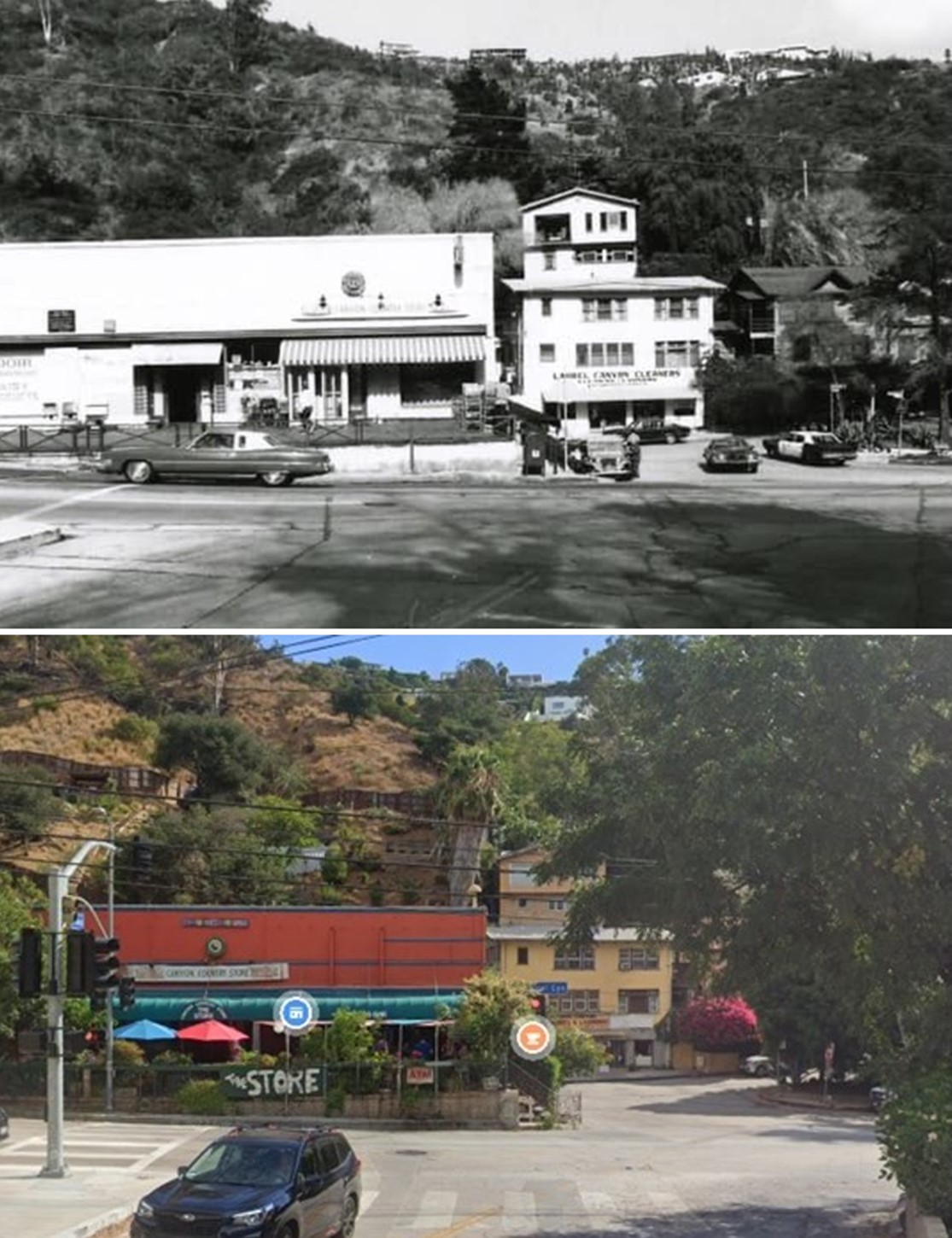 |
|
| (1974 vs. 2022)* – Looking east on Kirkwood Drive toward Laurel Canyon showing the Canyon Country Store. |
Yellow Submarine
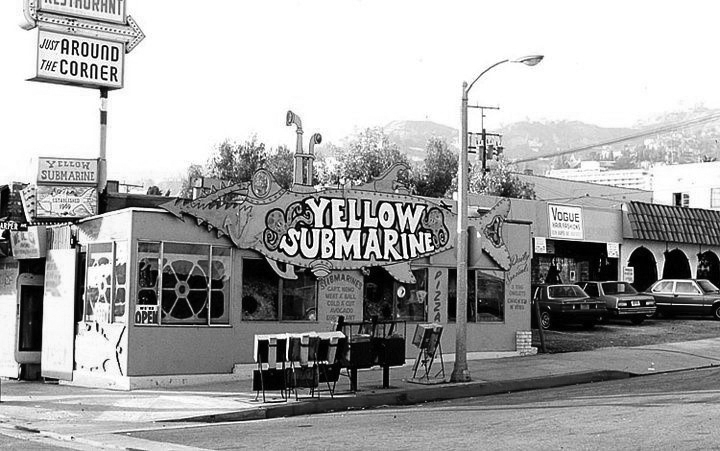 |
|
| (1979)* – View showing the Yellow Submarine located on the northwest corner of Santa Monica Boulevard and N. Harper Avenue in West Hollywood. |
Historical Notes The Yellow Submarine was a favorite hangout for Fairfax High School kids in the 1970s. Also known for its Avacado sandwiches. |
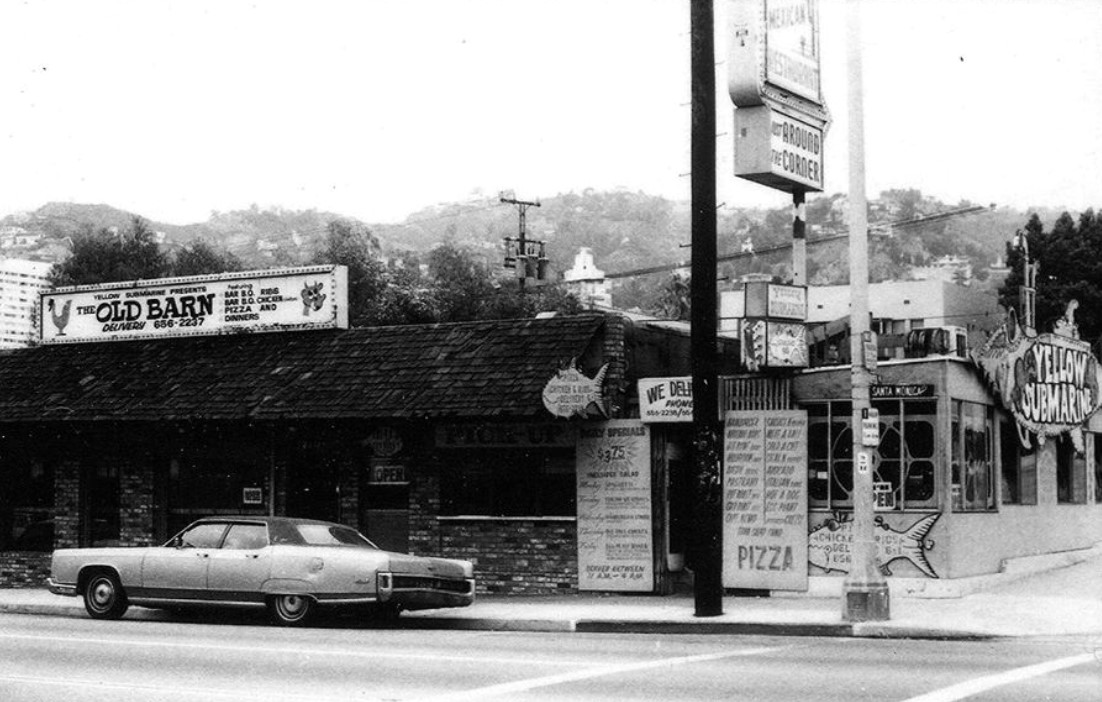 |
|
| (1982)^#^^ - View looking at the northwest corner of Santa Monica Boulevard and N. Harper Avenue showing the Yellow Submarine with the Old Barn to its left. The corner is now occupied by a Mexican restaurant. Click HERE for contemporary view. |
Santa Monica and Fairfax
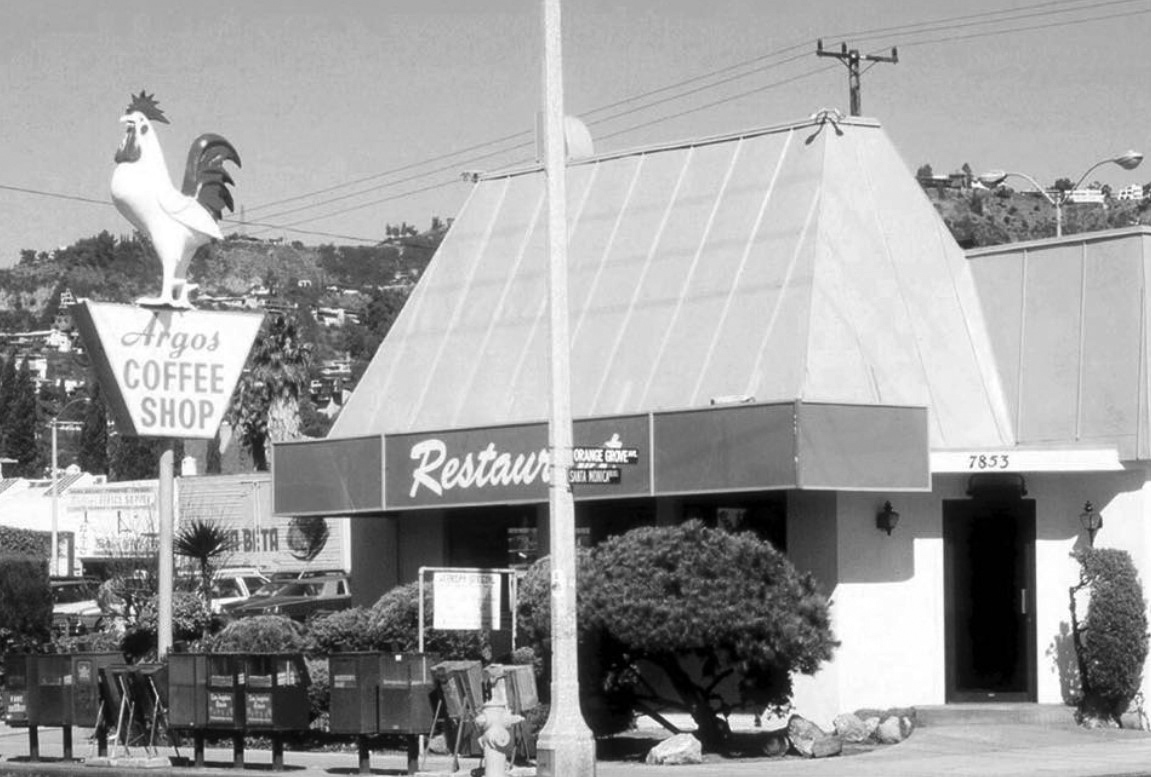 |
|
| (ca. 1970)^.^ - View looking at the northwest corner of Santa Monica Boulevard and Orange Grove Avenue showing the Argos Coffee Shop. To the left is a shopping center located on the NE corner of Santa Monica and Fairfax where Alpha Beta can be seen. |
Historical Notes 'Alpha Beta' 1970s & 80s, became 'Boys' and then 'Ralphs' 1990s, turning-into 'Whole Foods' this millennium... |
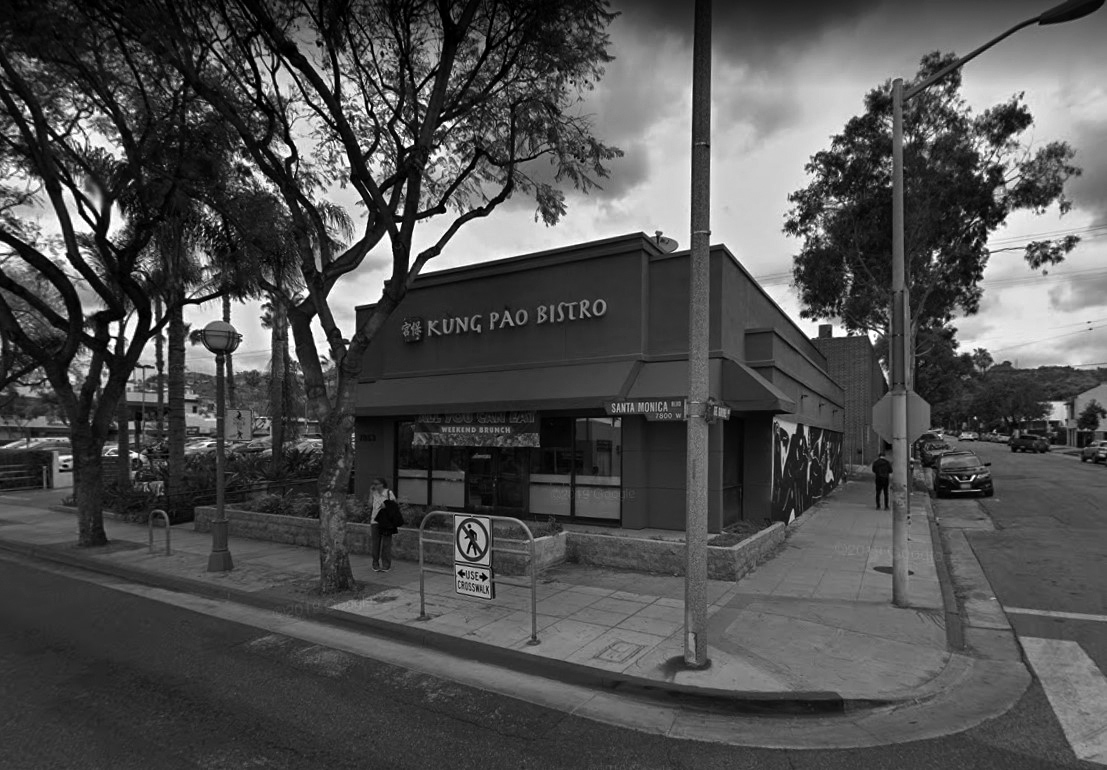 |
|
| (2019)^ - Contemporary view of the NW corner of Santa Monica and Orange Grove showing Kung Pao Bistro standing where Argos Coffee Shop used to be, more than likely in the same building after modifications. Whole Foods stands in the shopping center just behind the restaurant (out of view). |
Formosa Café
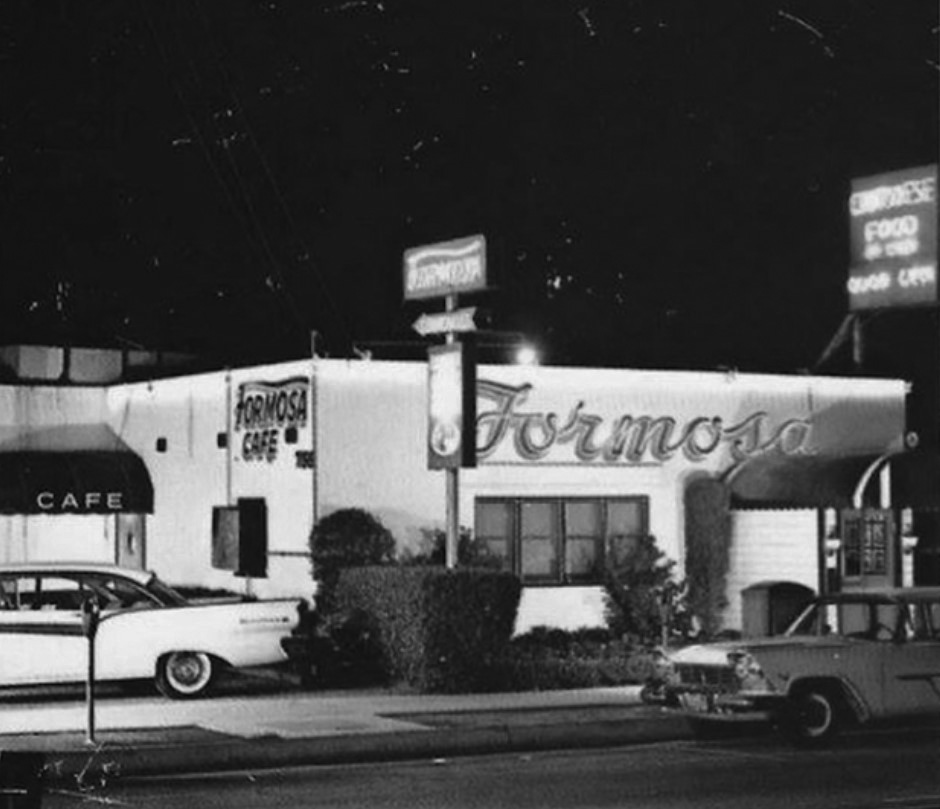 |
|
| (1950s)* - View showing the Formosa Café located at 7156 Santa Monica Boulevard in West Hollywood. |
Historical Notes Designated a local cultural resource by the City of West Hollywood, the Formosa had the good fortune of being located just steps from the Pickford-Fairbanks Studios, which was founded in 1919 and was later known as United Artists Studio, Samuel Goldwyn Studio, Warner Hollywood Studios, and currently The Lot since 1999. |
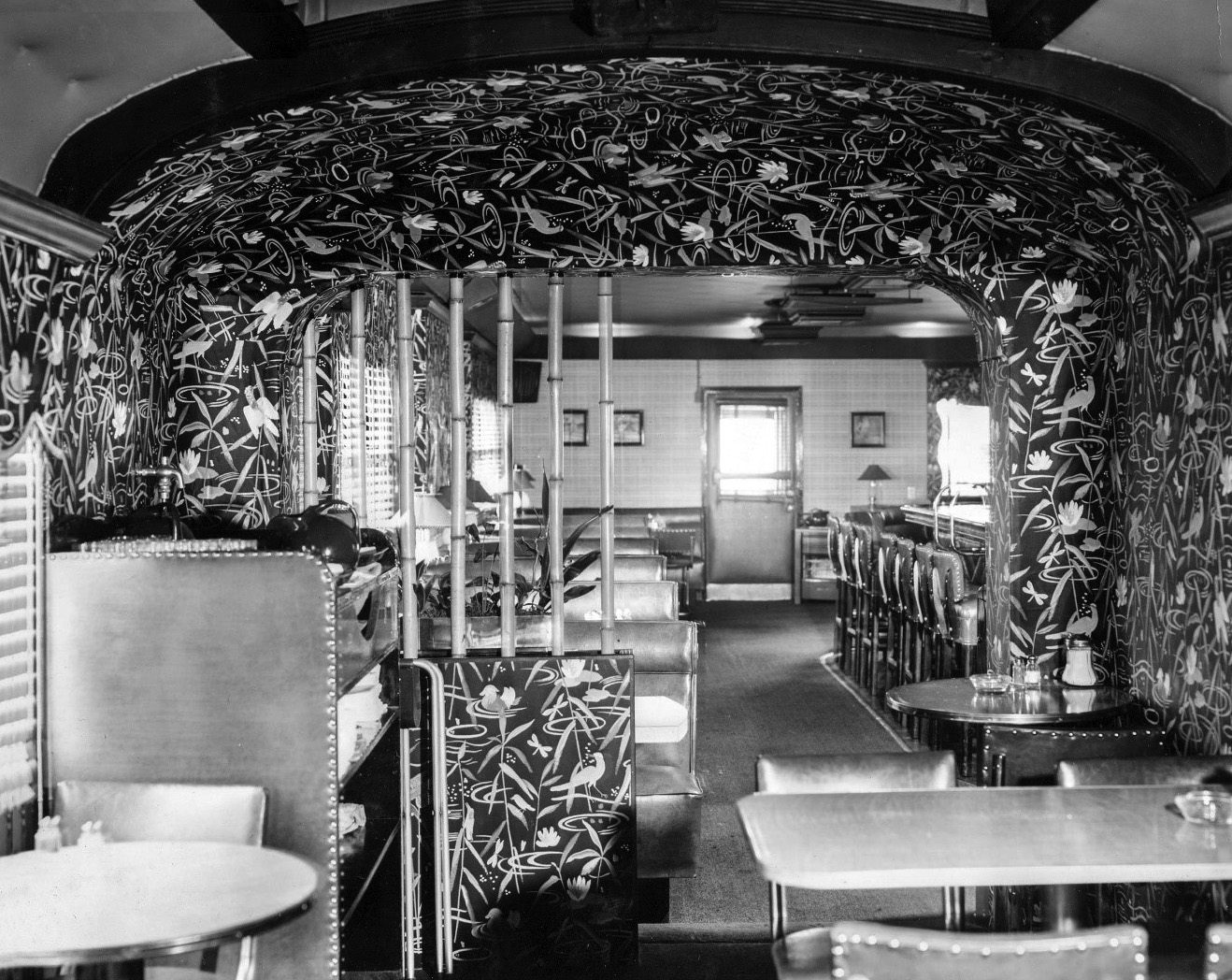 |
|
| (1933)^ – View showing the interior of the Formosa Café located at the SE corner of Santa Monica Blvd and Formosa Ave. Photo courtesy of the 1933 Group |
Historical Notes The Formosa was founded in 1925 by 1920s prize-fighter Jimmy Bernstein. Bernstein operated his establishment initially in a Red Car trolley located just east of The Lot Studios. In 1945, Lem Quon went into partnership with Bernstein, taking full ownership in 1976 when Berstein died. The restaurant remains in the family with Quom's grandson, Vince Jung, managing it.^ |
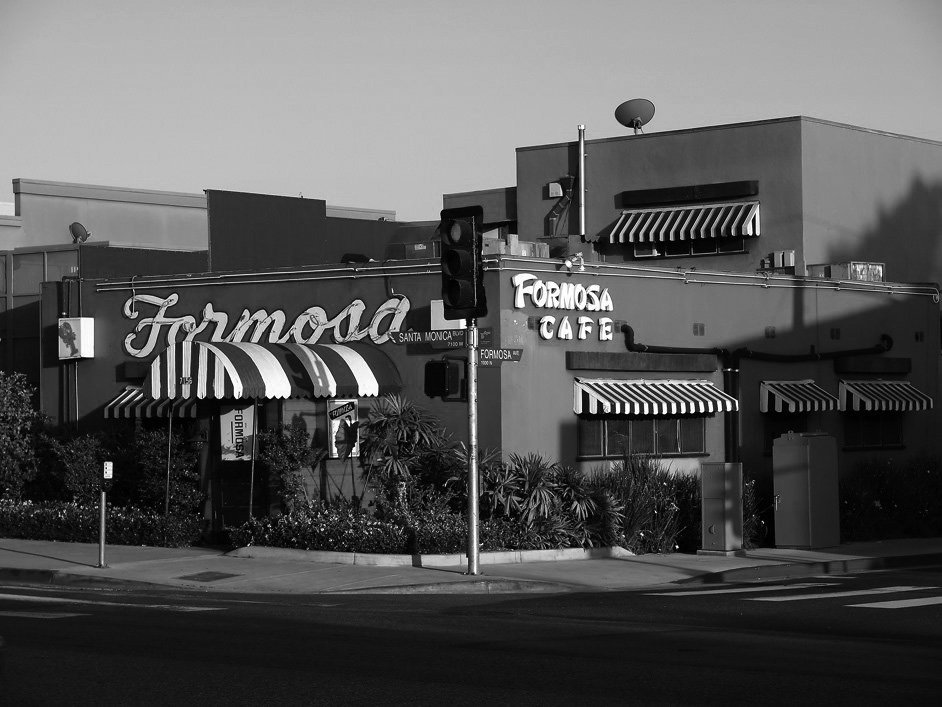 |
|
| (2007)*^ - Dusk view looking at the SE corner of Formosa Ave and Santa Monica Blvd, showing the Formosa Café. Photo by Gary Minnaert / Wikipedia |
Historical Notes Icons like Frank Sinatra, Marilyn Monroe, Humphrey Bogart, James Dean, and Elvis Presley would pop into the Formosa, adding to its reputation as one of Hollywood's most infamous and longest-running celebrity hangouts. |
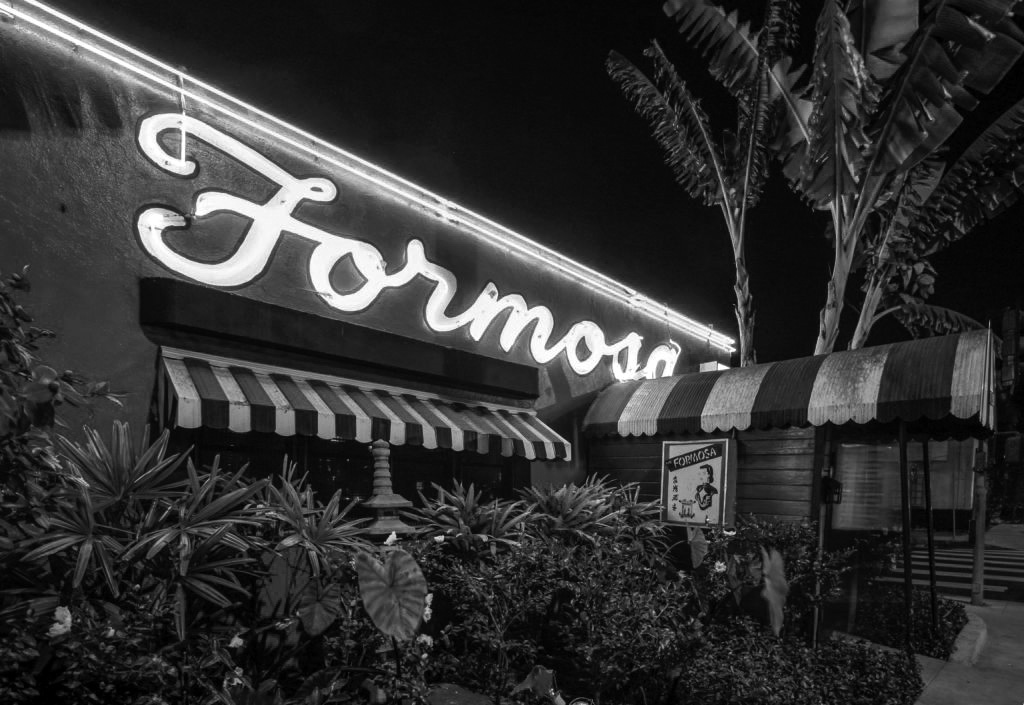 |
|
| (2010s)* – Night view showing the Formosa Café neon lights on face of building. Photo courtesy of the 1933 Group |
Historical Notes During the filming of Some Like it Hot, Marilyn Monroe frequented the legendary haunt and her photo still graces the restaurant's walls. In 2015, the restaurant's original red-and-black 1940s interiors were gutted and a "modern" interior was installed, despite clientele who enjoyed the nostalgic ambience. After negative reactions to the change, much of the original interior was rebuilt. Less than 18 months after the gutting, just before Christmas of 2016, the Formosa Cafe closed without advance notice.^ |
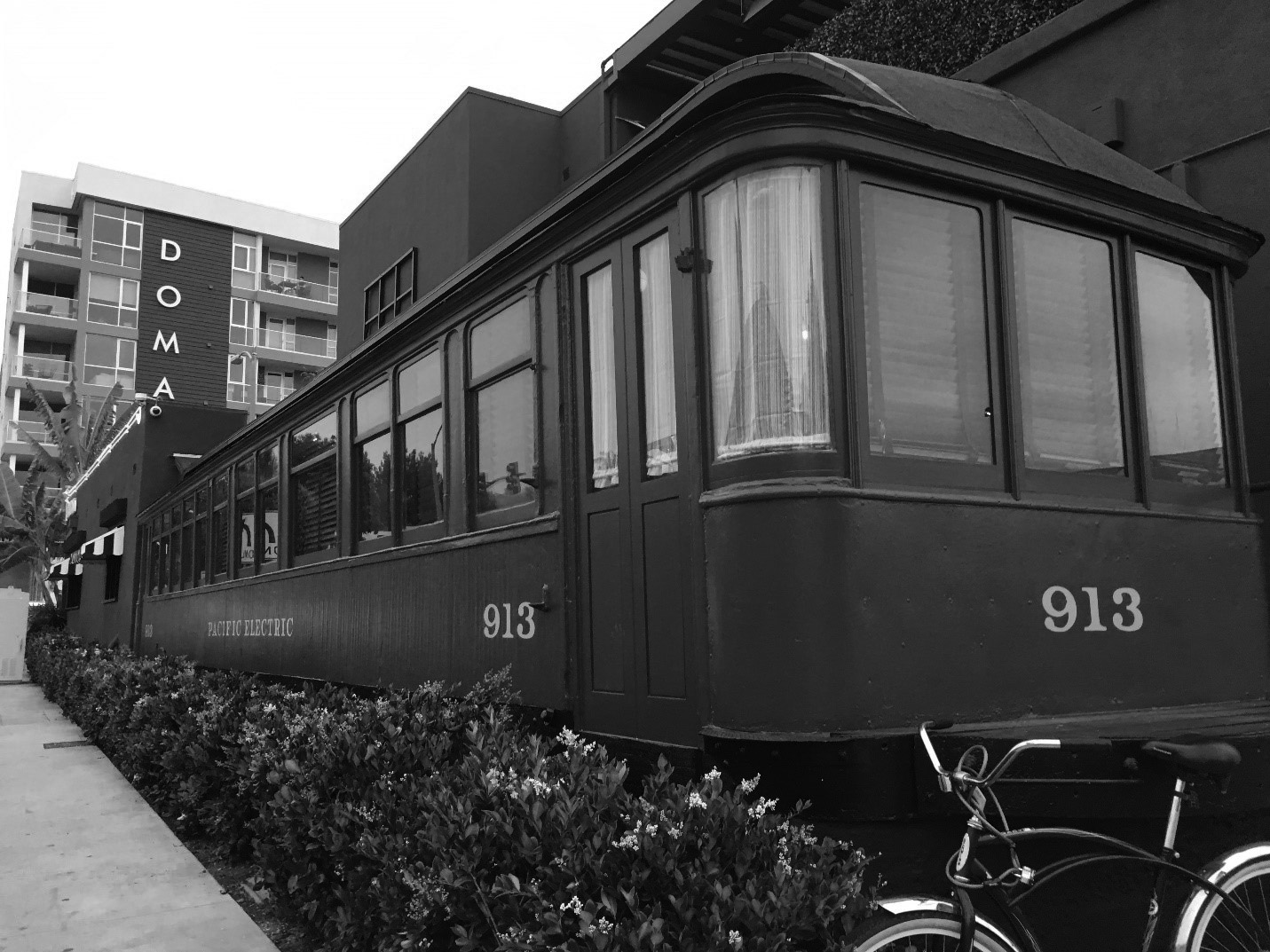 |
|
| (2019)* – View looking north on Formosa Ave showing a vintage streetcar as part of the Formasa Café with the Domain WeHo Apartments seen in the background (NE corner of Santa Monica and Formosa). Note the bicycle in the lower-right. |
Historical Notes Located just beyond the main bar, the fully revealed and restored Pacific Electric Red Car trolley dates to 1904 and is confirmed to be the oldest surviving Red Car in existence. Like the main bar, the 36-seat trolley is lined with celebrity photos installed above two- and four-seat banquettes. |
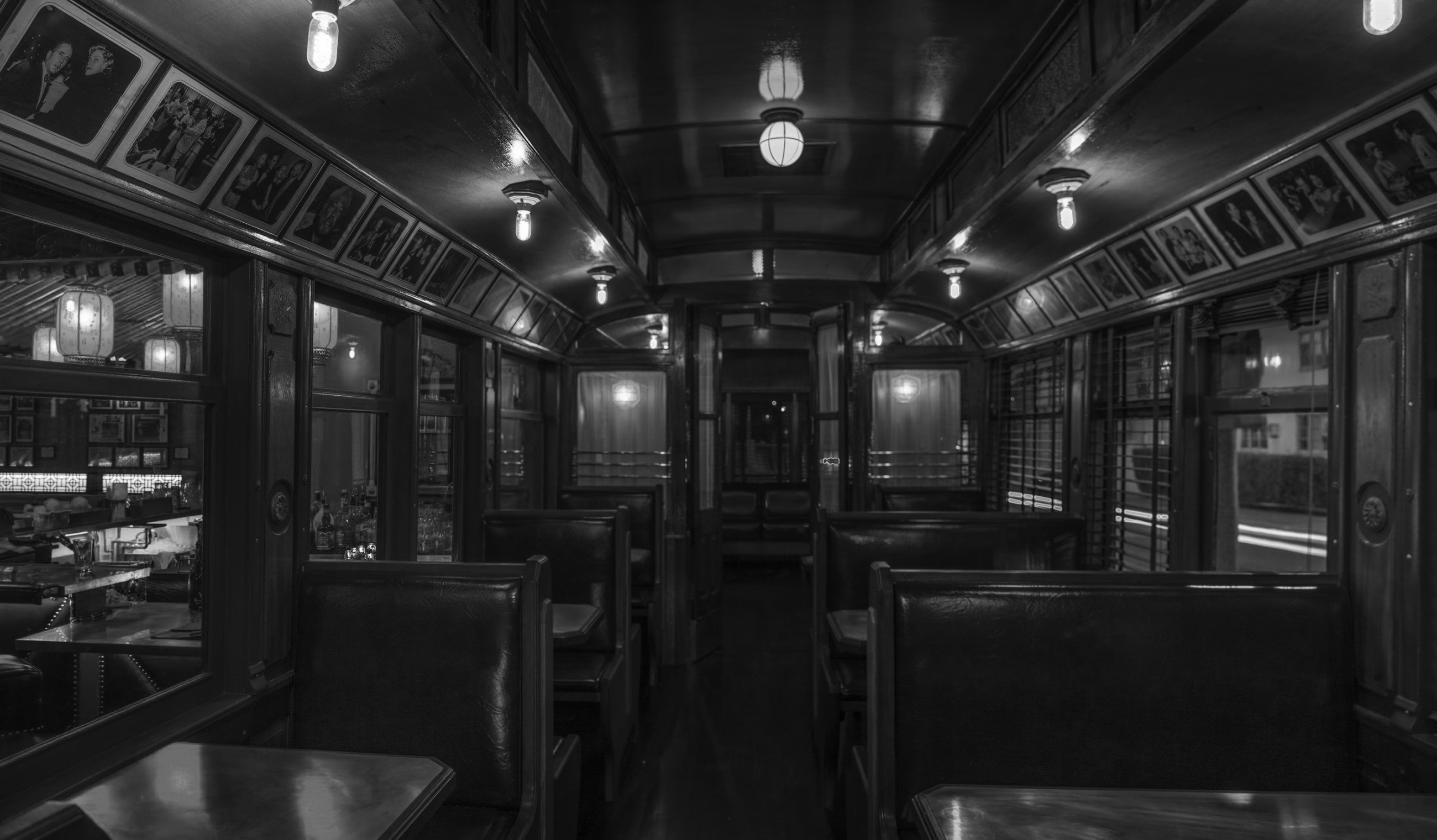 |
|
| (2019)^ - Interior of the Pacific Electric Red Car trolley at the Formosa Cafe | Photo by Maxim Shapovalov |
Historical Notes A discreet VIP room at the rear of the Red Car can host an additional 20 guests. Mickey Cohen reportedly ran his operations and called bookies from this back room, which has its own entrance. As an homage, Green installed a vintage rotary phone for guests to call in drink orders, which are served through a private window. |
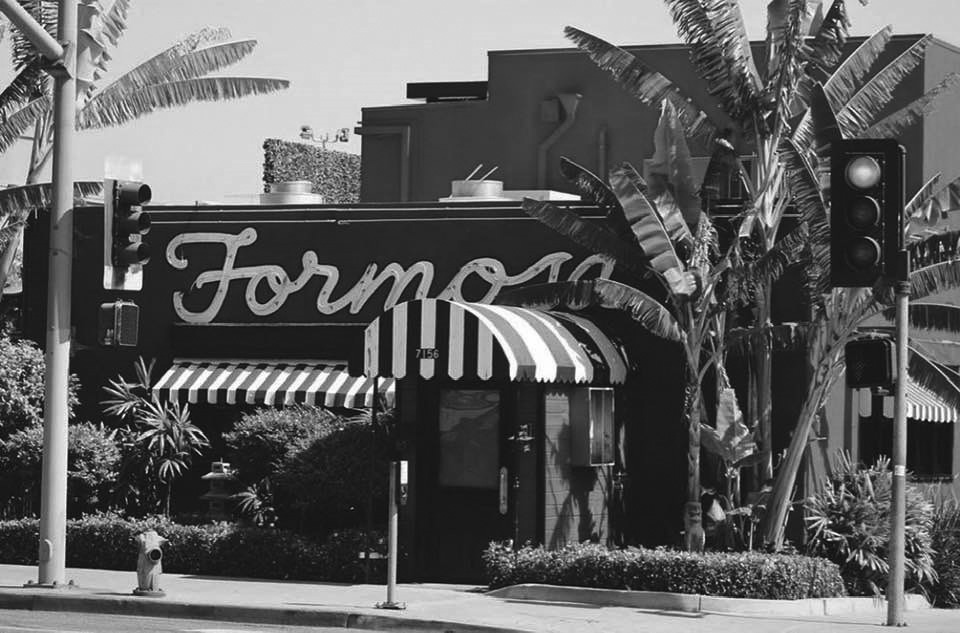 |
|
| (n.d.)^ - Formosa Café, 7156 Santa Monica Boulevard, West Hollywood. Photo courtesy of Linda Dukeslaw |
Historical Notes The Formosa is a star in its own right - in a memorable scene from L.A. Confidential (1997) set inside the Formosa, Ed Exley (Guy Pearce) mistakenly accuses actress Lana Turner (Brenda Bakke) of being a prostitute “cut to look like Lana Turner.” The Formosa has also appeared in Swingers (1996) and more recently, the Season 3 episode of Bosch, "Blood Under the Bridge." In 2019, the Formosa Café underwent extensive rehabilitation. That same year, the City of West Hollywood designated the Formosa as a local cultural resource/landmark. The rehabilitation project earned a Conservancy Preservation Award in 2020.* |
* * * * * |
Ben Frank's Coffee Shop
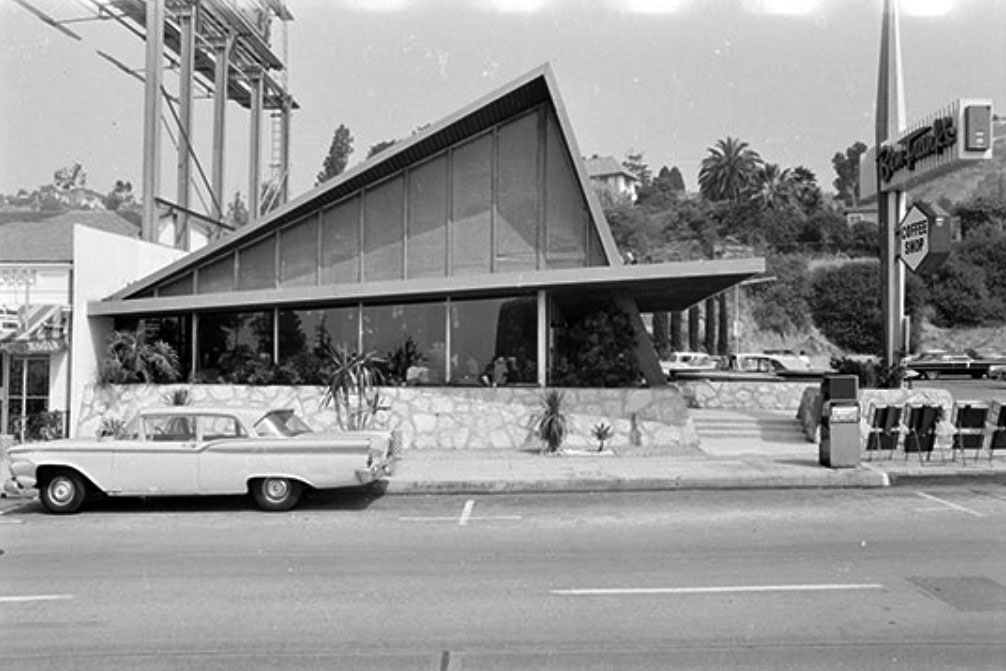 |
|
| (1966)#+#+ – View looking across the street showing Ben Frank’s Coffee Shop located at 8585 Sunset Boulevard, West Hollywood. |
Historical Notes Ben Frank’s was designed by architects Lane and Schlick and built in 1962. In form it follows neither the standard Googie formal language of Armét and Davis’s coffee shops, nor the traditional feel of the A-frame International House of Pancake restaurants, but rather exhibits a kind of kinky Googiefication of the A-frame.^ |
 |
(1967)##^* – Andy Worhol on Sunset Strip with Ben Frank's Coffee Shop in the background. |
|
Historical Notes For many years, Ben Frank's was an 'in' dining spot on the Sunset Strip in West Hollywood. It was casual and comfortable. It had a great location with plenty of parking. It was close to the clubs on the Sunset Strip where people were always milling about all hours of the day and night. And Ben Frank's was open 24 hours 7. #^** It's rumored that musicians Stephen Stills and Richie Furay were driving down Sunset Blvd with producer Barry Friedmen when they spotted Neil Young's Pontiac hearse driving the other direction. They flagged him down and they all pulled into the parking lot of Ben Frank's where they discussed forming the band that was to become Buffalo Springfield. |
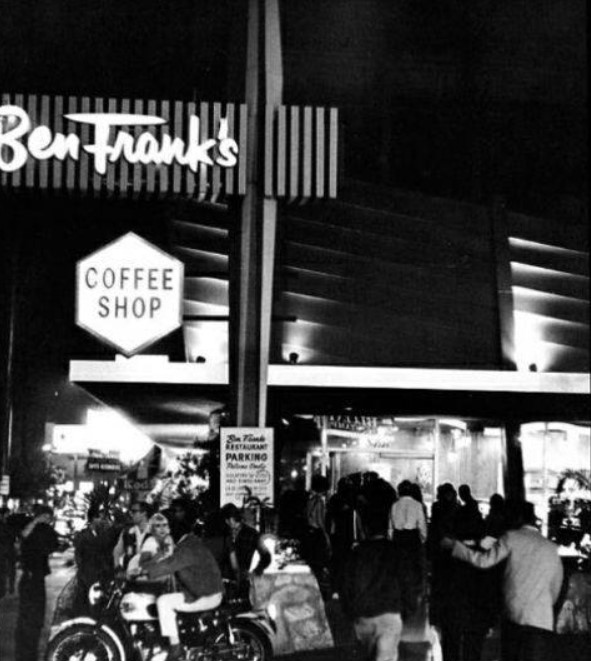 |
|
| (1972)^ – View of Ben Frank’s Coffee Shop (now Mel's Drive-in) located at 8585 Sunset Boulevard, West Hollywood. |
Historical Notes Ben Frank's was founded by Arthur Simms and his son Thomas Simms. Arthur Simms moved to Los Angeles after serving in WW2. For a time Simms ran the commissary at MGM Studios. Simms was a dashing and flamboyant man, given to wearing pink sport coats. He opened his first restaurant in 1952 with partner Bob Ehrman, a coffee shop called Ben Frank's. Two more Ben Frank's would open in the Los Angeles area. Frank Zappa would often hang out at Ben Frank's. #^** Ben Frank's would become Mel's Drive-in in 1997. |
Mel's Drive-in (previously Ben Frank's Coffee Shop)
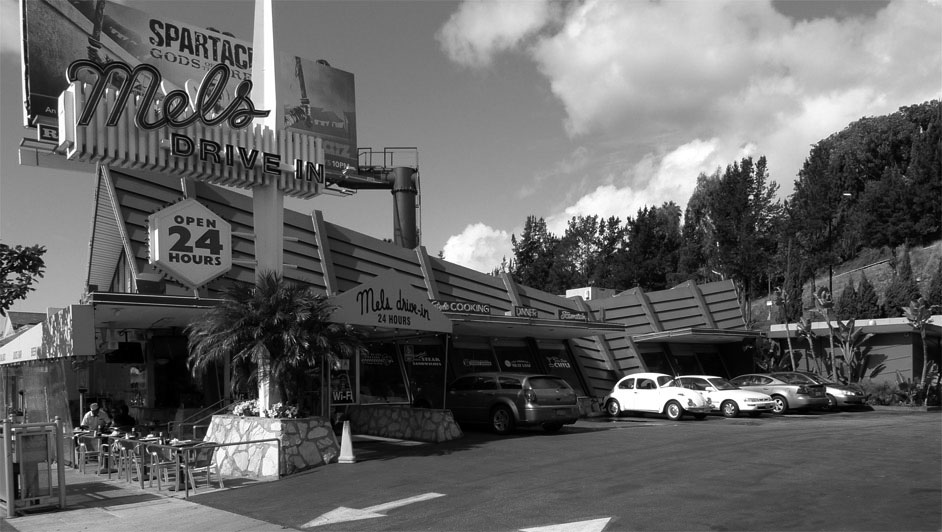 |
|
| (2011)^.^ - View showing Mel’s Drive-in Restaurant, open 24 hours per day. |
Historical Notes Mel's Drive-Ins were born in the San Francisco Bay Area in 1947, created by Mel Weiss and Harold Dobbs, who at one time ran 11 drive-ins. In 1972 the craze had died out and George Lucas used the last remaining original Mel's Drive-In as the set for American Grafitti, after which it was demolished. In 1985 Mel's son Steven resurrected the nostalgic diners, now operating four in the Bay Area and four in the Los Angeles area, including this one on the Sunset Strip in West Hollywood. ^ Mel’s remodeled the original Ben Frank’s building. Alterations included the addition of the awning in the front, extending the window openings at the parking-lot side of the A-frame, and the addition of an attached outbuilding in back. The pylon-shaped sign standard with its radiator-like fins is original. |
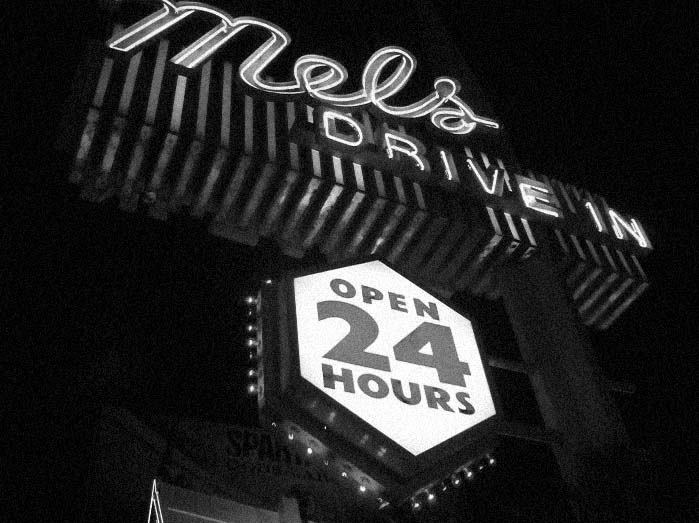 |
|
| (2011)*^*^* - View of Mel's Drive-In Coffee Shop, formerly Ben Frank's Coffee Shop. Despite the Drive-In name, Mel's doesn't actually provide car-hop service. Click HERE to see contemporary view. |
Historical Notes The 50s-feel diner sports table-side jukeboxes and a traditional burger and fries menu in a "Googie"-style building that was once Ben Frank's restaurant, a popular 24-hour coffee shop where rockers frequently gathered after gigs on the Strip. Click HERE to see more Early Views of LA Drive-in Restaurants. |
Cameo Theatre
 |
|
| (1961)* - The Cameo Theatre located at 8365 Sunset Boulevard in what is now West Hollywood. Today a shopping center is at this location. Click HERE for Contemporary View. |
Historical Notes In 1960 a group of actors announced plans to open a theatre in a storefront one door west of the Players Ring. The actors renovated the building into the same theatre-in-the-round format as the Players Ring. A review of their first production, “Sabrina Fair,” complained about the small space, but audiences didn’t seem to mind. The next shows, “Grand Prize“ in July and “Heaven Can Wait” in August, were hits. In November 1961 a musical written by Jesse Lasky Jr., the son of one of the founders of Paramount Studios, opened at the Cameo. Described as a robust serio-comic epic of the old Nevada mining and gambling town of Virginia City, “Ghost Town” played for more than two months. One of the Cameo’s biggest hits was “The Man in the Dog Suit” (1962), which played for eight months. It starred former contract starlet at RKO and Columbia Pictures Arline Judge and Ty Hardin – born Orison Whipple Hungerford Jr., and rechristened Ty Hardin by Henry Willson, the agent who discovered Rock Hudson – who was starring at the time in the hit television series “Bronco.” In October 1963 the Cameo hosted an arts seminar “for anyone interested in acting, directing, producing or writing for the stage.” Lecturers included Richard Boone, Richard Chamberlain, Raymond Massey, Jose Ferrer and Loretta Young. “King of Hearts” opened on Christmas day 1963. The next show, “It’s Still an Act,” which opened in October 1964, four months after a fire had destroyed the Players Ring next door, was the Cameo’s last. The building was soon razed as part of the shopping center development.* |
Garden of Allah Hotel
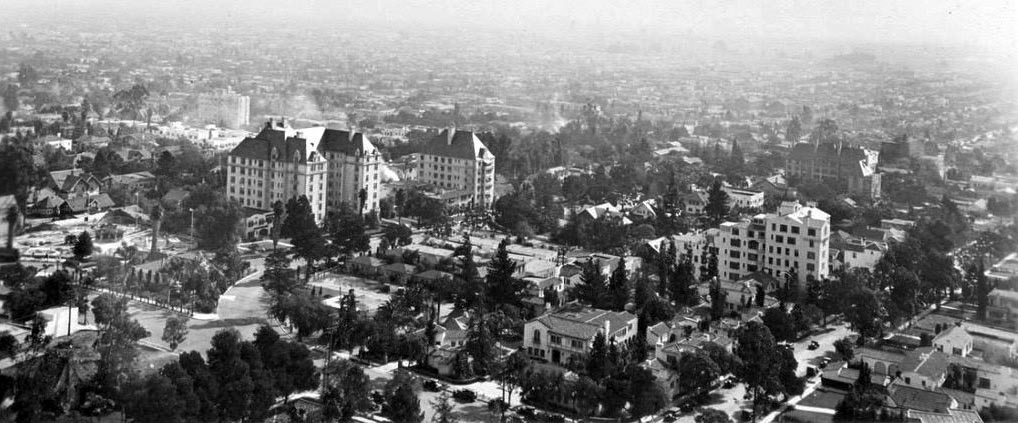 |
|
| (ca. 1930)#**# – Panoramic view looking southeast showing the Garden of Allah Hotel and complex as seen at lower-center. Sunset Boulevard runs diagonally from center-bottom to lower center-left with Crescent Heights on this side of the three apartment towers at center-left. |
Historical Notes The Garden of Allah was a famous hotel in Hollywood at 8152 Sunset Boulevard between Crescent Heights and Havenhurst, at the east end of the Sunset Strip. It was originally a 2.5 acre estate called Hayvenhurst^ that was built in 1913 by real estate developer William H. Hay as his private residence. *^ ^Originally named Hayvenhurst, it was built for $30,000 in 1913 by William H. Hay, developer of the Crescent Heights neighborhood, which was bounded by Sunset and Santa Monica blvds, to the north and south, Fairfax (then called Crescent Ave.) to the east and Havenhurst (originally spelled "Hayvenhurst") to the west. Hay and his second wife lived in Hayvenhurst briefly before building an even grander home down the street (where the Directors Guild building is now) and then finally retiring to a large house at 4400 Hayvenhurst Avenue in Encino, another neighborhood Hay owned and developed. After the Hays moved out, Hayvenhurst stood empty for a few years before Alla Nazimova acquired it, including during World War I, when the Hays allowed the Red Cross to use it as its Westside headquarters. Nazimova ... leased Hayvenhurst in November 1917.... She purchased it outright for $65,000 in August 1918. |
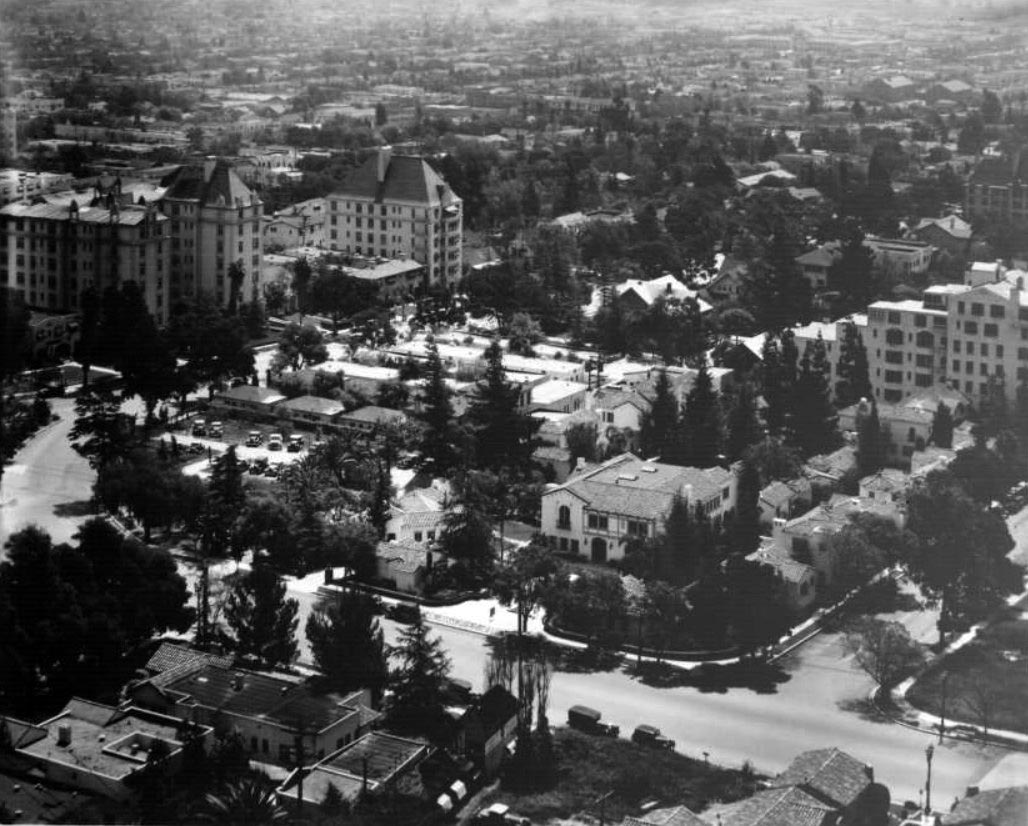 |
|
| (1930s)^^ – Closer view looking South-Southeast across Sunset Boulevard showing the Garden of Allah hotel complex in the middle of photo. Crescent Heights is on the left and Havenhurst Drive at right. |
Historical Notes Silent screen star Alla Nazimova acquired the property in 1918 and then, in 1926, converted it into a residential hotel by adding 25 villas around the residence. The hotel opened in January 1927 as the Garden of Alla Hotel (no final "h" on Alla). By 1930, new owners had changed the name to the Garden of Allah Hotel. Over the next two decades, the property went through a succession of owners, the last of whom was Bart Lytton, owner of Lytton Savings & Loan, who demolished the hotel in 1959 and replaced it with his bank's main branch.*^ |
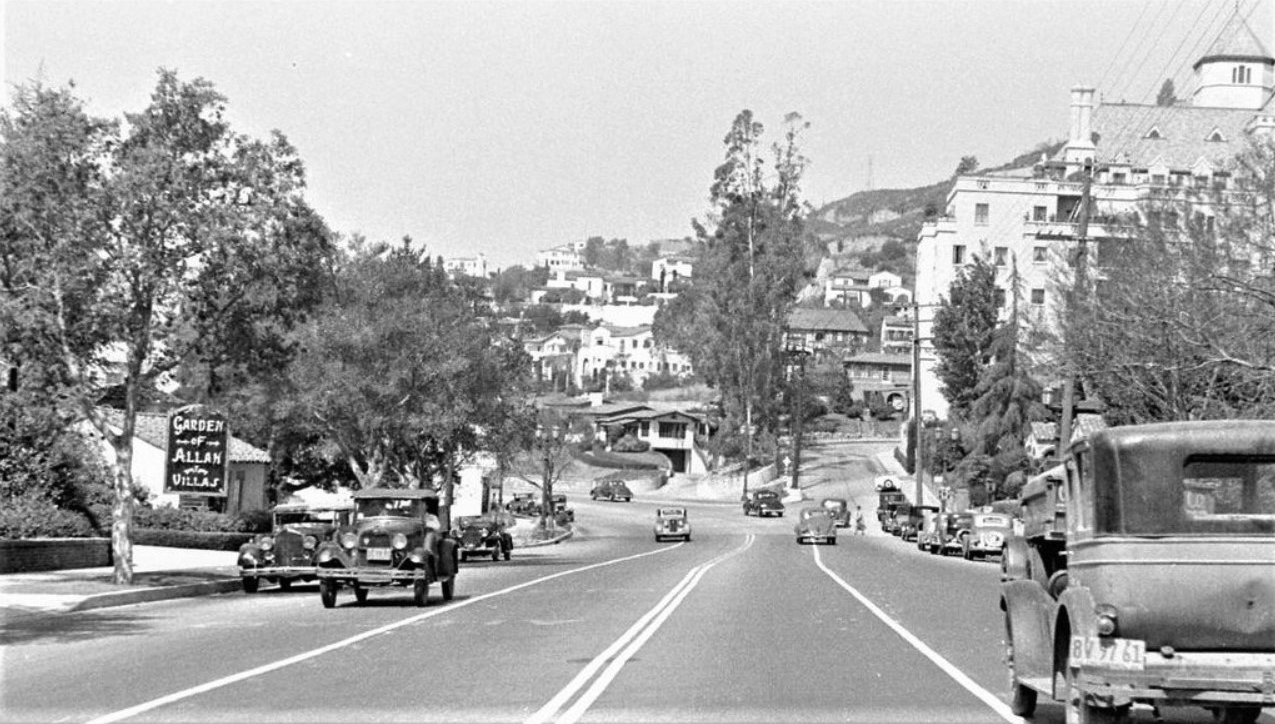 |
|
| (ca. 1936)^##* – View looking west on Sunset Boulevard toward Havenhurst Drive, just on the other side of the Garden of Allah (seen on the left). In the distance can be seen the confluence of Sunset which bends to the left and Marmont Lane which runs essentially straight forward. The Chateau Marmont Hotel stands formidably on the right. |
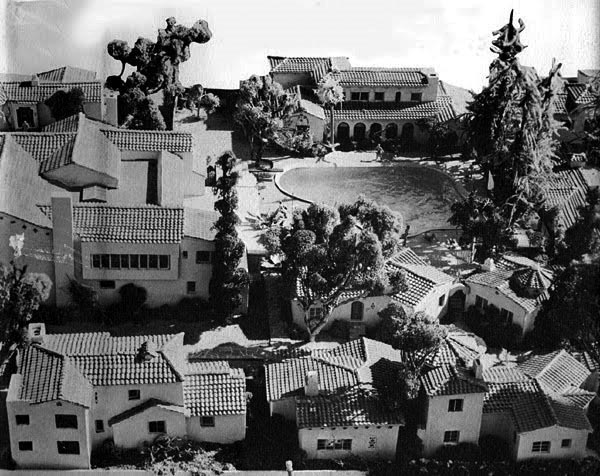 |
|
| (n.d.)##^ - Scaled miniature model of the Garden of Allah Hotel showing the new bungalows that now surrounded the main hotel. |
Historical Notes In the mid-1920s owner Alla Nazimova proceeded to spend a small fortune, adding 25 two-story bungalows built throughout the grounds. Known initially as “The Garden of Alla” (no final “h”). Unfortunately for Nazimova, the investment proved to be her financial undoing. Within a year of the opening she was bankrupt and in 1928 she sold her shares in the property. The hotel however was a huge and instant success. It attracted many people lured by Hollywood’s promise of fame and fortune and quickly became one of the places people stayed when they first arrived in Hollywood before making their way up the ladder.*^^ |
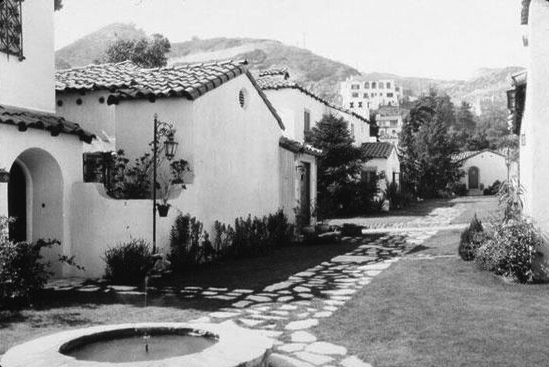 |
|
| (ca. 1930s)^.^ – View looking north showing villas at the Garden of Allah Residential Hotel and part-time home to most of Hollywood’s glitterati until 1959. |
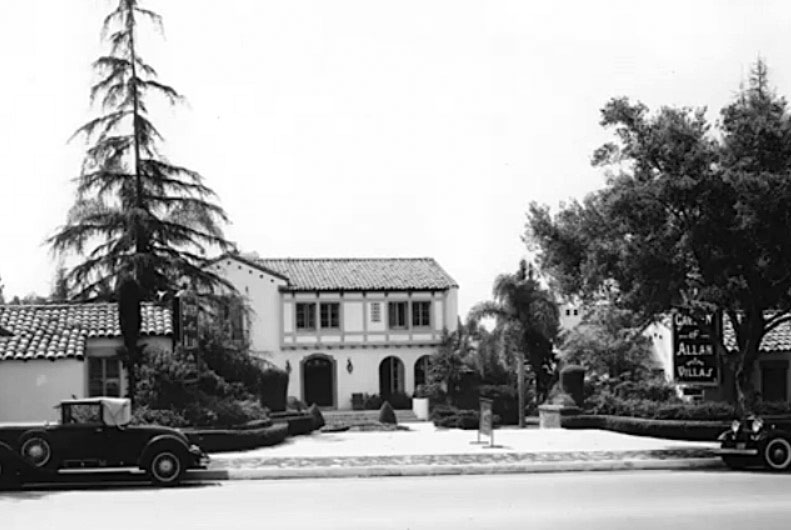 |
|
| (1930s)^x^ – View looking south from Sunset Boulevard showing the Garden of Allah Hotel. |
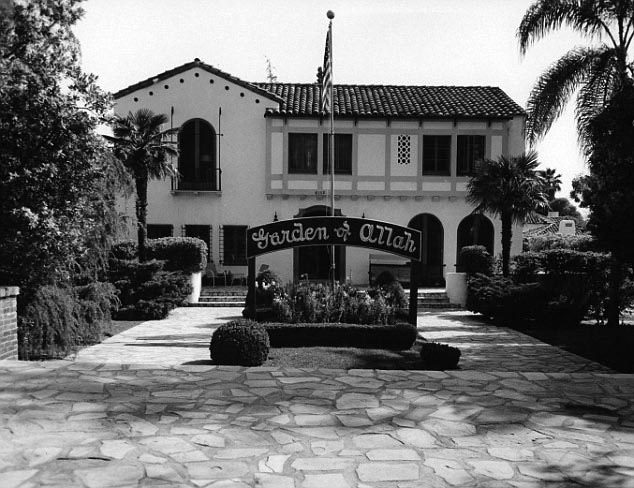 |
|
| (1940)##^ – View showing the Garden of Allah Hotel 'Main House' located at 8152 Sunset Boulevard. |
Historical Notes The 'Hotel / Main House,' frequently described as the "big house," contained eight guest rooms a restaurant, the kitchen and staff quarters ... and the bar, where even during the War years one could get a drink.*^^ Within walking distance from The Garden were; Ciro's, the Mocambo, the Trocadero, La Rue, the Players, and of course Schwab's Drugstore, just across Crescent Heights. |
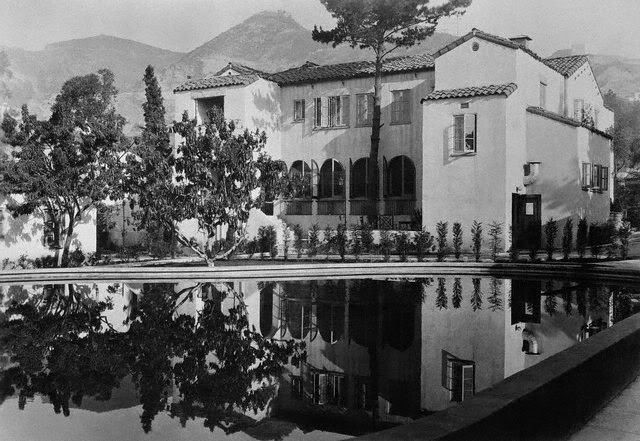 |
|
| (ca. 1940s)#**# - View, looking north, of the swimming pool situated directly behind the ''Hotel / Main House”, with the Hollywood Hills in the background. |
Historical Notes For sometime, this was the largest swimming pool in town. It was built to remind Nazimova of her home in Yalta. Paramount Studios had bestowed Nazimova with the home and grounds when the star was at her apex so that she could enjoy a glamorous retreat in the burgeoning Hollywood community. A 1959 LA Times article discusses those early years: To garnish the gift, Nazimova built Hollywood’s largest swimming pool—65 x 45 ft.—and had it shaped like the Black Sea of her girlhood. The pool hung like a dewy sapphire around the heart of her garden.+#+#+ |
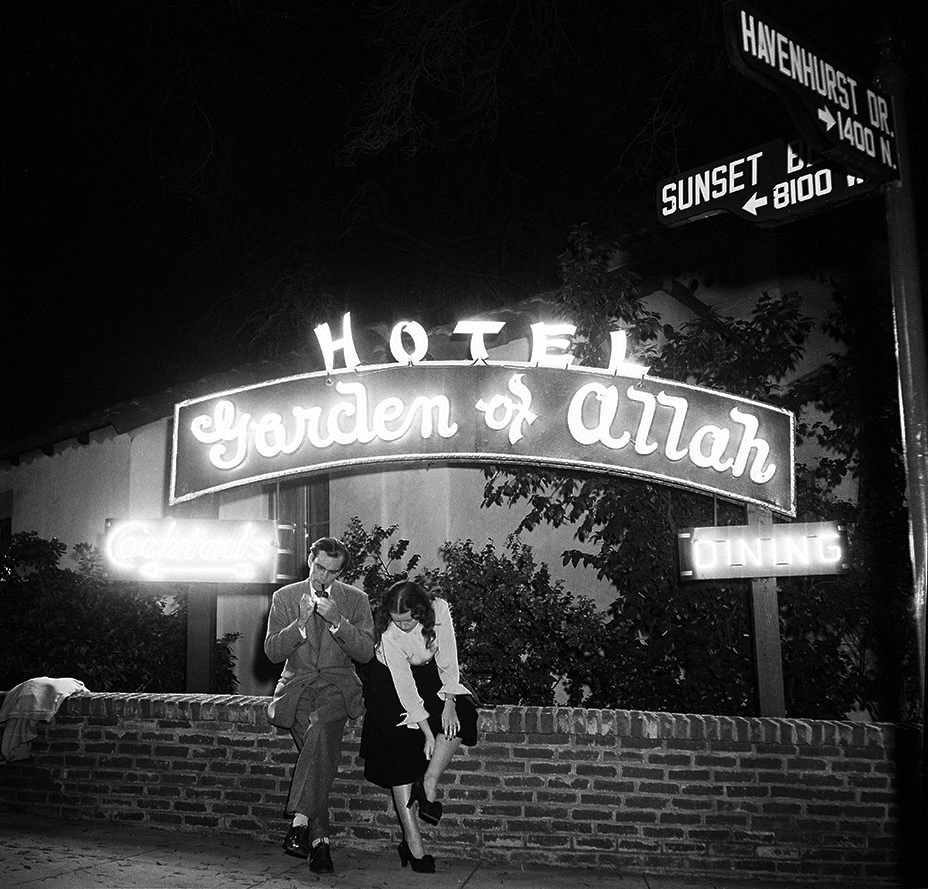 |
|
| (1951) ^x^– View showing a man and woman sitting on a wall in front of the Garden of Allah Hotel. The man is lighting his pipe while the woman is checking her stocking. |
Historical Notes For decades, the Garden of Allah was not so much a hotel as one very long house party — one where every vice was allowed to flower. And it's easier to say who didn't check in at the Garden rather than who did. Humphrey Bogart, Frank Sinatra, Laurence Olivier, Greta Garbo and Orson Welles were among the actors who lived there. Writers included F. Scott Fitzgerald, W. Somerset Maugham, Dorothy Parker and Ernest Hemingway. Marlene Dietrich liked to swim naked in the pool, while Errol Flynn would pounce on every beauty who so much as dipped her toe in it. ##^ |
 |
|
| (1950s)##^* – View looking at the southeast corner of Sunset Boulevard and Havenhurst Drive showing the Garden of Allah Hotel Restaurant (after expansion). Sign reads: Now Leasing – Apts – Bachelors – Villas. |
Historical Notes As Hollywood grew, the studio era began to wane and the city eventually surrounded the Garden of Allah. The real estate it was built on became more valuable as commercial property than the hotel itself. The hotel became seedier and the new stars, such as Montgomery Clift and James Dean, stayed at the nearby Chateau Marmont, which afforded more privacy and less chance of encounters with the less stylish transients who increasingly occupied the neglected villas at the Garden of Allah. In 1959, the Garden of Allah came to its official end. Lytton Savings and Loan had bought the property, and had plans to turn the corner of Sunset and Crescent Heights into a business center, anchored by a bank. +#+#+ |
Lytton Savings and Loan
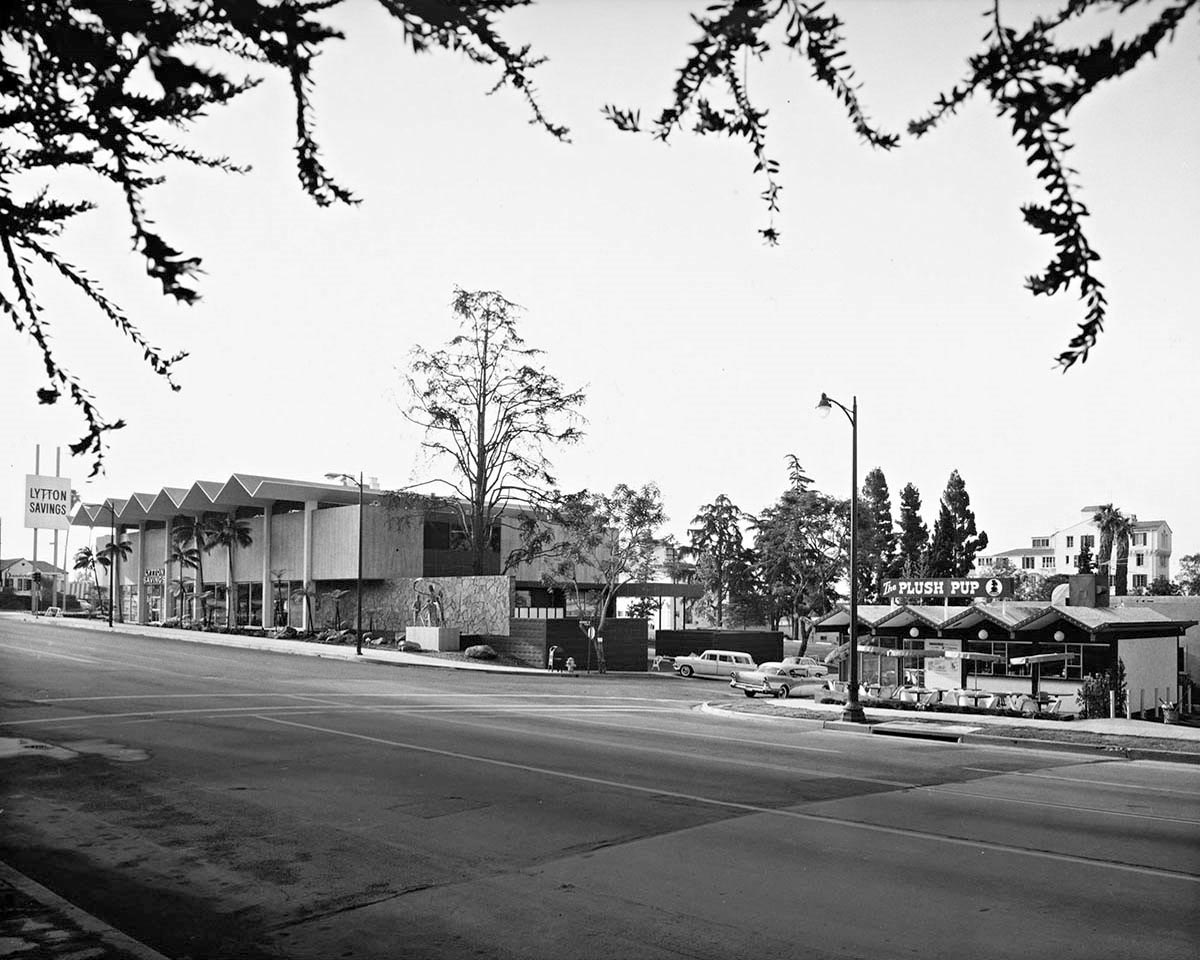 |
|
| (1960)#+#+ – View looking southeast toward the intersection of Sunset Boulevard and Havenhurst Drive showing the Lytton Savings and Loan Building on the left (S/E corner). On the right and across the street stands the Plush Pup Restaurant (S/W corner) with Colonial House on Havenhurst Drive behind it. Click HERE to see contemporary view. |
Historical Notes Lytton Savings occupied the former site of the Garden of Allah. The storied Hollywood inn with surrounding villas was purchased by Lytton Savings in 1959 and razed to make way for the firm’s new home office. *^ |
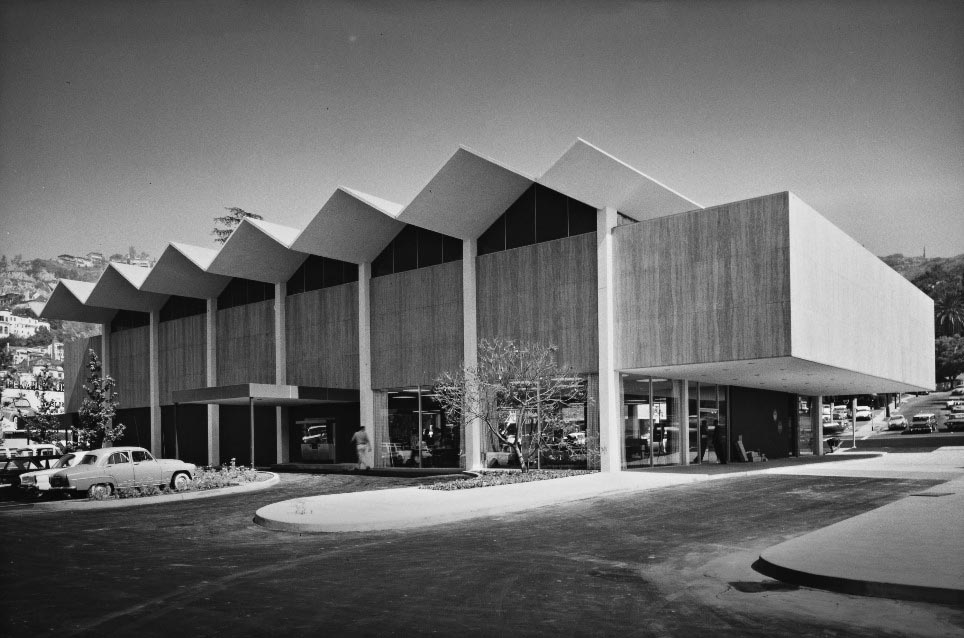 |
|
| (1960)#+#+ - View looking northwest showing the back of the Lytton Savings and Loan Building (today a Chase Bank) with the Hollywood Hills in the background. |
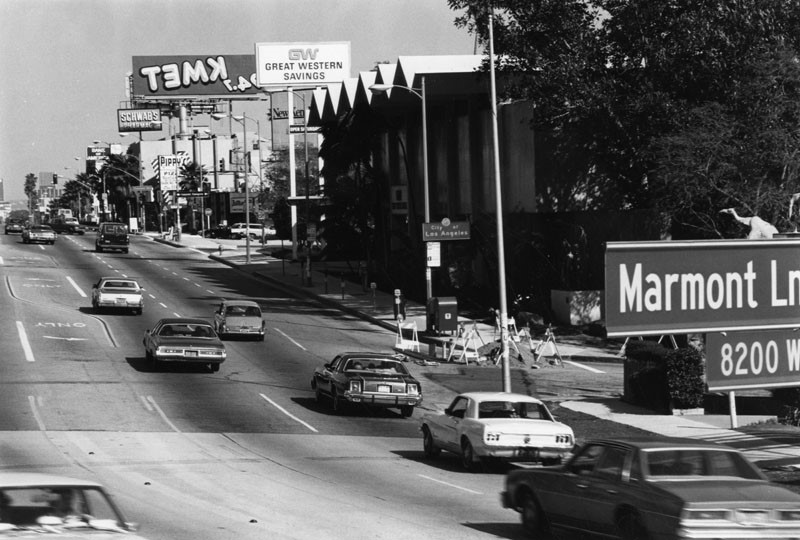 |
|
| (1979)* – View looking east on Sunset Boulevard toward Crescent Heights showing the Lytton Savings and Loan building, occupied above by Great Western Savings and Loan, and today by Chase Bank. Click HERE to see contemporary view. |
Then and Now
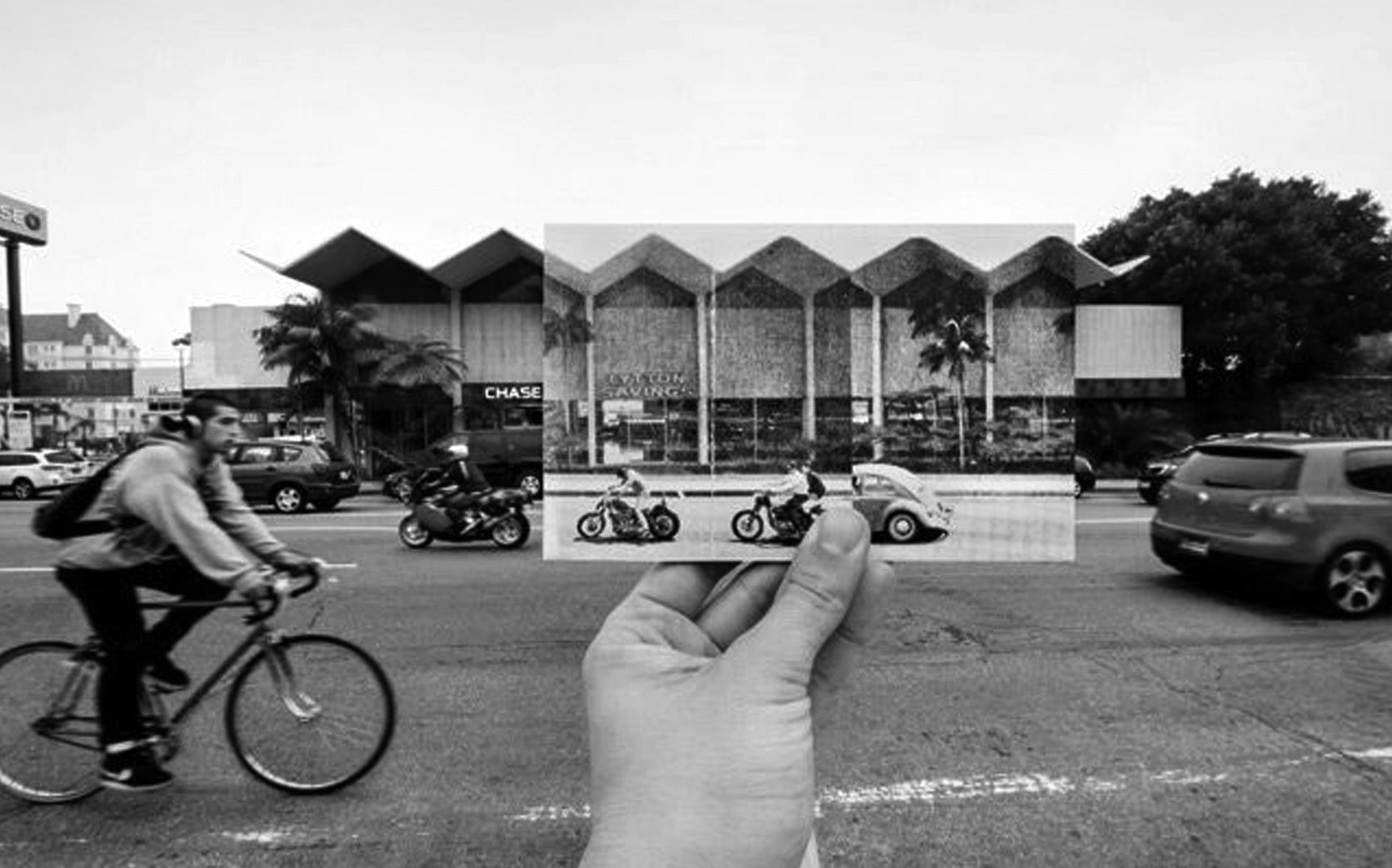 |
|
.jpg) |
|
| (1970s vs. 2010s)^.^ – Composite view showing Lytton Savings and Chase Bank – Then and Now. |
Then and Now
 |
|
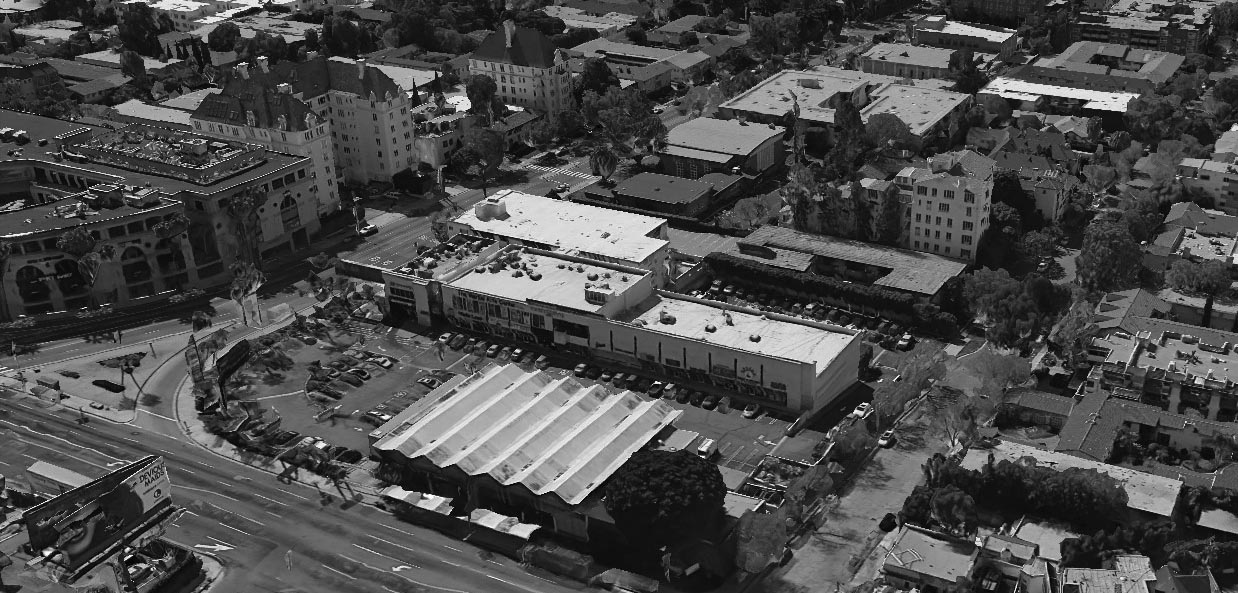 |
|
| (ca. 1930)#**# vs. (2016)*### - Aerial view showing the Garden of Allah Hotel site near Sunset and Crescent Heights. |
Spago Hollywood
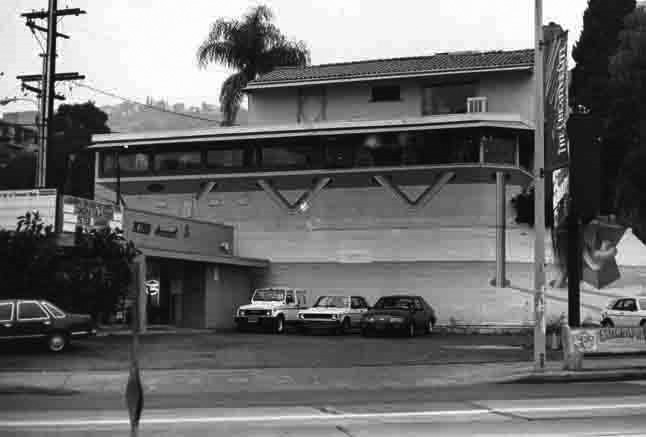 |
|
| (1980s)^##^ – View looking at the northeast corner of Sunset Boulevard and Horn Avenue showing the world famous Spago Restaurant. |
Historical Notes This was the original Spago, located at 8795 Sunset Boulevard (entrance at 1114 Horn Avenue) on the Sunset Strip in West Hollywood. It opened in 1982, and closed in 1997 when the Beverly Hills location opened. *^ The original Spago attracted almost everyone who was anyone in Hollywood, from producers to politicians to major movie stars. In 1975, Wolfgang came to Los Angeles and very quickly garnered the attention of the Hollywood elite as chef of Ma Maison in West Hollywood. From Ma Maison, Wolfgang went on to create his first flagship restaurant, Spago, in West Hollywood on the Sunset Strip. From its opening day in 1982, Spago was an instant success and culinary phenomenon. Wolfgang and Spago earned many accolades during its popular eighteen years in West Hollywood, including winning the prestigious James Beard Foundation Award for Outstanding Chef of the Year, twice, in 1991 and 1998, and the James Beard Foundation Award for Restaurant of the Year in 1994. Wolfgang is the only chef to have won the Outstanding Chef of the Year Award multiple times. After 15 successful years in West Hollywood, Wolfgang moved Spago to Canon Drive in Beverly Hills.^* |
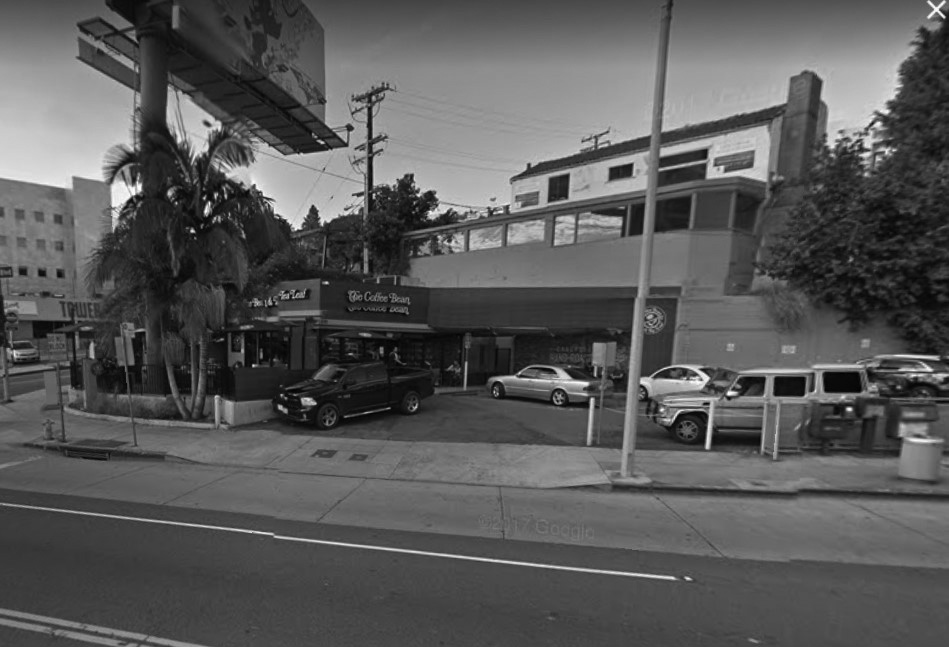 |
|
| (2016)* – Google street view showing the northeast corner of Sunset and Horn, location of the original Spago Restaurant. Tower Records can be seen across the street. |
Historical Notes Little known fact: That unassuming building that was occupied by Spago once housed the legendary Café Gala which was significant for its association with the history of the LGBTQ community in West Hollywood. It was one of the first supper clubs with an openly gay clientele. Run by the eccentric Baroness Catherine d’Erlanger and Johnny Walsh, the Venetian-themed club saw a co-mingling of straight and gay patrons. At Café Gala, gay and lesbian stars did not have to worry about being caught up in a police raid. Regular guests included Cole Porter, Judy Garland, and Lena Horne. Pianist Bobby Short started out here, and when Dorothy Dandridge made her debut performance, it was one of the hottest tickets in town. By the 1960s, the property was occupied by Russian-Armenian restaurant. From 1982 to 2001, it was the home of Spago.^* |
Scandia Restaurant
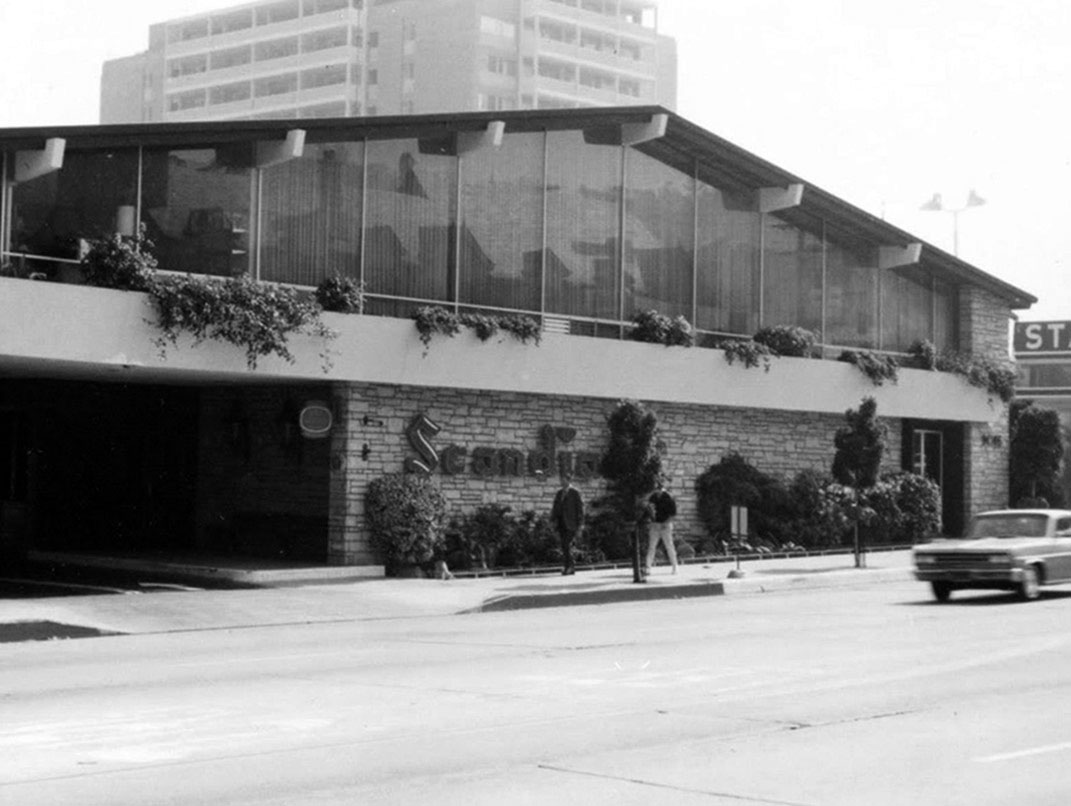 |
|
| (1970s)* – Daytime view of ‘High End’ Scandia Restaurant located at 9040 Sunset Boulevard in West Hollywood. |
Historical Notes Scandia wasn’t just high-end—it was happening. In its heyday, customers would beg, borrow, and steal for a reservation before 11 p.m. It’s where Frank Sinatra kept an office upstairs complete with a personal shower; Jack Webb held his wedding reception in the main dining room in 1958; and James Garner ate brunch on Sundays while filming The Rockford Files. The restaurant was even name-dropped in American Gigolo, and visited by five American presidents.* |
 |
|
| (1980)* - View of patrons standing outside the once legendary Scandia restaurant, located at 9040 Sunset Boulevard in West Hollywood. |
Historical Notes Opened in 1957, Scandia was originally owned by Ken Hansen. Along with his wife, Tova, he turned the restaurant into a culinary landmark with elegant decor, impeccable service, and delectable Scandinavian and French cuisine. Ken’s sister-in-law, Teddy, served as hostess. Scandia was a popular destination for members of the entertainment industry for decades. Inside, it included theme rooms: the Skal Room, which included a large copper bar, the Danish Room, full of Danish memorabilia, and the Terrace Room, fashioned after the Belle Terrace at Copenhagen's Tivoli Gardens. The restaurant offered a late-night dinner starting at 10:30 p.m. for the after-theatre crowd and had an award-winning wine cellar containing thirty thousand bottles. It closed its doors in 1989. |
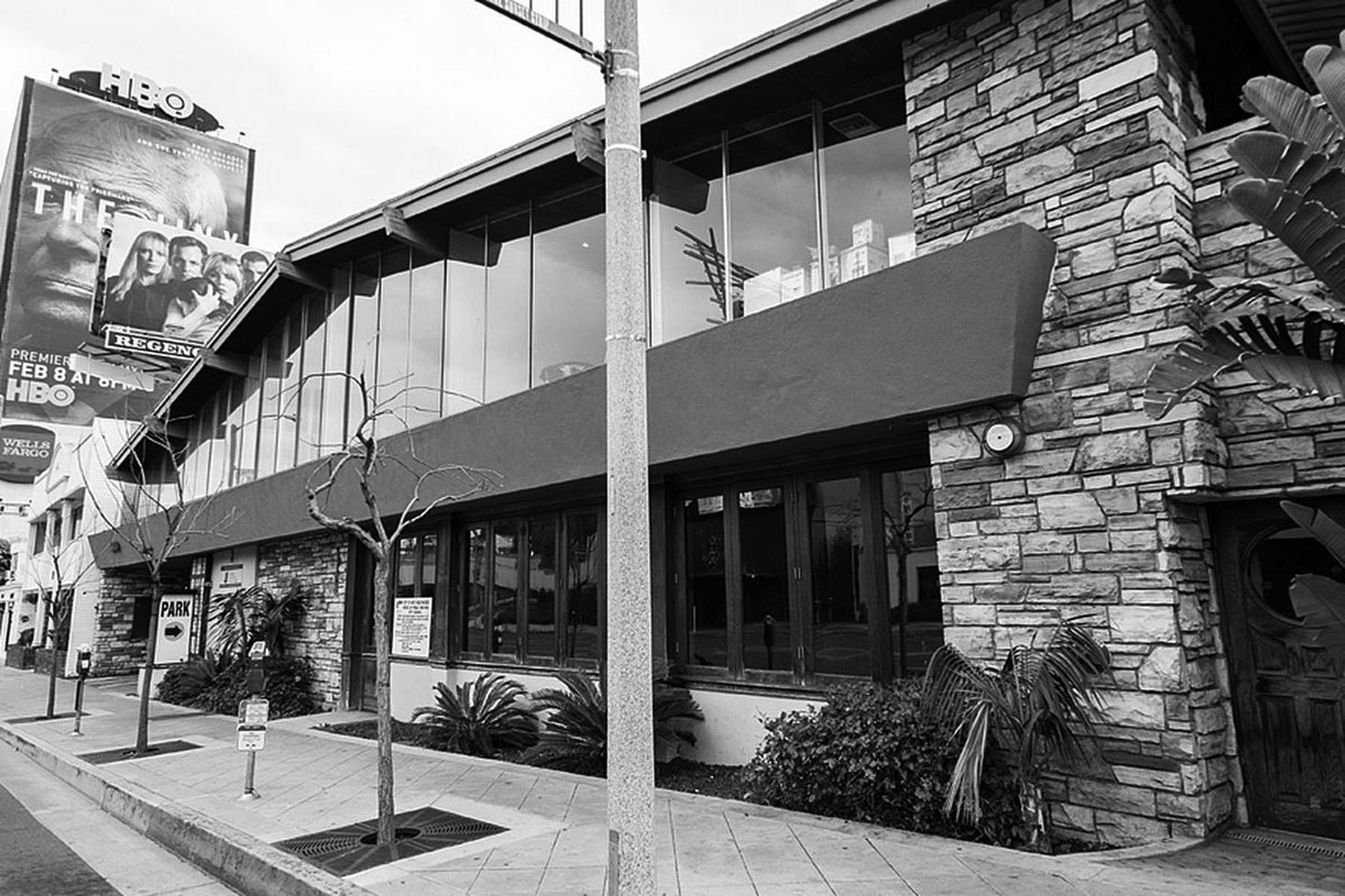 |
|
| (2015)^ – View of the old Scandia Restaurant building before it was demolished to make way for a new hotel (The West Hollywood EDITION). |
Historical Notes In 2019 the West Hollywood EDITION Hotel was completed on the site where Scandia Restaurant once stood. |
Rocky and Bullwinkle
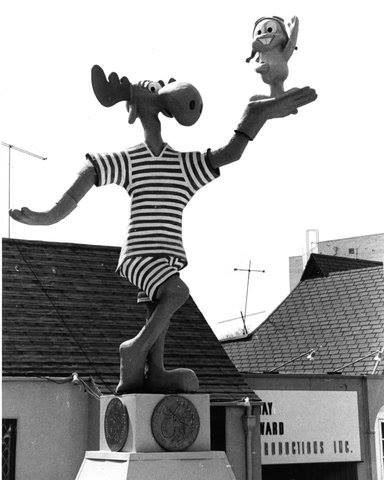 |
(ca.1975)##^* – Rocky and Bullwinkle on the Sunset Strip, 8200 W. Sunset Boulevard. |
Historical Notes From 1961 to 2013, this 15-foot-tall cartoon statue stood beside the former home of Jay Ward Productions, the company that created Rocky the Flying Squirrel and his pal Bullwinkle. The erstwhile squirrel and moose once faced a billboard ad for a Las Vegas hotel featuring a bathing-suit-clad showgirl, and every time her suit changed, Bullwinkle's shirt got painted to match. #++ |
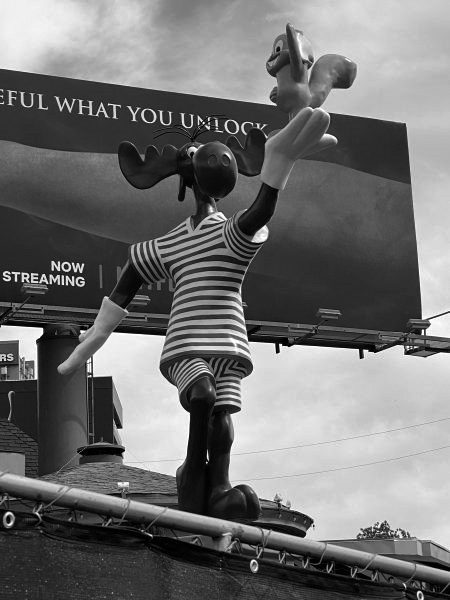 |
|
| The iconic Rocky and Bullwinkle statue back on the strip again at Sunset and Holloway Dr. |
Historical Notes In April 2020 the iconic Rocky and Bullwinkle statue found a permanent new home in the triangle at the intersection of Holloway Drive and Sunset Boulevard.* |
* * * * * |
Sunset Tower (1970 - Present)
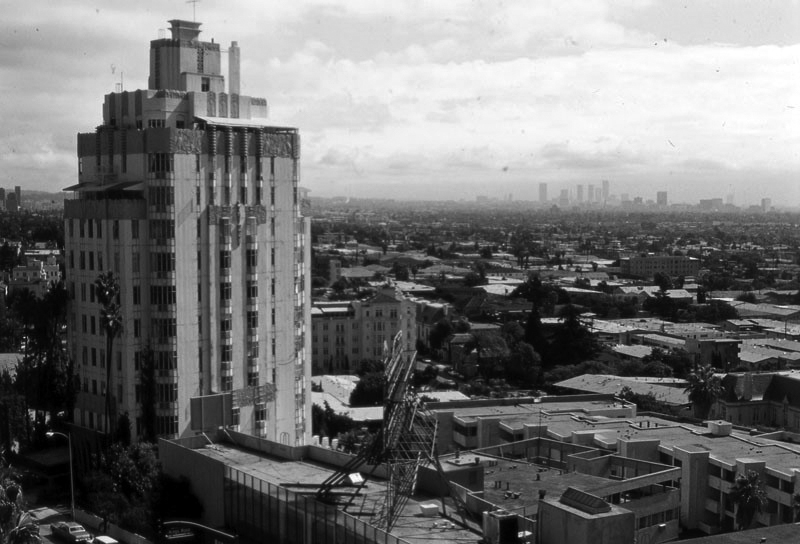 |
|
| (1979)* - Looking out upon West Hollywood from a balcony at the Sunset Hyatt Hotel (later Andaz West Hollywood), showing the neighborhood and the iconic Sunset Tower; Downtown Los Angeles is partially visible through the haze on the right. |
Historical Notes After a period of decline in the early 1980s, the building was renovated and has been operated as a luxury hotel under the names The St. James's Club, The Argyle, and most recently the Sunset Tower Hotel. |
 |
|
| (2005)*^ – View showing the Sunset Tower Hotel located at 8358 Sunset Boulevard in West Hollywood. Photo by Carol M. Highsmith via Wikipedia |
Historical Notes The building was saved from deterioration and possible demolition when it was purchased in 1985 from architect David Lawrence Gray, FAIA by Peter de Savary who promised to "lovingly restore" the building to its former glory by spending $25 million to convert the building into the first American branch of his luxury hotel chain, the St. James's Club. The Lancaster Group purchased the hotel from de Savary in 1992, renaming it the Argyle. In 2004, Jeff Klein purchased the hotel. Klein hired designer Paul Fortune to renovate the hotel, adding more modern amenities, and restored its original name.^ |
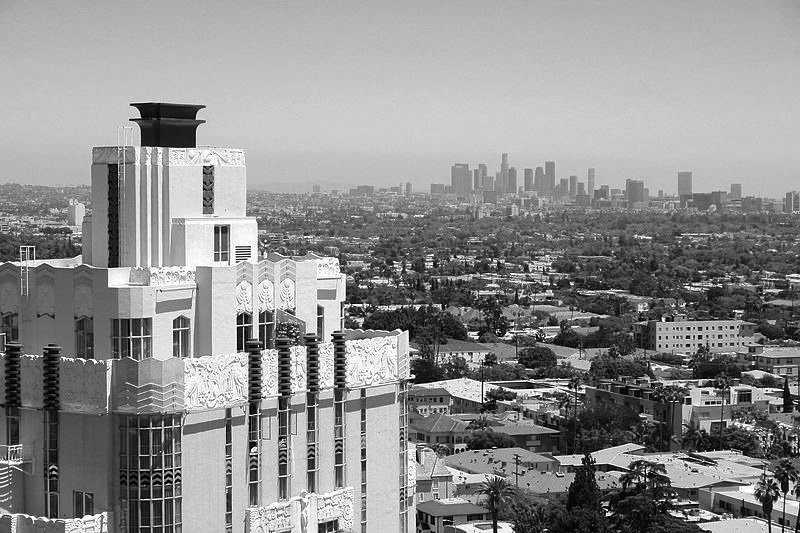 |
|
| (2011)^ - Sunset Tower, 8358 Sunset Blvd in West Hollywood, with the Downtwon LA skyline in the background. Photo by Mike Jiroch via Wikipedia |
Historical Notes The Sunset Tower building was listed on the National Register of Historic Places in 1980. In the 1990's the Sunset Tower Hotel was known as the Argyle Hotel. Before that it was known as the St. James Club and Hotel, a grand 13 story, the Strip's 1st high-rise (built in 1931), and one of Hollywood 's best examples of Art Deco design. Virtually every star in Hollywood stayed here at one time or another. It was a favorite of Howard Hughes, who kept a number of suites here fore his various girlfriends; other guest included Clark Gable, Jean Harlow, Marilyn Monroe, Frank Sinatra and John Wayne (who is said to have kept a cow on the balcony outside his penthouse suite for fresh milk). |
* * * * * |
Sunset Strip's Billboards
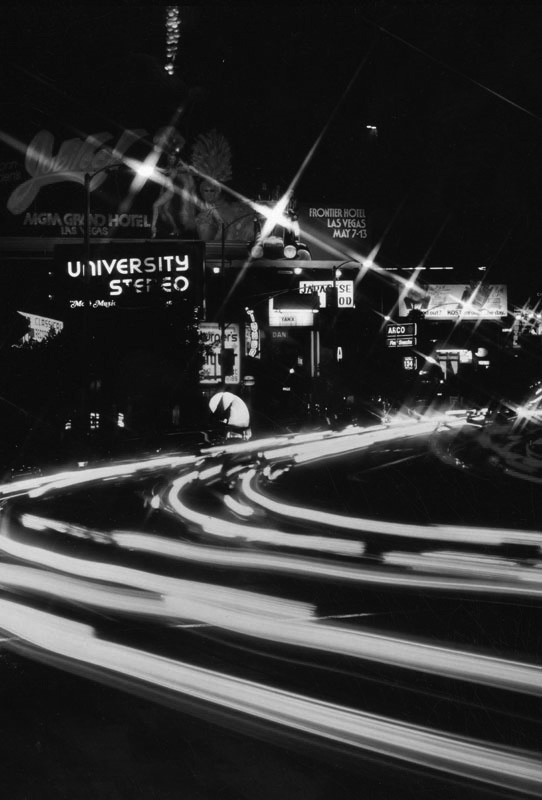 |
|
| (ca. 1980)* - Night view of large billboards along Sunset Strip with automobile headlights creating a neon-like streak. |
Historical Notes The Strip has a long tradition of innovative and memorable signage. In the 1960s and ‘70s making it “big” for musical artists meant a custom-painted billboard on Sunset Strip. |
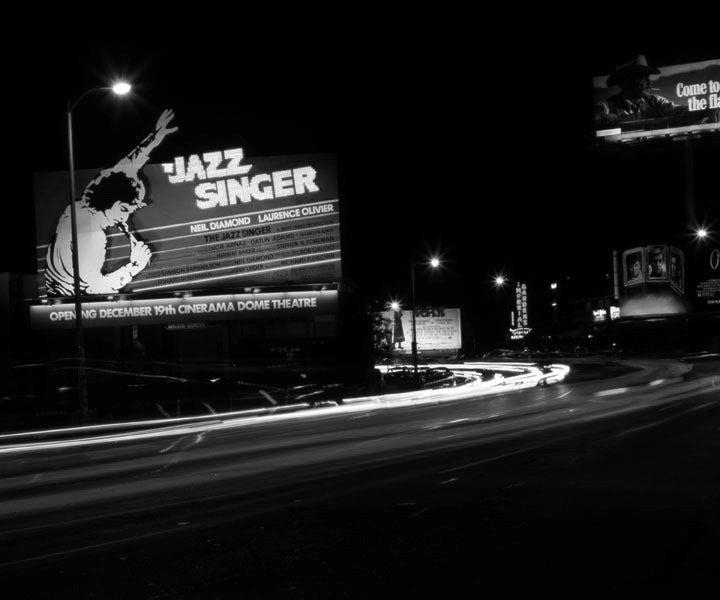 |
|
| (1980)* - View looking west from the northern side of Sunset Boulevard near Chateau Marmont at night. It is a part of the famous "Sunset Strip", the mile and a half stretch of Sunset Boulevard passing through West Hollywood. Large billboards for the "Jazz Singer", "Popeye", "Ordinary People", and Marlboro cigarettes are present on both sides of Sunset Boulevard. Shown in the distance is the yellow neon sign of Imperial Gardens Restaurant, later demolished, located at 8225 Sunset Boulevard. |
Historical Notes In the 1970s, the Sunset Strip became known for its prolific billboard advertising, especially by musicians and record companies promoting new albums, according to Robert Landau’s “Rock ‘n’ Roll Billboards of the Sunset Strip.” |
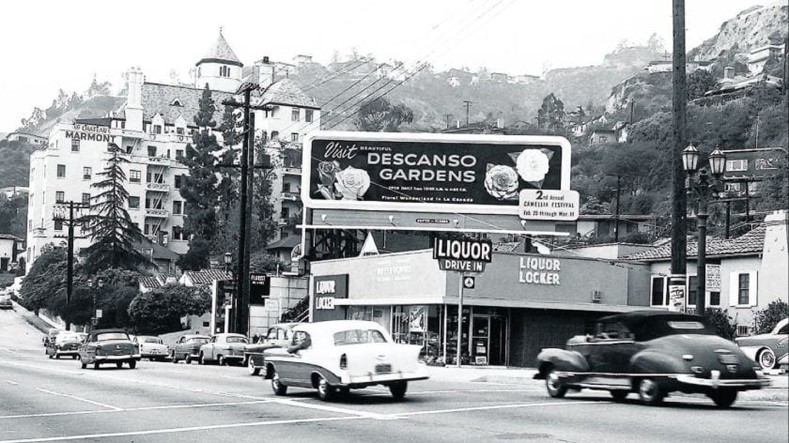 |
|
| (1959)* - Sunset Boulevard and the Chateau Marmont in the background. Note the billboard on top of the Liquor Locker for Descanso Gardens. |
Historical Notes The Strip has a long tradition of innovative and memorable signage. It wasn't until the 1960s and ‘70s that musical artists started to appear "big" along the Sunset Strip. |
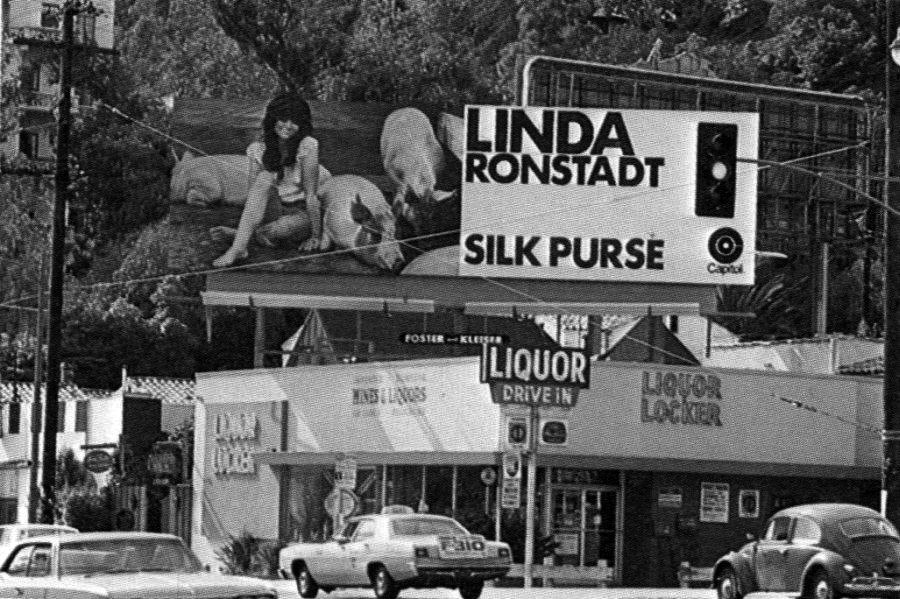 |
|
| (1970)*- Linda Ronstadt billboard atop Liquor Locker at 8161 Sunset on the Sunset Strip. |
Historical Notes Author Andrew Greeley, in his book God in Popular Culture, described Ronstadt as "the most successful and certainly the most durable and most gifted woman Rock singer of her era." Signaling her wide popularity as a concert artist, outside of the singles charts and the recording studio, Dirty Linen magazine describes her as the "first true woman rock 'n' roll superstar ... (selling) out stadiums with a string of mega-successful albums." Amazon.com defines her as the American female rock superstar of the decade. Cashbox gave Ronstadt a Special Decade Award, as the top-selling female singer of the 1970s. By the end of 1978, Ronstadt had solidified her role as one of rock and pop's most successful solo female acts, and owing to her consistent platinum album success, and her ability as the first woman to sell out concerts in arenas and stadiums hosting tens of thousands of fans, Ronstadt became the "highest paid woman in rock". She had six platinum-certified albums, three of which were number 1 on the Billboard album chart, and numerous charted pop singles. In 1978 alone, she made over $12 million (equivalent to $44,000,000 in 2016 dollars) and in the same year her albums sales were reported to be 17 million – grossing over $60 million (equivalent to a gross of over $220,000,000, in 2016 dollars).* |
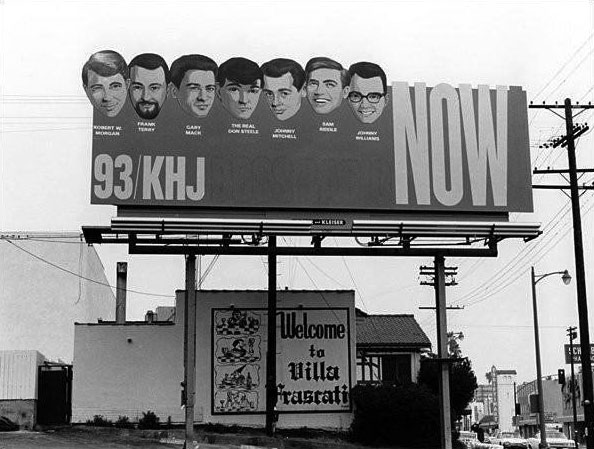 |
|
| (1960s)^ – Billboard advertising the 93/KHJ which helped cultivate a love for rock and roll in the 60’s and 70’s (along with KRLA). The small but popular Villa Frascati Restaurant, 8117 Sunset, is located directly east of the sign. |
Historical Notes KHJ (AM) was a nationally noted Top 40 station from 1965 to 1980. In 1965, programming consultant Bill Drake crafted KHJ's top-40 format. Drake hired program director Ron Jacobs, who had created formats in Hawaii and California. The format featured a restricted playlist and restrained commentary by announcers (although a few, such as Robert W. Morgan, Charlie Tuna, Humble Harve Miller, and The Real Don Steele, were allowed to develop on-air personalities). Other DJs from 1965-68 included Roger Christian, Gary Mack, Dave Diamond, Sam Riddle, Johnny Williams, Frank Terry, Johnny Mitchell, Tommy Vance, Scotty Brink, Steve Clark, Bobby Tripp, Tom Maule and Bill Wade. Part of the format, known as "Boss Radio", were jingles by the Johnny Mann Singers.* |
 |
|
| (1979)* - View of billboard on Sunset Strip advertising Superman adjacent to parking lot on 8459 Sunset Boulevard. Photo by William Reagh |
Historical Notes Parking lot and billboard are still there. Click HERE for contemporary view. The billboard was advertising the movie Superman II (Released in 1980) starring Christopher Reeve, Gene Hackman, and Margot Kidder. Christopher Reeve's last Superman movie was "Superman IV: The Quest for Peace" released in 1987. It was the final installment of the original Superman film series starring Reeve as the iconic superhero. |
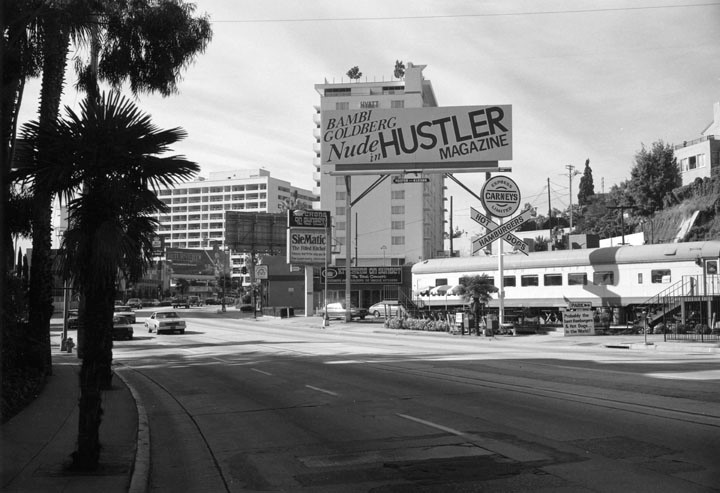 |
|
| (1983)* - A view of Sunset Boulevard showing Carneys Diner, located at 8351 Sunset Blvd with large billboard advertising Hustler Magazine in the background. |
Historical Notes Carneys first opened its doors in 1968. John Wolfe Sr., a local radio executive, decided to build his burger joint from two aging Union Pacific rail cars. Carneys quickly became a landmark on the Sunset Strip, specializing in Hot Dogs and Hamburgers. |
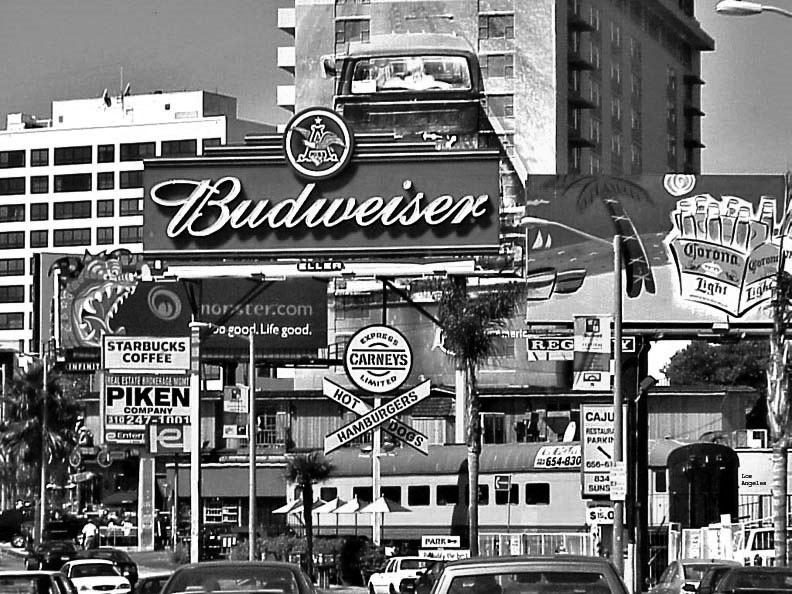 |
|
| (2001)* - A potpourri of billboards surround Carneys Diner on the Sunset Strip in West Hollywood. Photo courtesy of Wikipedia Commons |
Tower Records
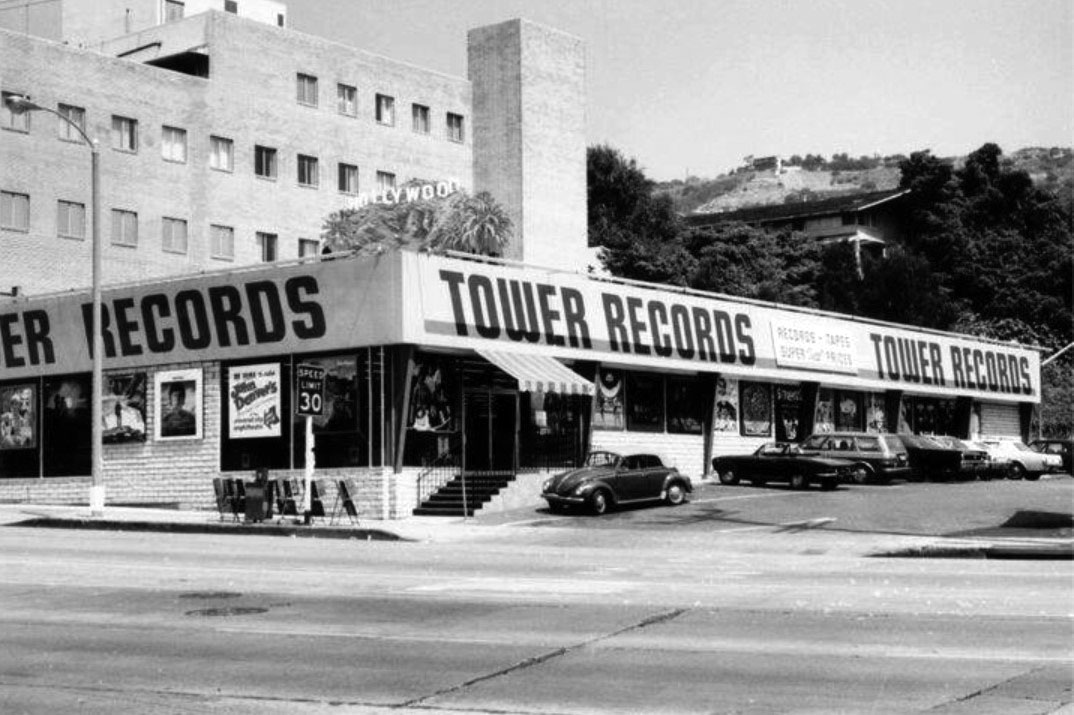 |
|
| (1970s)##^* – View showing Tower Records on the north side of Sunset with the Hollywood Hills in the background. |
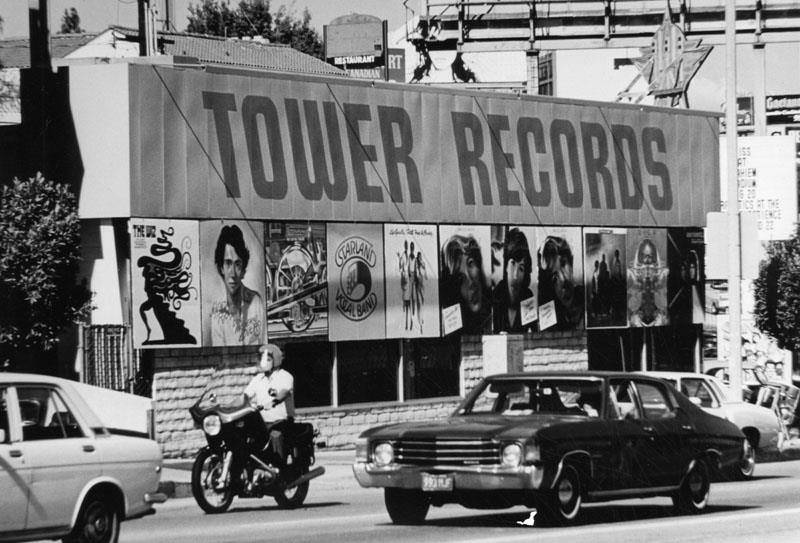 |
|
| (ca. 1980)* - Record albums are promoted outside a Tower Records music store on the Strip near San Vicente Boulevard. Sunset's Strip enclave was a nucleus for album production and promotion for America's popular music buffs. |
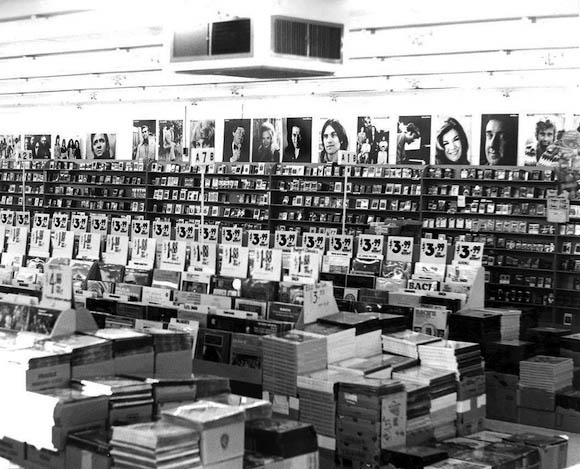 |
|
| (ca. 1970s)*#*#* - Interior view of Tower Records on Sunset Boulevard in West Hollywood. |
Historical Notes The 1974 “Guinness Book of World Records” listed the Tower Sunset location as the “largest record store in the world.” Known for its deep inventory of records – not just current albums, but older albums as well as obscure albums – Tower Records became a destination for music lovers. People were known to spend hours going through the bins.*#*#* |
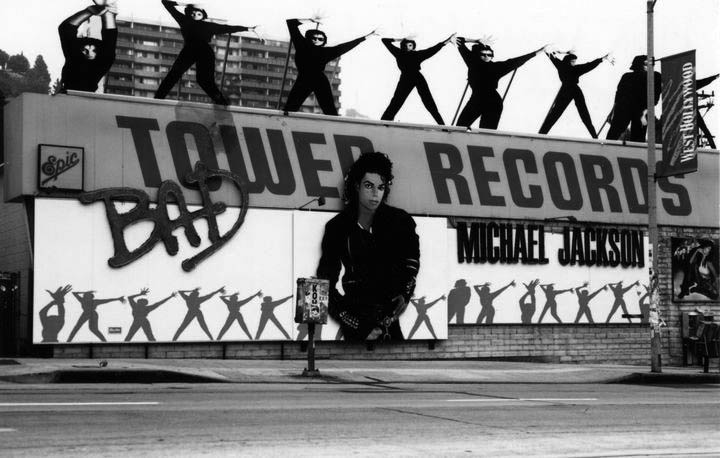 |
|
| (1988)**^^^ – View of the iconic Tower Records Building at 8801 Sunset Boulevard with an image of Michael Jackson on its front face. |
Historical Notes Tower Records became the place where record companies debuted albums, frequently holding album release parties on site with artists signing autographs. Sometimes, artists would perform concerts in the store or in the parking lot. In 2006, the Tower chain declared bankruptcy and the Tower Sunset location closed. The clothing and gift store, Live! on Sunset operated out of the building for five years after that, closing in November 2012.*#*#* |
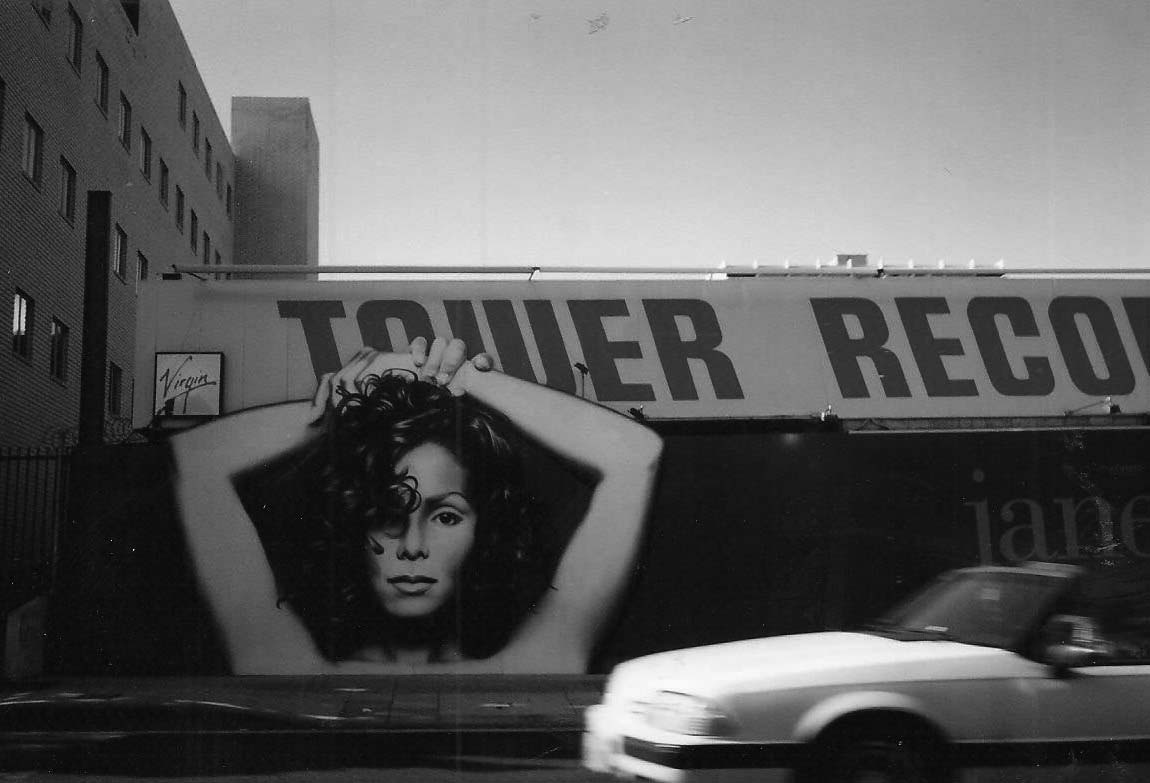 |
|
| (1993)* – Image of Janet Jackson on front face of Tower Records advertising here newly released phenomenal album, "janet." |
Historical Notes In Feb , 2022 the iconic Tower Records building was demolished. Here's the Tower building (8801 Sunset Blvd) history timeline |
* * * * * |
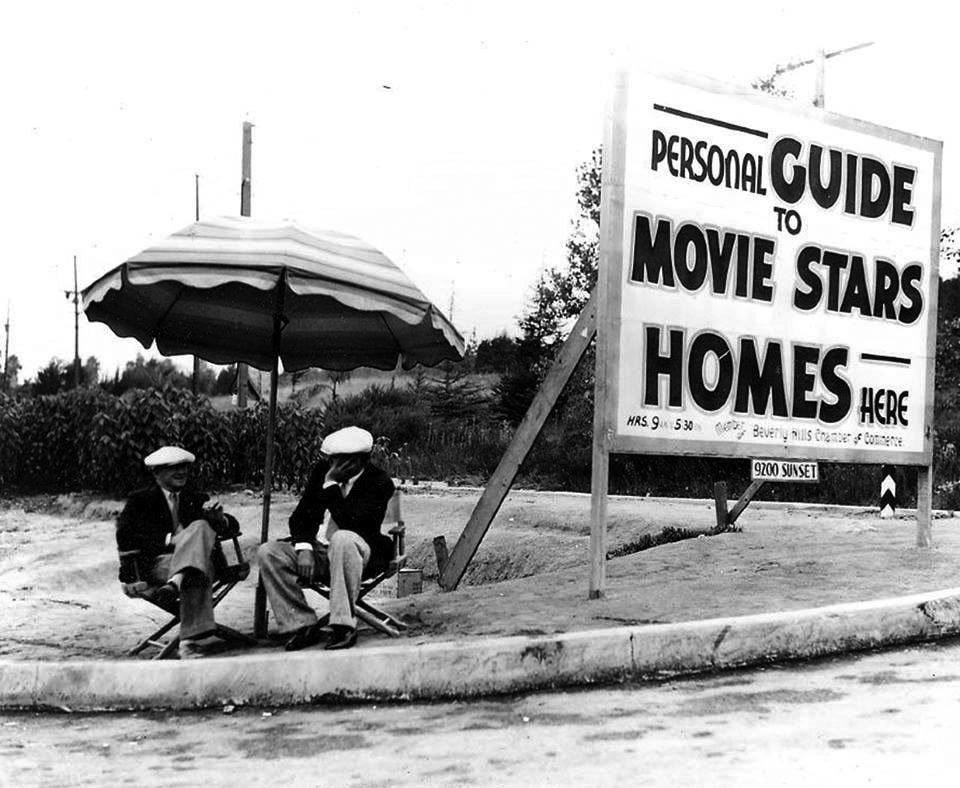 |
|
| (1935)^*^# – View showing two Hollywood tour guides at work. The address on the sign reads 9200 Sunset Boulevard, which happens to be the address of the BOA Steakhouse today. |
Historical Notes Southern California is renowned for its many celebrity estates, and driving through Hollywood, West Hollywood, and Beverly Hills looking for the stars' homes is now a time-honored tradition and a favorite pastime of tourists. |
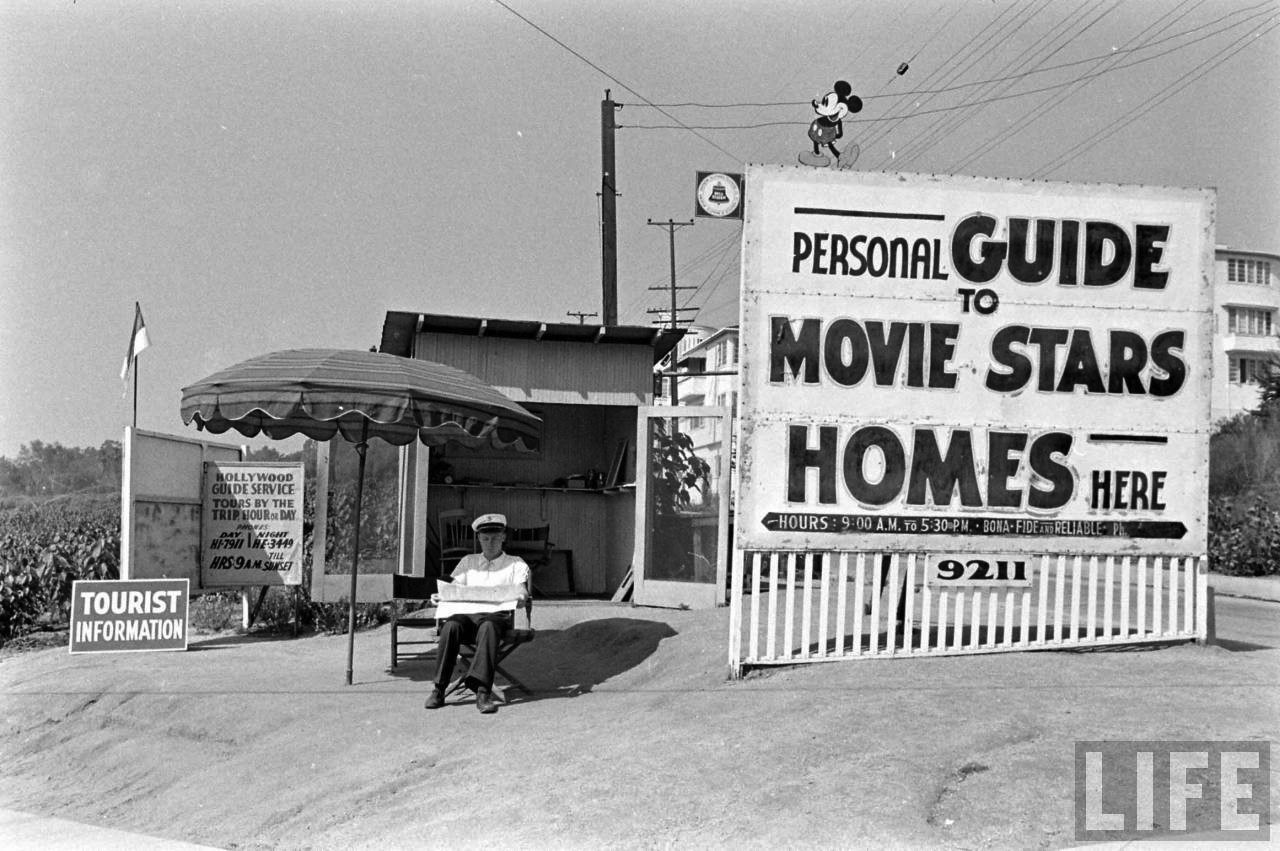 |
|
| (1938)^^++ – Life Magazine photo showing a tour guide looking at what appears to be a map while sitting in front of his office booth at 9211 Sunset Boulevard, near Doheny Rd. |
* * * * * |
Please Support Our CauseWater and Power Associates, Inc. is a non-profit, public service organization dedicated to preserving historical records and photos. Your generosity allows us to continue to disseminate knowledge of the rich and diverse multicultural history of the greater Los Angeles area; to serve as a resource of historical information; and to assist in the preservation of the city's historic records. |
More Historical Early Views
Newest Additions
Early LA Buildings and City Views
History of Water and Electricity in Los Angeles
* * * * * |
References and Credits
* LA Public Library Image Archive
^* California Historic Landmark Listing (Los Angeles)
^ California Historical Society Digital Archive
** Retronaut - Hollywoodland Sign
#^WhitleyHeights.org: Aerial of Cahuenga; Whitley Heights Aerial
#+LA Weekly: Laurel Canyon Country Store
***The Story of Hollywood by Gregory Paul Williams
^^^California State Library Image Archive
^**Huntington Digital Library Archive
**^Table Magazine: LA Observatory
^++Sunset Plaza
+++The WeHo Ho: An Insider's Guide to West Hollywood; La Cienega Lanes
**#Beguiling Hollywood: The Hollywood Hotel
^^#LA Times: Hollywood Citizens News Building; Marlboro Man Signboard; Mark C. Bloome
+^#Facebook.com: Hidden Los Angeles
*#*Elvis Blog
#^^Hollywood Walk of Fame Historic Buildings
#++GoCalifornia.about.com: Sunset Strip
#^*Pinterest.com: Old Hollywood; Los Angeles
#^# DWP - LA Public Library Image Archive
##*The Daily Mirror: Garden Court Apartments
##+Facebook.com: Greenblatt's Deli
*^*MTA Transportation and Research Library Archives
*^^Nuestra Señora la Reina de los Ángeles - losangelespast.com
^^*Cinema Treasures: Vogue Theater; Pantages Theater; Iris Theatre; Marcal - World Theatre
*^*^YMCA Hollywood - paulwilliamspoject.org
*^^*Vintage Los Angeles: Facebook.com: Lucy/Holden; Villa Nova; Sunset Tower Apartments; Earl Carroll Revolving Stage; Schwabs Sunset; Player's Club
^*^^Pomona Public Library Poscard Collection
^^^^Water and Power Associates
^*^#Facebook.com - Bizzare Los Angeles
^^^#KCET: How the Town of Sherman Became West Hollywood; The Player's on the Sunset Strip; L.A.'s First Freeways
^^++Life Magazine
++^^RockCellar Magazine: Sunset Strip
^+++Brucebase: The Roxy Theatre
+++#Go-Go Notebook.com: Flipper's Roller Derby Palace
***^Pinterest.com: Bertrand Lacheze; Vintage Los Angeles: Sunset Strip; Trocadero Nightclub
^**^Griffith Observatory: laparks.org
**##MartinTurnbull.com: The Players; Hollywood-Western Building; Earl Carroll Theater; Sherry's Restaurant; Hollywood and Highland
^^##Alison Martino's Vintage Los Angeles: Wallichs Music City; The Villa Nova
#+#+Facebook.com
#+++TheSunsetStrip.com: Sunset Plaza
^##*Flickr.com: Michael Ryerson; Bill Badzo
^#^^Facebook.com - Vintage LA: 1968 Sunset Strip; Yellow Submarine; 1984 Sunset Strip
^^#*Flickr.com: Elizabeth Fuller
*#*#Facebook.com - Great Photos from Los Angeles's Past: Players Nightclub
*^#*Calisphere: University of California Image Archive
*^^#Mt. Hollywood - Small Mountain, Big Dreams
*^##OAC - Online Archive of California
#**#Facebook.com: Garden of Allah Novels, Martin Turnbull
#*^#Historic Hollywood Theatres: Grauman's Chinese Theatre
#^**The Go Go's: Local Coffee Shops and Diners; PJ's Nightclub
#^^#The Rise and Fall of Dino's Lodge by Kliph Nesteroff
#^##ShareTV.com: 77 Sunset Strip
##^*Facebook.com: Classic Hollywood-Los Angeles-SFV
*###Google Maps
###*GoLosAngeles.abouttcom: History of the Sunset Strip
###+The Guardian: Anarchy on Sunset Strip
####Neatorama.com: Dean Martin and Jerry Lewis Restaurant Owners
#^#*Pinterest.com: Rock'n'Roll & Boogie Woogie
**^**Los Angeles City Historical Society
***^^Oldshowbiz.tmblr.com: Crescendo Club
***##Googie Architecture
**^^^Pinterest.com: Sunset Strip
*^^^^SeriousEats.com: Carneys Diner
*^*^*Blogspot.com: It's a wrap - USA/Mexico - Mel's Drive-In
*^#^*Vintage Everyday
*^*^^Crescendo GNP
^*^*^Go Los Angeles About.com: Sunset Strip
^***^Flickr.com: gsjansen
*^^^*RareMaps.com
^#*#^Private Los Angeles Tours: Ciro's Nightclub
^#^#^LA Curbed: Sunset's Tower Records
*#*#*wehoville.com: Tower Records
*# Skyscraperage.com. - Griffith Observatory; Elvis at Knickerbocker Hotel; Gruen Sign; Garden Court Apartments; Mt. Hollywood; Ben-Hur Coffee; Sherry's Restaurant; Griffith Observatory; Sunset Strip 1960s; Cahunega and Highland Intersection ca1937; Googie's; Selma and Argyle
*^ Wikipedia: Hollywood; Hollywood Athletic Club; Hollywood Bowl; Grauman's Chinese Theatre; Grauman's Egyptian Theatre; Pantages Theatre (Hollywood); John Hanson Ford Theatre; 20th Century Fox; Samuel Goldwyn.Studio; Barnsdall Art Park; Greek Theatre; Griffith Observatory; Cinerama Dome; Ralphs; Hollywood Palladium; Hollywood and Vine; Hollywood Masonic Temple; Hollywood Pacific Theatre; Max Factor; West Hollywood; Brown Derby; Hollywood Christmas Parade; The Hollywood Hotel; Cord Automobile: Sunset Tower; West Coast Radio City - Los Angeles; Earl Carroll Theater; Cafe Trocadero; Breakfast in Hollywood; Whitley Heights; Hollywood Christmas Parade; Garden Court Apartments; Chili Bowl Restaurant - Art Whizin; The Hillview; Paramount Studios; Hollywood Freeway; Hollywood Roosevelt Hotel; J. J. Newberry; Claudette Colbert; Whisky A Go-Go; Gazzari's; The Whtie Parade; The Troubador; Starwood Club; Hollywood Post Office; Chubby Checker; Decoration Day; 77 Sunset Strip; Chateau Marmont Hotel; The Doors; The Comedy Store; Ciro's Nightclub; The Ravenswood; Googie Architecture; Charlie Chaplin; Doheny Drive; Shirley Temple
< Back
Menu
- Home
- Mission
- Museum
- Major Efforts
- Recent Newsletters
- Historical Op Ed Pieces
- Board Officers and Directors
- Mulholland/McCarthy Service Awards
- Positions on Owens Valley and the City of Los Angeles Issues
- Legislative Positions on
Water Issues
- Legislative Positions on
Energy Issues
- Membership
- Contact Us
- Search Index